ANNUAL SHOW ISSUE

Pros’ Test-Prep Strategies (p. 34)
Dr. Hilary Clayton: Can a Horse Be Made Truly Symmetrical? (p. 24)

Try This at Home: Top Takeaways from the USDF Trainers Conference (p. 48)
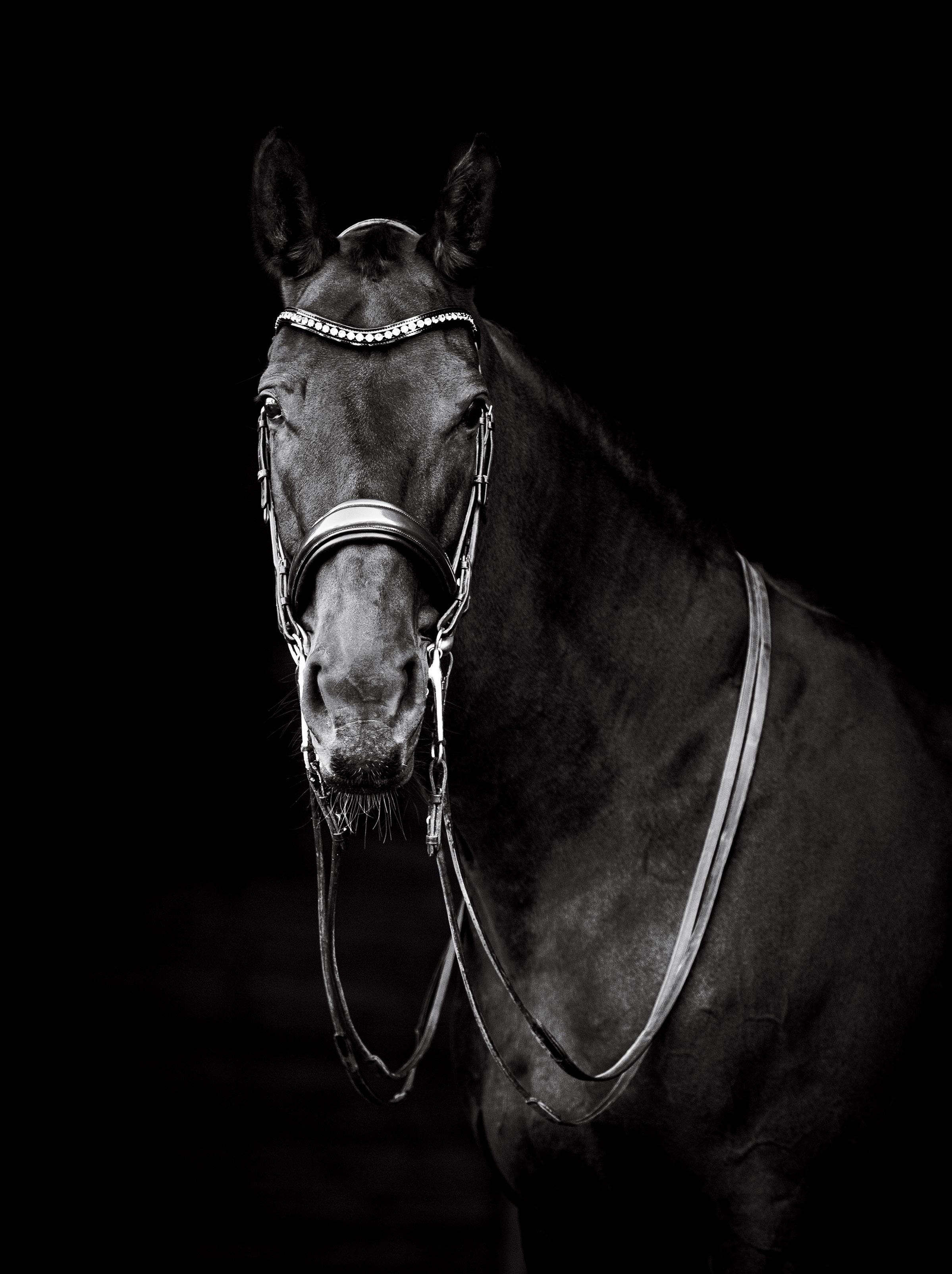
May/June 2023 Official Publication of the United States Dressage Federation
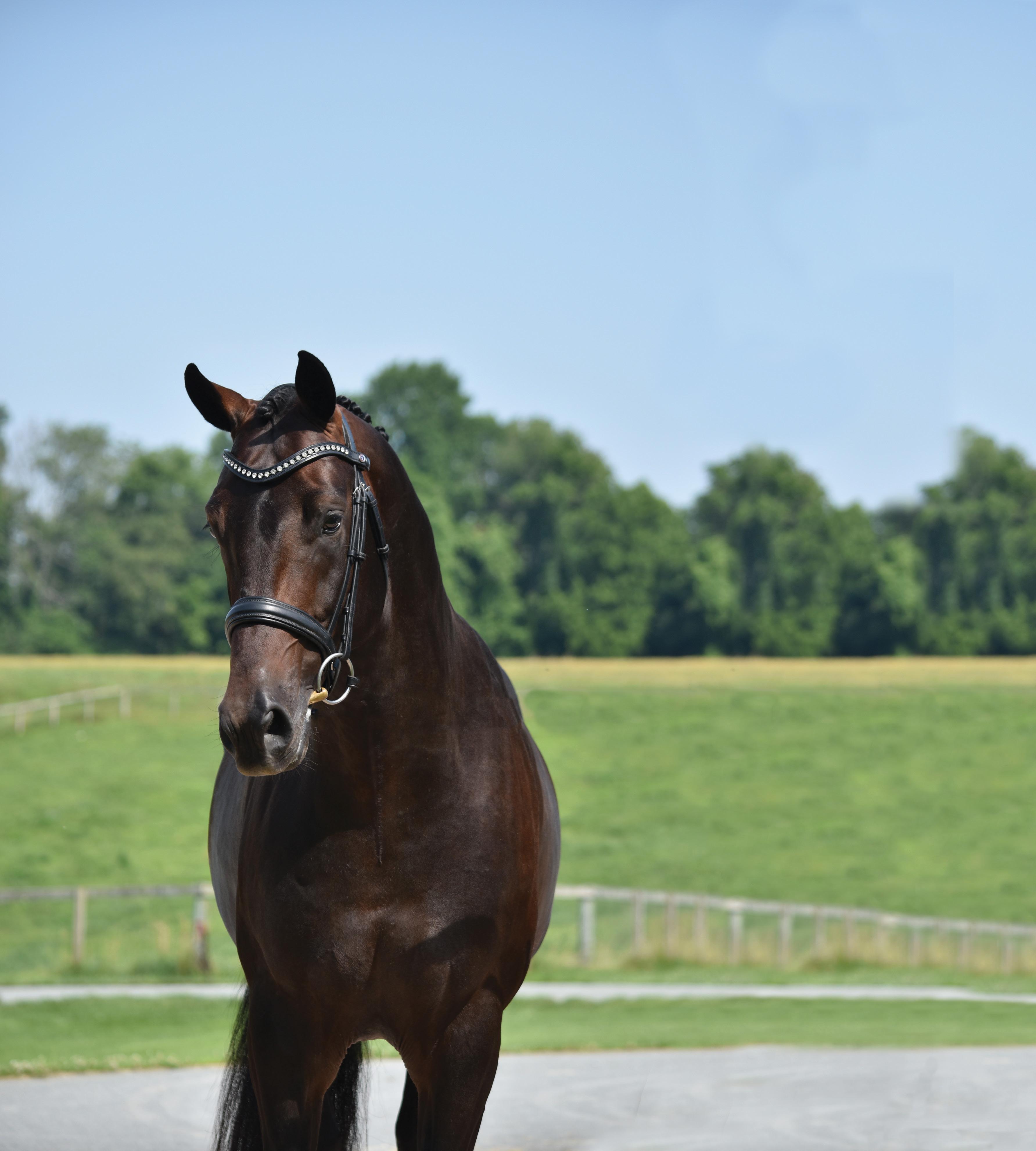








Breeding Training Sales FÜRST GRIBALDI Fürstenball - Gribaldi SIR REAL Sir Donnerhall I - Fürst Heinrich I HARVEST Connaisseur - Ulft hilltopfarminc.com Ph: 410.658.9898 Email: breeding@hilltopfarminc.com Visit us online to choose your favorite stallion LOUISVILLE HTF Lord Leatherdale - Negro
Photo Lindsay Berreth for The Chronicle of the Horse
Conklin
Susan J. Stickle


YourDressage delivers exclusive dressage stories, editorial, and education, relevant to ALL dressage enthusiasts and is your daily source for dressage!
Look for these featured articles online at YourDressage.org

EDUCATION
“2023 Adequan®/USDF FEI-Level Trainers Conference Takeaways”
USDF Silver and Bronze Medalist and USDF L Graduate with Distinction, Megan Compton, shares her top takeaways from this one-of-a-kind educational event.
COMPETITION
A Region 3 rider in her 70s overcomes two hip surgeries to become a champion with her 15 hand Lusitano.
ACHIEVEMENT
“Reclaiming
An equestrian in Region 1 shares how sometimes the most challenging horse can also be the greatest gift you can be given.

COMMUNITY
Meet JB the Standardbred, an extremely versatile horse who busts myths and makes new fans wherever he goes.
It’s YourDressage, be a part of it! Visit https://yourdressage.org/ for all these stories & much more!
USDF CONNECTION
The Official Publication of the United States Dressage Federation
EXECUTIVE DIRECTOR Stephan Hienzsch (859) 271-7887 • stephh1enz@usdf.org
EDITOR Jennifer O. Bryant (610) 344-0116 • jbryant@usdf.org
CONTRIBUTING EDITOR Hilary M. Clayton, BVMS, PhD, MRCVS EDITORIAL ADVISORS
Margaret Freeman (NC), Anne Gribbons (FL), Roberta Williams (FL), Terry Wilson (CA)
TECHNICAL ADVISORS Janine Malone, Lisa Gorretta, Elisabeth Williams
SENIOR PUBLICATIONS COORDINATOR Emily Koenig (859) 271-7883 • ekoenig@usdf.org
GRAPHIC & MULTIMEDIA COORDINATOR Katie Lewis (859) 271-7881 • klewis@usdf.org
ADVERTISING SALES REPRESENTATIVE Danielle Titland (720) 300-2266 • dtitland@usdf.org
USDF OFFICERS AND EXECUTIVE BOARD
PRESIDENT GEORGE WILLIAMS 421 Park Forest Way, Wellington, FL 33414 (937) 603-9134 • president@usdf.org
VICE PRESIDENT KEVIN REINIG, 6907 Lindero Lane, Rancho Murieta, CA 95683 (916) 616-4581 • vicepresident@usdf.org
SECRETARY DEBRA REINHARDT 16305 63rd Road N, Loxahatchee, FL 33470 (203) 264-2148 • secretary@usdf.org
TREASURER LORRAINE MUSSELMAN 7538 NC 39 Hwy, Zebulon, NC 27497 (919) 218-6802 • treasurer@usdf.org
REGIONAL DIRECTORS
REGION 1 DC, DE, MD, NC, NJ, PA, VA
BETTINA G. LONGAKER 8246 Open Gate Road, Gordonsville, VA 22942 (540) 832-7611 • region1dir@usdf.org
REGION 2 IL, IN, KY, MI, OH, WV, WI
DEBBY SAVAGE 7011 Cobblestone Lane, Mentor, OH 44060 (908) 892-5335 • region2dir@usdf.org
REGION 3 AL, FL, GA, SC, TN
CHARLOTTE TRENTELMAN P.O. Box 381, Anthony, FL 32617 (352) 598-7704 • region3dir@usdf.org
REGION 4 IA, KS, MN, MO, NE, ND, SD
ANNE SUSHKO 1942 Clifford Street, Dubuque, IA 52002 (563) 580-0510 • region4dir@usdf.org
REGION 5 AZ, CO, E. MT, NM, UT, W. TX, WY
HEATHER PETERSEN 22750 County Road 37, Elbert, CO 80106 (303) 648-3164 • region5dir@usdf.org
REGION 6 AK, ID, W. MT, OR, WA
NOAH RATTNER 25033 SW Pacific Hwy, Sherwood, OR 97140 (503) 449-1274 • region6dir@usdf.org
REGION 7 CA, HI, NV
CAROL TICE 31895 Nicolas Road, Temecula, CA 92591 (714) 514-5606 • region7dir@usdf.org
REGION 8 CT, MA, ME, NH, NY, RI, VT
HELEN VAN DER VOORT 8 Boulevard West, PH4, Pelham, NY 10803 (917) 834-2635 • region8dir@usdf.org
REGION 9 AR, LA, MS, OK, TX
BESS BRUTON 5696 Piper Lane, College Station, TX 77845 (662) 702-9854 • region9dir@usdf.org
AT-LARGE DIRECTORS
ACTIVITIES COUNCIL
SUE MANDAS 9508 Bridlewood Trail, Dayton, OH 45458 (937) 272-9068 • ald-activities@usdf.org
ADMINISTRATIVE COUNCIL
BARBARA CADWELL 324 Benjamin Street, Fernandina Beach, FL (715) 350 1967 • ald-administrative@usdf.org
TECHNICAL COUNCIL
SUE MCKEOWN 6 Whitehaven Lane, Worcester, MA 01609 (508) 459-9209 • ald-technical@usdf.org
USDF Connection is published bimonthly by the United States Dressage Federation, 4051 Iron Works Parkway, Lexington, KY 40511. Phone: 859/971-2277. Fax: 859/971-7722. E-mail: usdressage@usdf.org, Web site: www. usdf.org. USDF members receive USDF Connection as a membership benefit, paid by membership dues. Copyright © 2023 USDF. All rights reserved.
USDF reserves the right to refuse any advertising or copy that is deemed unsuitable for USDF and its policies. Excluding advertisements, all photos with mounted riders must have safety head gear or USEF-approved competition hat. USDF assumes no responsibility for the claims made in advertisements. Statements of fact and opinion are those of the experts consulted and authors, and do not necessarily reflect the opinions of the editors or the policy of USDF.
The publishers reserve the right to reject any advertising deemed unsuitable for USDF, as well as the right to reject or edit any manuscripts received for publication. USDF assumes no responsibility for unsolicited material. All materials must be accompanied by a self-addressed, stamped envelope.
Questions about your subscription or change in address? Contact USDF Membership Department, 859/971-2277, or usdressage@usdf.org.
POSTMASTER: SEND ADDRESS CHANGES TO: USDF, 4051 IRON WORKS PARKWAY, LEXINGTON, KY 40511. Canadian Agreement No. 1741527. Canada return address: Station A, P.O. Box 54, Windsor, Ontario N9A 6J5.
2 May/June 2023 | USDF CONNECTION
“Centauro – My Little Champion”
Joy”
“The Standardbred That Can Wear Any Bridle”
An official property of the United States Dressage Federation
DeFee Mendik
Sometimes, success in dressage is about hard work. It can also be about seizing opportunities.
 O.
O.
Columns
Departments
Basics
The members of the FEI Judges Supervisory Panel were discerning critics at the 2023 Adequan®/USDF
Trainers Conference, but their motivation is love of the horse and the sport
By Jennifer O. Bryant
USDF CONNECTION | May/June 2023 3
Inside USDF Hello from a Newly Elected Regional Director (NERD) By Charlotte Trentelman 6 Ringside Mindfulness Meditation By Jennifer
Bryant
4
O.
20 The Judge’s Box All About Travers and Renvers By Jayne Ayers 24 Sport Horse The Science of Symmetry By Hilary M. Clayton, BVMS, PhD, Dipl. ACVSMR, FRCVS 28 GMO Take Your Best Shot By Penny Hawes 58 Tack Shop A Green Spring 64 Salute Down to Earth By Katherine Walcott
8 Contact 10 Sponsor Spotlight 11 Collection 60 Rider’s Market 62 USDF Connection Submission Guidelines 62 USDF Office Contact Directory 63 Advertising Index On Our Cover Looking show-ring ready is the Dutch Warmblood/Thoroughbred mare Decadence, owned and ridden by Joan Claypool Sly of Oregon. Photo by Mary Cornelius.
Test-prep strategies
show-ring success
Features 34 Practice Makes Perfect (Well, Almost)
for
By Natalie
40 The Winding Path
By Jennifer
Bryant 48 Tough Love
FEI-Level
Connection MAY/JUNE 2023 Volume 25, Number 1 48
USDF
Hello from a Newly Elected Regional Director (NERD)
Region 3’s new director has a proud record of USDF volunteerism
 By Charlotte Trentelman, Region 3 Director
By Charlotte Trentelman, Region 3 Director
Iwas born in Concord, Massachusetts, and grew up in a rural neighborhood. To my sadness, the houses were too close together to use our garage as a barn for the horse that I dreamed of having. My older sister rode. If I was lucky, I got to go to the barn and pet noses.
When my father retired, he moved our family to Florida. My sister gave up riding for boys. I was told, “When you are old enough to pay for lessons, you can ride.”
That’s probably why I’m writing this today.
While attending the University of Florida, my boyfriend, Chris, and I would take trail rides on livery horses. He’d never been on a horse, but he was pretty game.
In December 1971, I did three things in 30 days: graduated, got married, and bought a horse. One horse led to another. Chris and I settled in Ocala, where having some connection to the horse industry was an asset. I showed hunters and competed in the Arabian division, where I saw my first dressage test.
Somewhere along the line, we bought 20 completely bare acres. We developed the land into Rebel Ridge, a teaching and training facility for winter boarders. We hosted multiple clinicians as well as some of the early USDF Instructor/Trainer and L Programs. I’m a proud graduate of one of those early L programs. My US Equestrian “r’ judge-licensing program in California was the last one that candidates could take if they hadn’t completed the L. I’m living proof that the L program does give the education needed for success.
(I’ve been a USEF “S” judge since 2003.)
Because of my experience serving as secretary for local hunter shows, I was asked if I could put on a dressage show in our back field. Soon Chris and I were managing recognized shows, and Marion Saddle Club Dressage was one of the first shows on the Florida dressage circuit. We continued for 10 years.
In the mid-1980s, I was invited to Houston for a USDF convention. It was one of the most eye-opening events of my life. I discovered that all of us attendees spoke the same “language,” but we didn’t always have the same interpretation. Show-management meetings were fascinating, and I heard new ideas. There were people at the competitor meetings that I’d read about in magazines. There was so much to do and so many people to meet, some of whom became lifelong friends. Chris and I have not missed a USDF convention since.
As a result of my experiences at
those early conventions, I became involved with USDF governance. I served two terms as Region 3 director, from 1989 to 1995, and I also became a USEF dressage technical delegate. During that time, the USDF Executive Board developed the USDF National Symposium concept along with the Roemer Foundation/USDF Hall of Fame and the USDF Historical Recognition Committee (the latter of which I chaired from 2017 through 2022)— two achievements that I was most proud of.
I joined the Executive Board because we have to participate, or we lose our voice. I am a true believer in education as the way to progress. This country is so vast; we need to see the big picture and realize the complexity of staying together on a national scale. We sometimes don’t understand problems in other regions, or even in other states within our own regions.
With Region 3 director Sue Bender stepping down at the end of 2022, I decided to run for the open seat. Why did I come back? When I judge, I often run into people I met decades ago who are still teaching and training. I want to see our sport and the USDF grow by reaching out to longtime members and by inspiring new members to participate. We have to find both and bring them together. Our job is getting bigger and bigger, but I believe we have the human resources to keep pace with the growth of our sport.
Why did I come back? What a silly question!
I never left.
4 May/June 2023 | USDF CONNECTION
Inside USDF
USDF 2023 Member Perks Partners
Discounts available to 2023 USDF members
DressageClinic.com
Educational videos from the top dressage trainers around the globe. 50% discount on membership
Dressage Extensions

Luxury dressage boutique certain to delight the most discerning of dressage enthusiasts.
$100 worth of free product by receiving a $50 member card two times per year

Dressage Today OnDemand
Dressage training video library with training advice and tips from the world’s most respected judges and trainers. 45% discount on membership video.dressagetodayonline.com


Horses 4 Your Consideration
The Sport Horse Marketplace for listing your horses, finding your next equine partner, and posting your equestrian business or products locally and globally. USDF Members receive a 15% discount https://www.horses4yc.com/
Horse & Country
H&C is the leading international equestrian sports network, available globally via connected TVs, mobile, and web and on leading digital and pay-TV platforms. USDF Members receive a 15% discount on a subscription for H&C’s annual membership, H&C+ https://horseandcountry.tv/en-us/
Premier Equestrian
Full line of exceptional products including dressage arenas, footing, horse jumps, and barn and stable equipment.
5% discount on all Premier Equestrian items www.dressagearena.net
Printastic
Custom banners to fit every business need, budget, and size. 20% off all orders www.printastic.com

USRider
24/7 nationwide roadside assistance for you and your horse. Join USRider with no activation fee for a savings of $29 off the normal new membership rate www.usrider.org

www.usdf.org/join
Mindfulness Meditation
I’ll take dressage over breathing exercises any day

There’s been a lot of focus lately on the concept of mindfulness meditation as a way of alleviating stress, anxiety, pain, and more. The Mayo Clinic explains the concept of mindfulness meditation as focusing on what you’re sensing or feeling in the moment, without judgment. Many people who practice mindfulness meditation report that, as they concentrate on their breath or on guided imagery, their brains and bodies unwind because the process interrupts their usual thought patterns and daily worries and endless “to-do list” planning.
When I first heard of mindfulness meditation, with its goal of focusing on something else so completely that you’re totally in the moment and all your other cares leave your mind, I thought, Oh, I’ve been doing that for years. It’s called dressage
Maybe it’s because I’m not particularly gifted as an equestrian, but dressage takes 100% of my focus. There is so much to manage—every inch of my own uncooperative body and every inch of my horse’s—that keeping us both on the same sheet of music while simultaneously attempting to produce dressage movements and figures with pinpoint accuracy takes every brain cell I can muster. The effort consumes me: After an intense training session or dressage test, I am quite literally drained.
But it’s (usually) a good feeling, and afterward I’m pleasantly tired—or exhilarated, until I crash—with a feeling of pleasant physical fatigue along with a sense of mental release and reset.
Nothing else I do demands nearly as much focus as dressage. I can’t seem to get my Zen on through traditional mindfulness means, as I tend to be hyper-focused on my own emotional and physical state already, frequently to my detriment. But dressage does it for me every time— or should I say, if it doesn’t, that’s a red flag that something about my riding needs attention.
If I’m not in the zone when I’m riding—if I keep one ear pricked for outside stimuli, say, or I realize I’m noticing the spectators and the surroundings when I’m in the show ring—something’s wrong. It’s an unfailing sign that some part of me is worried about something, whether it’s because I’m not really comfortable showing at the level; because I’ve allowed myself to get caught up in fretting about the other competitors, or the weather,
or something else I can’t control; or because on some level I don’t entirely trust my horse and I’m worried about what he might do. When that on-edge-ness creeps in, no amount of breathing exercises or mental rehearsal can save me. I have to take my unfocused, jangled state as a sign that I need to go home, dig down, and discover the underlying issue so I can address it. Otherwise it’s going to stay with me like a recurring unpleasant dream (and occasionally it actually does manifest as a bad dream).
But when I get my issues sorted out, and I’m riding as if it’s just my horse and me no matter who’s watching, and as if there’s nobody and nothing else in the world outside this sandbox, that’s therapy and mindfulness meditation like none other. That “flow state” is the dressage equivalent of the famous saying about jumping—that you have to throw your heart over the fence and the horse will follow after. You are your horse, and your horse is you. It’s the best meditation and the best feeling in the world.
Here’s hoping you and I both find ourselves in the zone with our horses this season.
Jennifer O. Bryant, Editor
 MICHAEL BRYANT
MICHAEL BRYANT
6 May/June 2023 | USDF CONNECTION
Ringside

Giving a Leg Up
I don’t think Star uary/February), but the remarkable generosity of the clients at StarWest to help less-affluent riders reach their
goals has been wonderful to see. Horses and clothing and trailer rides are lent. One aspiring young rider had all her entry fees paid for by different clients; she was the runner-up for two years in the competitive Region 2 race to make the FEI North American Youth Championships Young Rider team. It was a great learning experience, and that rider is now an adult client who passes on to others. Many USDF medals, from bronze to gold, have
USDF UNIVERSITY
offers a resource library, online courses, recognition for USDF members who strive to continue their education, and accreditation for educational events.

•Search the education library
•Take online courses

•Earn credits and recognition
www.usdf.org/education/university
been earned on leased schoolmasters.
I know I am hopelessly prejudiced, but I think the helpful attitude is contagious. Years ago, I kept a closet of breeches, coats, boots, and helmets, from primary sizes to adult, to lend or give for that first show without the huge clothing outlay that scared off some parents. Customers were encouraged to pass on outgrown apparel, a custom that continues today.
I am retired now from teaching dressage, but I watch with pride the lengths to which our clients and staff go to to aid kids and adults in pursuing their dreams of competition. Anyone can ride and compete, I have always said, if they have enough desire and work ethic. There are always good-hearted horsemen who understand that desire and who will help out along the way.
Alice E. Martin Founder/owner, StarWest New Berlin, Illinois
USDF Connection welcomes your feedback on magazine content and USDF matters. Send letters to editorial@usdf.org along with your full name, hometown, and state. Letters may be edited for length, clarity, grammar, and style.
Corrections
Two USDF youth-recognition recipients were listed incorrectly in the 2022 USDF yearbook issue of USDF Connection (March/April 2023). The corrected listings are below. USDF regrets the errors.
Youth Dressage Rider Recognition Pin Program Recipients
Second Year Recipient
Sarah Petersen, Elbert, CO
Sixth Year Recipient
Elizabeth Petersen, Elbert, CO
8 May/June 2023 | USDF CONNECTION
Contact January/February 2023 Official Publication of the United States Dressage Federation SPECIAL ANNIVERSARY ISSUE Is This Your Last Issue? (p. 27) USDF CELEBRATES 50 YEARS 1973-2023
UNIVERSITY

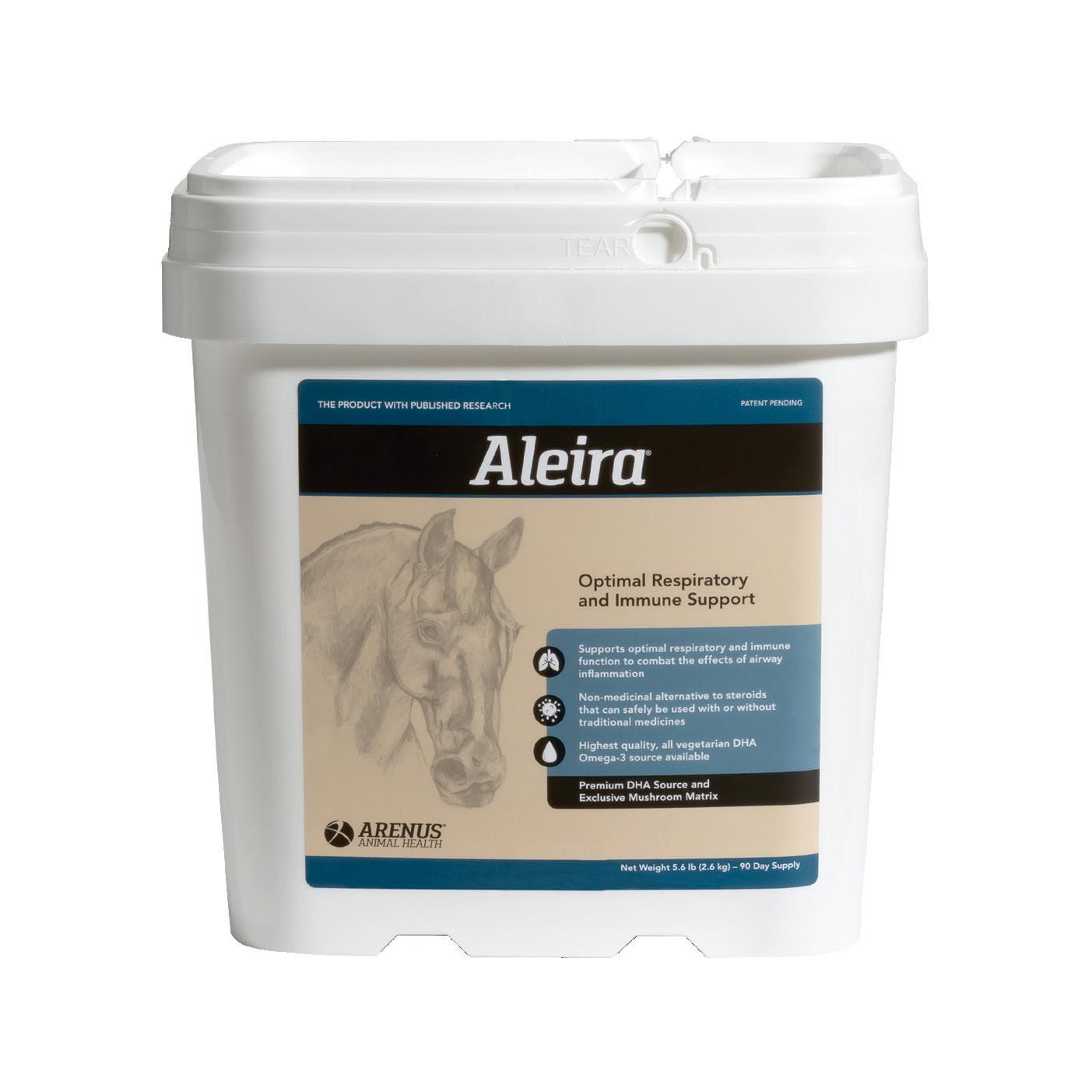


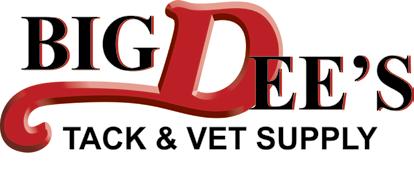





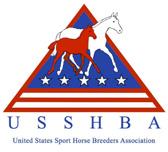
THANK YOU FOR SUPPORTING USDF Official Equine Insurance Provider of USDF Title Sponsor Great American Insurance Group/USDF Regional Dressage Championships Supporting Sponsor US Dressage Finals 800-553-2400 www.platinumperformance.com 800-303-7849 www.dressageextensions.com 402-434-8585 www.dressagefoundation.org 800-611-6109 www.dressagearena.net 800-324-2142 www.bigdweb.com 502-585-3277 sterlingthompson.com Official Joint Therapy Sponsor of USDF Title Sponsor Adequan®/USDF FEI-Level Trainers Conference Annual Convention and Awards Presenting Sponsor US Dressage Finals 800-458-0163 www.adequan.com Official Supplement Feeding System of USDF Presenting Sponsor Great American Insurance Group/USDF Regional Dressage Championships Supporting Sponsor US Dressage Finals Official Supplier Great American Insurance Group/USDF Regional Dressage Championship Jackets 800-461-8898 www.smartpakequine.com USDF Breeders Championship Series THANK YOU TO OUR SPONSORS.
Collection
Bits and Pieces from USDF and the World of Dressage

★ Helmet Safety Recall ★ Debbie McDonald Back as Dressage Technical Advisor ★
★ Remembering Elizabeth Madlener, Sharon Poulin ★
USDF CONNECTION | May/June 2023 11
IN
THE FRAME
A hot-air balloon seems to buzz a dressage horse and rider at a Desert International Horse Park show in Thermal, California, winter 2023. Photo by Terri Miller.
SAFETY
Ovation Protégé Helmets Recalled
English Riding Supply, Scranton, Pennsylvania, in conjunction with the US Consumer Product Safety Commission on February 9 issued a recall of approximately 55,000 Ovation Protégé equestrian helmets for failure to meet the impact requirements of ASTM F1163-15. These helmets pose a risk of injury to someone who falls while wearing the helmet.
The recalled helmets were manufactured from December 2020 through December 2022 and offered in multiple colors and finishes. They were sold at equestrian retailers and at Amazon.com and StateLineTack.com from January 2021 through December 2022 for between $58 and $66.
Consumers should immediately stop using the recalled Ovation Protégé helmets. Return your helmet to the retailer from which you purchased it, or to any Ovation authorized dealer, for a free replacement Ovation Deluxe Schooler helmet; or contact English
YOUTH
RECALLED: Ovation Protégé helmet

Riding Supply for a $60 refund. The replacement helmet or refund will be provided on return of the recalled helmet or proof of destruction of the recalled helmet. (Consumers are not required to return the physical helmet to English Riding Supply.)
To learn how to destroy your helmet and receive a refund, or to learn more about the recall, visit OvationRiding.com/ ProtegeRecall/.
Make Your Summer Plans for D4K’s Youth Dressage Festival
The 2023 edition of Dressage4Kids’ flagship competition, the Youth Dressage Festival, will return to HITSon-the-Hudson in Saugerties, New York, August 10-12.

Established in 1999 by Olympian Lendon Gray, the Youth Dressage Festival is the biggest dressage individual and team competition in the US for
riders aged 25 and under, offering competition from Introductory Level through FEI.
The show’s unique format features individual division championships that comprise not only dressage tests, but also equitation and written tests of required reading. In addition, nearly 50 teams typically take part in the Kross Creek Farm Team Championships, which culminate in a celebratory parade of teams. Other classes offered include dressage trail, Prix Caprilli, judging sport-horse conformation, handler, quadrille, and musical freestyle.
Learn more about Dressage4Kids’ Youth Dressage Festival and D4K’s many educational offerings at Dressage4Kids.org.
HIGH PERFORMANCE
USEF Rehires Debbie McDonald as Dressage Technical Advisor
Debbie McDonald, US Equestrian’s (USEF) national dressage technical advisor from 2019 through 2021, has been reengaged in that position.
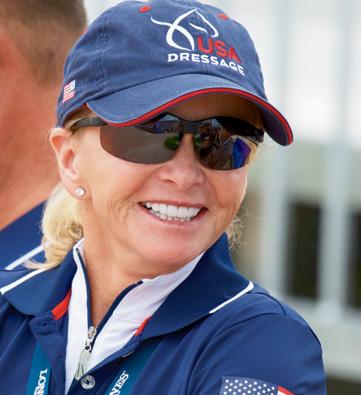
According to USEF’s February 1 announcement, McDonald’s responsibilities “will be designated specifically to training support and working collaboratively with personal coaches over the next 18 months in the lead-up to team selection for the Paris 2024 Olympic Games.”
McDonald served as the US national dressage development coach prior to becoming technical advisor. On her watch, the US dressage team won silver at the 2020 Tokyo Olympic Games, held in 2021.
In December 2021, USEF announced that it was not renewing McDonald’s contract. US national dressage emerging youth coach George Williams was tapped to handle some of the high-performance duties, including serving as the dressage team’s chef d’équipe at the FEI World Dressage Championships Herning 2022.
“I’m so passionate about the potential of our athletes and combinations, and it’s my intention to make sure we’re doing everything we can to produce the absolute best results possible in Paris,” McDonald said of her appointment. “I’m very motivated and feel incredibly supported to help our athletes work toward that goal over the next year and half.”
12 May/June 2023 | USDF CONNECTION ENGLISH RIDING
OF DRESSAGE4KIDS; JENNIFER
Collection
SUPPLY PHOTO; LARA SLOAN/COURTESY
BRYANT
4 KIDS: Dressage4Kids founder Lendon Gray with D4K rider Quentin Sloan in 2019
BACK AT THE HELM: Debbie McDonald has returned to the position she held through 2021
FINANCIAL AID
The Dressage Foundation (TDF)’s Carol Lavell Gifted Memorial Fund for Adult Amateurs—named in memory of Lavell’s legendary 1992 Olympic partner—provides grants of up to $1,500 to enable deserving adultamateur dressage riders to pursue concentrated training with their horses. To learn more, visit DressageFoundation.org. Applications are due September 15.
The 2023 Gifted Fund grant recipients, as chosen from their respective USDF regions, are:
Region 1: Charlene Jensen (VA) is a member of the Virginia Dressage Association and its Southeast chapter. She plans to spend five days training with Jodi Lees.



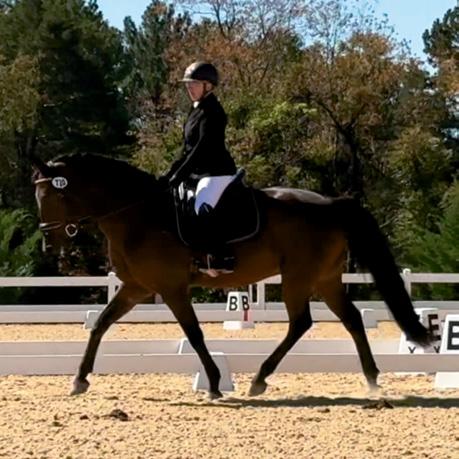
TDF Supports Adult Amateurs
Region 2: Mosie Welch (OH), a member of the Northern Ohio Dressage Association, plans to train with Emily Gill for six days.
Region 2: Jenna Staffaroni (WI), a member of the Wisconsin Dressage and Combined Training Association, will spend eight days training with Nicole Perret.



Region 3: Kathryn Patton (GA), a member of the Georgia Dressage and Combined Training Association, will train with Ange Bean for eight days.
Region 4: Lin Nelson-Mayson (MN), a Central States Dressage and Eventing Association member, will ride with Heather Salden-Kurtz and Kjirsten Lee for six days.
Region 5: Kirsten Romig (NM),
a member of the Paso del Norte Dressage Society, will spend a week training with and shadowing Dr. Bessie Babits.
Region 6: Lea Leathers (ID), the president of the Eastern Idaho Chapter of the Idaho Dressage and Eventing Association, will spend six days training with Nadine Schwartsman.

Region 6: Shonnessy Gilmore (WA), a member of Equestrians’ Institute, will spend eight days working with Patricia “Peaches” Schaefer.
Region 7: Annette Pressas (CA), a California Dressage Society member, will spend five days training with Kristina Harrison-Antell.
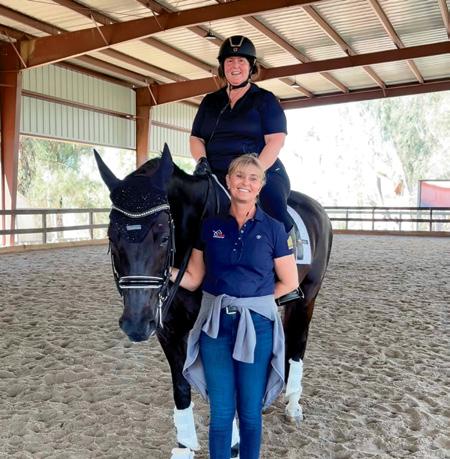
USDF CONNECTION | May/June 2023 13 COURTESY OF CHARLENE JENSEN; COURTESY OF MOSIE WELCH; FRANKE PHOTO DESIGN; MEG MCGUIRE PHOTOGRAPHY; COURTESY OF LIN NELSON-MAYSON; MICHAELA
OF SHONNESSY GILMORE; COURTESY OF ANNETTE
BUENEMANN; KATRINA LEIGH PHOTOGRAPHY; COURTESY
PRESSAS
Charlene Jensen
Mosie Welch
Jenna Staffaroni
Kathryn Patton
Lin Nelson-Mayson
Kristen Romig
Lea Leathers
Shonnessy Gilmore
Annette Pressas with trainer Kristina Harrison-Antell
OUTSTANDING AMATEURS: The 2023 Gifted Fund grant recipients
OBITUARY
Dressage competitor, judge, and instructor/trainer Elizabeth Wilson Madlener, of Martinsburg, West Virginia, died January 9. She was 81.
Born into a military family, Madlener made the most of her father’s posting in Stuttgart, Germany, in 1956. For three years she took dressage and jumping lessons with Martin Hölzel, and she competed successfully with her horse, Frauenjager, earning her German bronze riding medal.
After the family’s return to the US, Madlener attended Old Dominion University in Virginia and took part in hunter/jumper competitions. After graduation she taught high-school English and home economics before marrying and moving to Seattle, where she again took up dressage and purchased

OBITUARY
Dressage competitor, trainer, and judge Sharon Ashton Poulin, matriarch of the Poulin family of successful dressage rider/ trainers, died November 28, 2022, after a long battle with breast cancer. She was 73.
Although her husband, 1992 US Olympic team bronze medalist Michael Poulin, at times received more coverage and attention, Sharon Poulin was an accomplished rider/ trainer in her own right. She was
Elizabeth
Madlener
and her horses won numerous year-end awards and rankings.
Madlener established a training facility at the Maryland Horse Center (later renamed Potomac Horse Center) and served as president of the Maryland Horse Council, and she earned her “S” dressage judge’s license. She penned articles on dressage training for several equestrian magazines.
two off-the-track Thoroughbreds, Gulliver and Jonathan Swift.
In 1978, Madlener went back East to train with then-US dressage team coach Col. Bengt Ljungquist. She was long-listed for the US Equestrian Team from 1977 to 1980,
Sharon Poulin
a USDF bronze, silver, and gold medalist; a USEF “S” dressage judge; and trainer of several horses to Grand Prix. Both technically and emotionally, she supported her husband’s bid to make the 1992 Olympic team with Graf George. She also coached their daughters Katherine and Gwen, both of whom are decorated dressage riders: Both won FEI North American Young Riders Championships (now NAYC) medals in several appearances, and Kate won team gold at the 2007 Pan American Games aboard a horse her parents bred. That horse, Brilliant Too, was sired by the KWPN stallion Brilliant, owned by Michael and Sharon Poulin and trained to Grand Prix by Sharon.
A native of Maine, Sharon Poulin was also the backbone of the family’s dressage operations, which over the years migrated from Maine
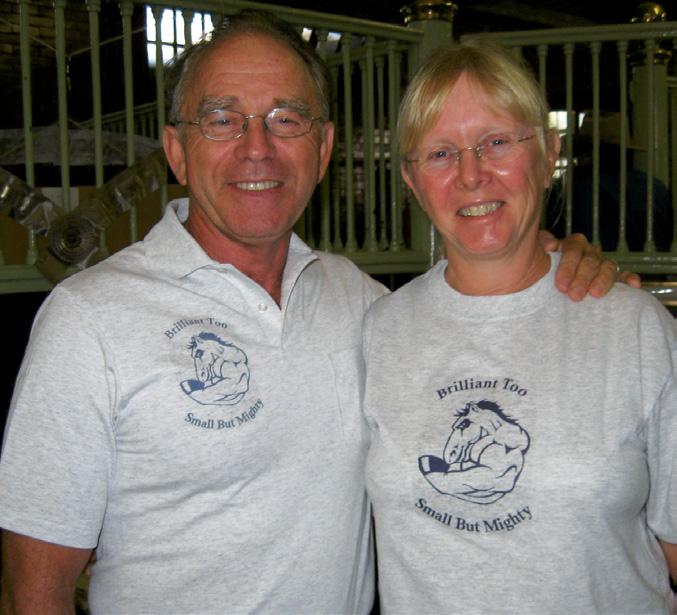
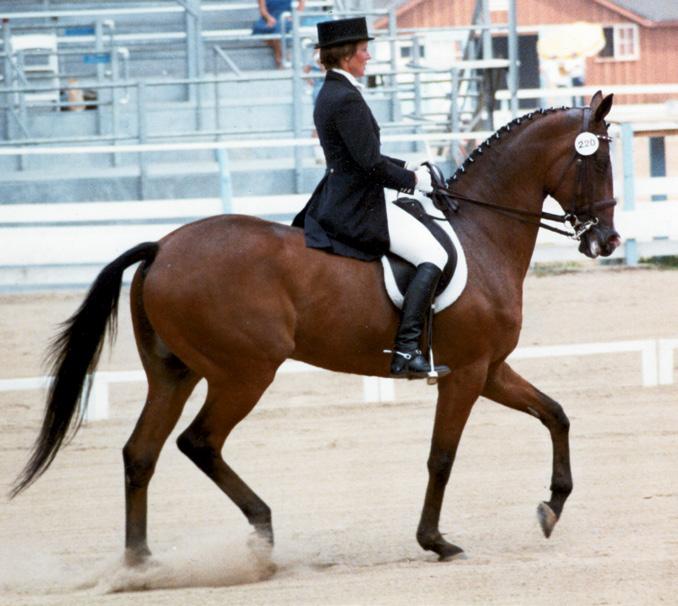
As Madlener’s longtime student Amanda Chambers Harder recalled in a tribute for The Chronicle of the Horse, “Questions and chitchat were not allowed until the end of a lesson. Not all riders appreciated this method, but those who embraced it could experience a profound change in their horse and their understanding of balance, selfcarriage, or a particular movement.”
to DeLeon Springs, Florida. She not only managed the farm but also found time to teach, train, and judge and to help raise Michael’s and her four children (the two eldest, Shannon and Michael, are not involved with horses).
14 May/June 2023 | USDF CONNECTION COURTESY OF STEVE WILSON; SUSANJSTICKLE.COM; COURTESY OF GWEN POULIN Collection
PIONEER: Elizabeth Madlener on her off-thetrack Thoroughbred Jonathan Swift in an undated photo
ACCOMPLISHED: Sharon Poulin competing in 2006
SUPPORTERS: Michael and Sharon Poulin in 2007, wearing T-shirts in support of daughter Kate’s Pan Am Games bid aboard their homebred Brilliant Too
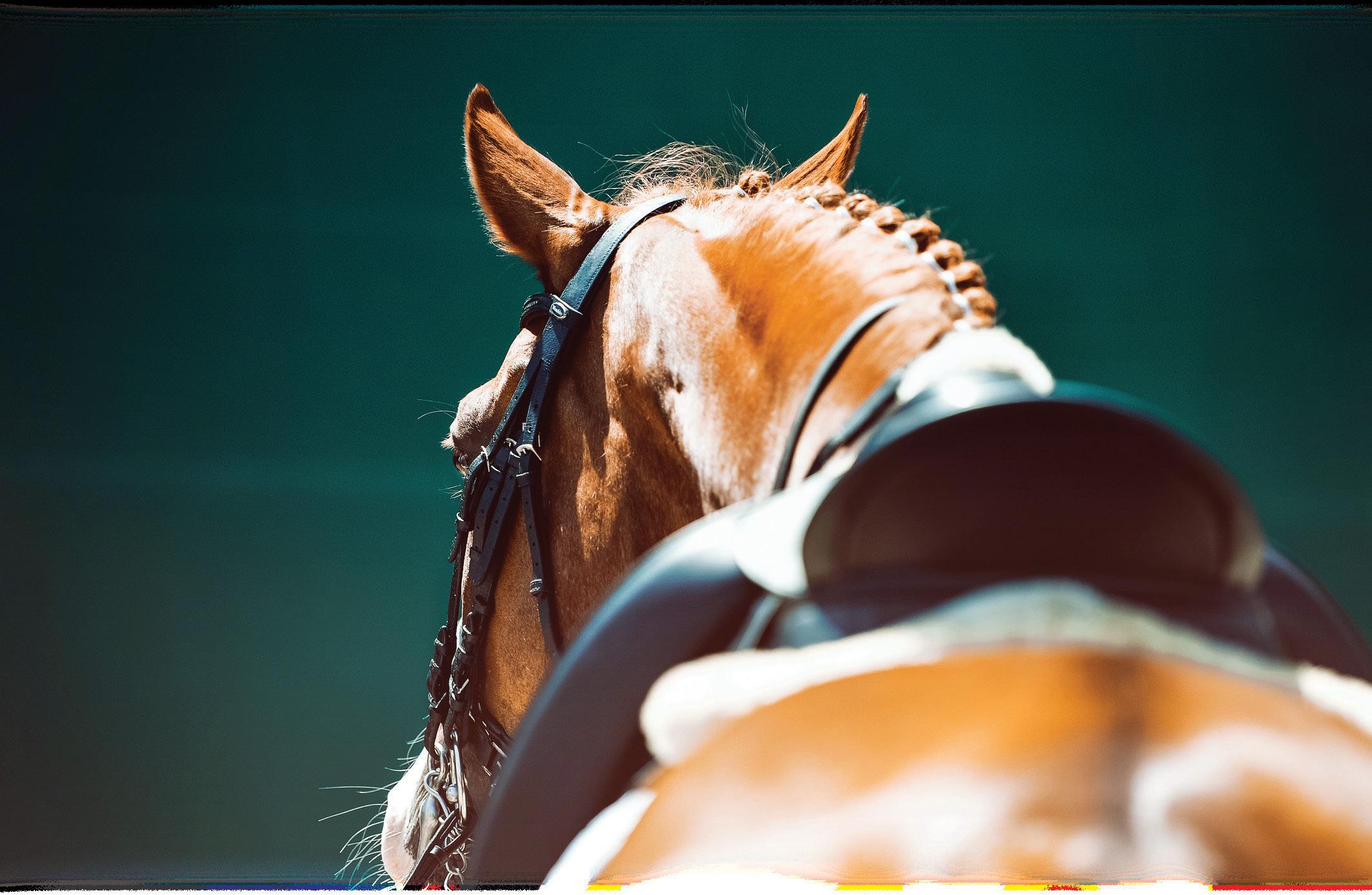
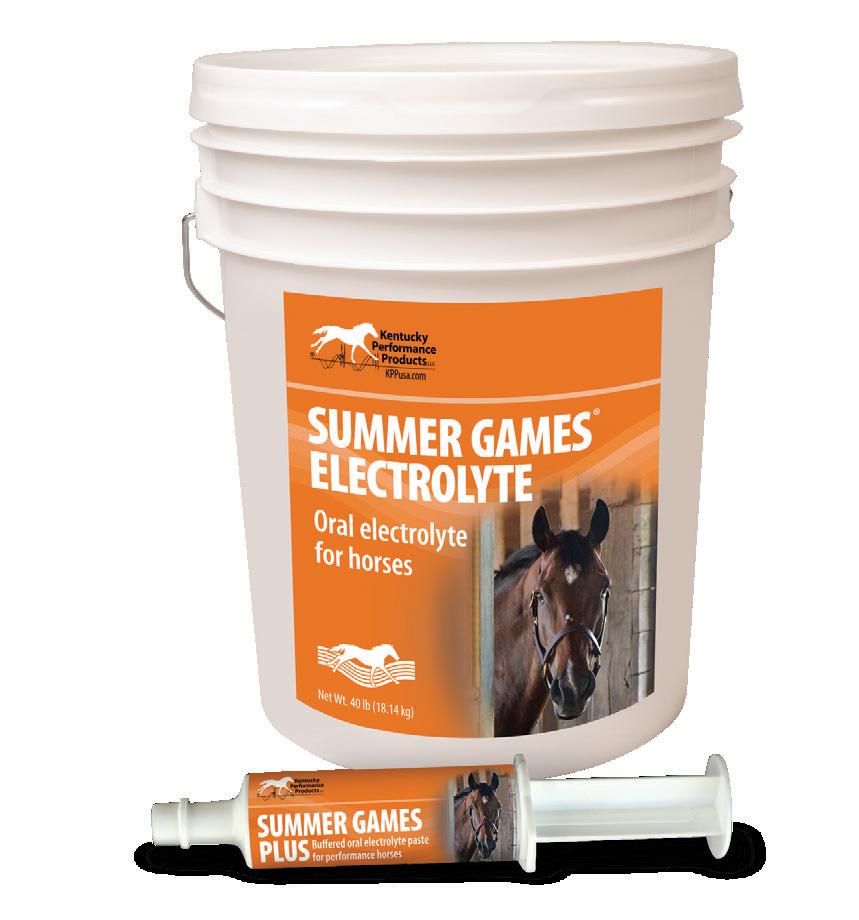
to You Matters to Us® KPPusa.com, 859-873-2974 Challenge: Dehydration, electrolyte depletion Solution: Summer Games® Electrolyte • Replenishes the electrolytes and trace minerals lost during sweating. • Stimulates the thirst response to keep horses drinking. • Supports quick recovery after competing in hot, humid conditions. Satisfaction guaranteed. Simple Solutions, Scientifically Proven ® USDF 2023 May/June
The Horse That Matters
SAVE THE DATE
PARA-EQUESTRIAN New USPEA Grants Honor Hope Hand, Jonathan Wentz

The US Para-Equestrian Association (USPEA) in February announced four new grants for emerging para-dressage athletes, named in memory of two of the sport’s greats: the Hope Hand Memorial Domestic CPEDI1* Equine Travel Grant, the Hope Hand Memorial US Dressage Festival of Champions Equine Travel Grant, the Jonathan Wentz Memorial Emerging Athlete National Show Grant, and the Jonathan Wentz Memorial Initial Classification Travel Grant.
With US Equestrian now offering grants to highperformance paradressage athletes, “it’s allowed USPEA to really focus on new and emerging athletes by assisting them in obtaining their first classification to getting them down center line at their first CPEDI1* competition,” said USPEA interim president Tina Wentz, “as well as encouraging them to participate in their first national championship, which is now part of the US Dressage Festival of Champions.”
Paralympian Hope Hand, who died in June 2022, was the founder of the USPEA, which is the USEF national affiliate para-equestrian organization. Her efforts were instrumental in developing and advancing the sport of para-dressage in the US.

At just 21, Jonathan Wentz established himself as one of the sport’s rising stars when he earned the highest US placing at the 2012 London Paralympic Games para-dressage competition. Sadly, he passed away shortly thereafter, but his achievement and his support of fellow athletes and the para-dressage sport remain inspirational to this day.
For more information about the grants, or to apply or donate, visit uspea.org.

16 May/June 2023 | USDF CONNECTION LINDSAY Y. MCCALL FOR USPEA THE NEAR SIDE
December
NEVER FORGOTTEN: Hand (top) and Wentz
5–8
Collection
2024 Adequan®/USDF Annual Convention
American Connemara Pony Society
American Dutch Harness Horse Association
American Hackney Horse Society
American Haflinger Registry
American Hanoverian Society
American Morgan Horse Association
American Mustang & Burro Association
American Paint Horse Association
American Quarter Horse Association
American Rhineland Studbook
American Saddlebred Horse and Breeders Association
American Trakehner Association
American Warmblood Registry
American Warmblood Society & Sporthorse Registry
Appaloosa Horse Club
Arabian Horse Association
Barock Pinto Association USA
Belgian Warmblood Breeding Association
-North American District
Canadian Horse Breeders Association
Canadian Warmblood Horse Breeders Association
Cleveland Bay Horse Society of North America
Curly Sporthorse International
*Dartmoor Pony Registry of America
Draft Cross Breeders & Owners Association
Fell Pony Society of North America
Friesian Heritage Horse & Sporthorse International
Friesian Horse Association of North America
Friesian Horse Society
Friesian Sport Horse Registry
Friesian Sporthorse Association
German Sport Horse Association
Gypsy Horse Registry of America
Gypsy Vanner Horse Society
Holsteiner Verband - North American Breeding District
Hungarian Horse Association of America
International Andalusian & Lusitano Horse Association
International Drum Horse Association
*International Friesian Show Horse Association
International Georgian Grande Horse Registry
International Rescue Horse Registry
International Sporthorse Registry/Oldenburg NA
Irish Draught Horse Society of North America
Knabstrupperforeningen for Danmark (KNN)
KWPN of North America
New Forest Pony Society of North America
New Forest Pony Society of North America
- Ambassador Performance
North American Danish Warmblood Association
North American Shagya-Arabian Society
NorthAmerican Sportpony Registry
Norwegian Fjord Horse Registry
Oldenburg Horse Breeders Societ y/German
Oldenburg Verband
Percheron Horse Association of America
Performance Horse Registry
Performance Shagya-Arabian Registry
Rheinland Pfalz-Saar International
Swedish Warmblood Association of North America
The Jockey Club
Trakehner Association of North America
United States Icelandic Horse Congress
United States Lipizzan Federation
United States P.R.E. Association
United States Trotting Association
US Lusitano Association
Welsh Pony and Cob Society of America
Weser-Em Ponies & Small Horse Registry of the GOV
Westfalen Verband NA
*Denotes a new Participating Organization for 2023.
A complete listing of the Adequan®/USDF All-Breeds Awards Participating Organizations, program rules, and award standings are available on the USDF website at www.usdf.org. For questions e-mail allbreeds@usdf.org.
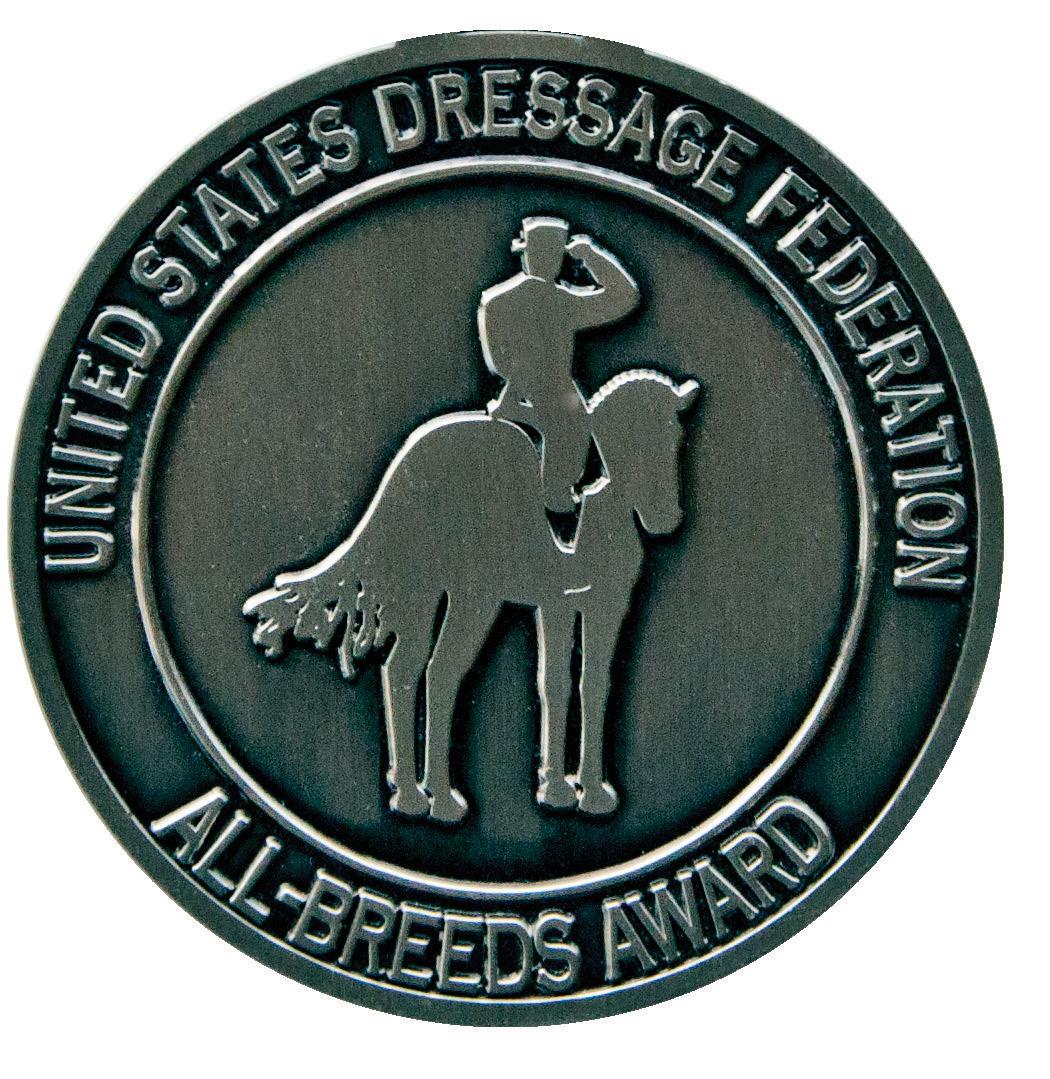
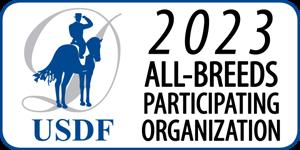
2023 All-Breeds Participating Organizations
These organizations, in partnership with USDF, promote and recognize a high standard of accomplishment within their breed, through their participation in the Adequan®/USDF All-Breeds Awards Program.
Collection
USDF BULLETINS
Annual Change of Region for Regional Championships
Riders wishing to compete at a Great American/USDF Regional Dressage Championships in other than the region of residence associated with their USDF membership information on file as of July 1 must submit a Change of Region form and fee. Find the form and submit online via the Great American/USDF Regional Championship Competitors page on the USDF website.
USDF Regional Adult Amateur Equitation Program Prizes
The USDF Regional Adult Amateur Equitation Finals presented by Big Dee’s Tack & Vet Supply will be held in conjunction with each of the nine Great American/USDF Regional Championships competitions. Big Dee’s will be providing champions with a $100 gift certificate; reserve champions, a $75 gift certificate; third-place finishers, a $50 gift certificate; and fourth-place finishers, a $25 gift certificate.
See the USDF website for dates, locations, and qualifying requirements.
Regional Championships Prize Money, Freestyle Division News
In 2023, Great American/USDF Regional Dressage Championships champions in each region will each receive $423 in prize money.
Reserve champions in each region will each receive $282 in prize money.
Beginning in 2023, each Great American/USDF Freestyle Championship level will have an open/junior/ young-rider class and an adult-amateur class.
For more information and qualifying criteria, please visit the Regional Championships Competitors page on the USDF website.
Competitions Sanctioned for Failure to Follow Regional Championships Program Rules
Show management is required to submit all entries in Great American/USDF Regional Championships, Dressage Seat Medal Semi-Finals, and Adult Amateur Equitation Regional Finals to USDF for verification of eligibility. Two 2022 competitions were identified as in violation of this rule, and consequently grant money was withheld by USDF.
Intermediate I and Intermediate II Reminder
For Adequan®/USDF year-end award purposes, Intermediate I and Intermediate II are not consecutive levels. See the USDF Member Guide for award requirements regarding consecutive levels.
Is Your Horse Declared for the All-Breeds Awards Program?
Declaring a horse for the 2023 USDF All-Breeds Awards is easy! Simply submit a copy of your horse’s breed/ performance-registry papers along with a completed All-Breeds Awards Declaration form and fee to USDF
no later than August 1. Find the declaration form on the USDF website under the Awards tab.
USDF Offers Rider Medals with Distinction
USDF bronze, silver, and gold medalists may be eligible to apply for the USDF bronze, silver, or gold medal with distinction, provided that the medal was recognized with scores of 67% and higher or that the rider earned additional scores of 67% or higher after the medal was recognized. Check your rider-award eligibility page on USDFScores.com to verify eligibility. Apply for the recognition online using the USDF Rider Performance Awards application located under the Awards tab on the USDF website. A special lapel pin will be available through the USDF online store for medalists with distinction. For more information, see the USDF Member Guide.
Master’s Challenge Award Available for Senior Competitors
USDF offers Master’s Challenge Awards for members aged 60 and up. Recognition is offered at six levels. Scores do not expire. See the USDF Member Guide for complete award requirements.
USDF Youth Program Deadlines
USDF Youth Dressage Rider Recognition Pin: June 30
USDF Arts Contest entries: July 1
USDF nomination for the USEF Youth Sportsman’s Award: August 15
USDF Youth Volunteer of the Year nominations: August 31
USDF Youth Convention Scholarship applications:
August 31
USDF Shining Star Program nominations approved:
September 30
USDF Ravel Education Grant: September 30
USDF Dressage Spirit Award: open-ended deadline. 2023 FEI North American Youth Championships deadlines:
Final NAYC application deadline: May 9
Final deadline to add horses to an existing NAYC application: May 31
End of the NAYC qualifying period: June 19.
L Program Faculty Applications Open
Applications for new USDF L program faculty members are now being accepted. Candidates must meet the following requirements:
• USEF “S” judge for two or more years
• Experience teaching in a classroom/lecture-style environment
• Willing to serve on the L Program Committee and assist in working toward the committee’s goals. For more information and an application, contact the L Program Committee liaison at lprogram@usdf.org. Deadline for applications is November 15.
18 May/June 2023 | USDF CONNECTION
USDF Breeders Championship Series
2023 Series Finals Dates and Locations*
Southern Series
July 30, 2023
Frankfort, KY
North West Series
August 13, 2023
Spokane, WA
South East Series
August 13, 2023
Camden, SC
Mid-West Series
August 20, 2023
Washington, MO
September 3, 2023
Magnolia, TX
North East Series
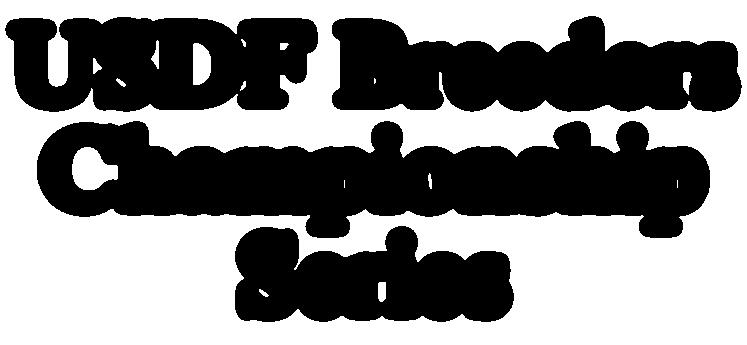
September 9-10, 2023
Mossup, CT
Rocky Mountain Series
September 21, 2023
Parker, CO
September 26-October 1, 2023
Devon, PA
Please check the USDF competition calendar for USDF Breeders Championship Series Final competitions that may be added.
All About Travers and Renvers
These complex lateral exercises are important building blocks in dressage training
By Jayne Ayers
Photographs by Jennifer Bryant
Most dressage riders are familiar with the benefits of shoulder-fore and shoulder-in in the training of the horse. There are many places in the daily work where these exercises can be used to develop straightness, suppleness, engagement, throughness, and even compliance.
questions, and I’ll explain their benefits to the horse, their use in developing the rider’s skills, and as indicators of correct training.
Sophisticated Gymnastic Exercises
As with most lateral work, travers and renvers help to increase the horse’s lateral suppleness, but they involve different muscles than shoulder-in or leg-yield.
Travers and renvers both require a greater degree of suppleness. As the horse moves from one body position to the other in the tests, his balance is challenged and thereby improved with practice. To do the exercises fluently, the horse learns to allow the rider greater control over his line of travel, bend, alignment, and shoulder position.
Developing the Rider’s Skill
Executing travers and renvers correctly demands a lot of skill and body control on the part of the rider, as well. Your position and seat must be stable and elastic in order to serve as a neutral base from which you can give subtle, complex aids. It is a challenge for many riders to keep their weight to the inside of the bend while actively using the outside leg to displace the haunches. If the horse resists the bend, his back muscles can actually cause the rider to slide to the outside. Riders must work hard to combat this. In the show ring, judges see many attempts at travers in which the horse is not truly bending but is actually performing a leg-yield instead.
TRAVERS: This sophisticated lateral exercise strengthens the horse’s outside hind leg and is an important building block toward such movements as half-pass, counter-changes of hand, and even canter pirouettes. Lehua Custer rides travers in canter on F.J. Ramzes during the 2023 Adequan®/USDF FEI-Level Trainers Conference.
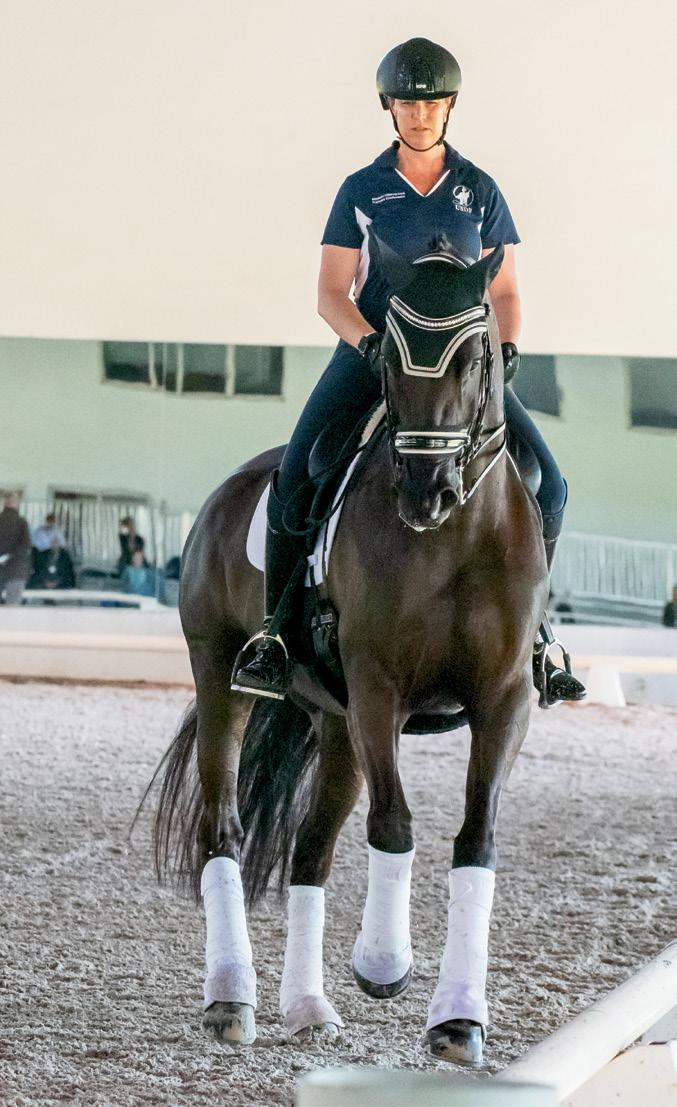
But what about travers (haunches-in) and renvers (haunches-out)? Why use exercises that put the haunches off to the side? Why are they included in the dressage tests? In this article, I’ll explore these
While the shoulder-in requires effort that gymnasticizes the inside hind leg, travers strengthens the outside hind. In shoulder-in, the horse moves in a line of travel away from the bend. Travers is the first movement we encounter in the dressage tests in which he moves in the direction of the bend. (See illustrations on the opposite page.) This is an important step in the development of the half-passes. In Third Level Test 2, in which the horse must go from shoulder-in to renvers, he must keep his balance and change the bend in a way that prepares him for counter-changes of hand in halfpass. Introducing the exercises in this order helps the training to be a series of progressive building blocks that develop the underlying basics: suppleness, balance, engagement, bend, strength, lightness of the forehand, and correct reactions to the aids.
The relative use of inside and outside reins in these exercises is tricky because both are needed for a correct outcome, but often the rein opposite the active outside leg has more weight in it. If the outside rein is too tight, it will limit the bend, producing a leg-yield facing the wall rather than travers.
Another challenge in riding travers and renvers is for the rider to keep the hips aligned with the horse’s hips and the shoulders aligned with the horse’s shoulders, all while keeping both horse’s and rider’s spines vertically aligned and the shoulders level, neither collapsing over one hip nor sliding to the outside of the bend toward the active leg. It’s a tall order!
Lots of practice at the walk can be of great benefit in sorting it all out for both horse and rider. Riding the movements in walk gives the horse time to absorb and react to a
20 May/June 2023 | USDF CONNECTION The Judge’s Box
new set of aids. It allows the rider to inventory the aids used and to gauge the horse’s reactions, making adjust ments as needed. Coordinating the aids for any lateral exercise can be a challenge. Travers and renvers are particularly complex.
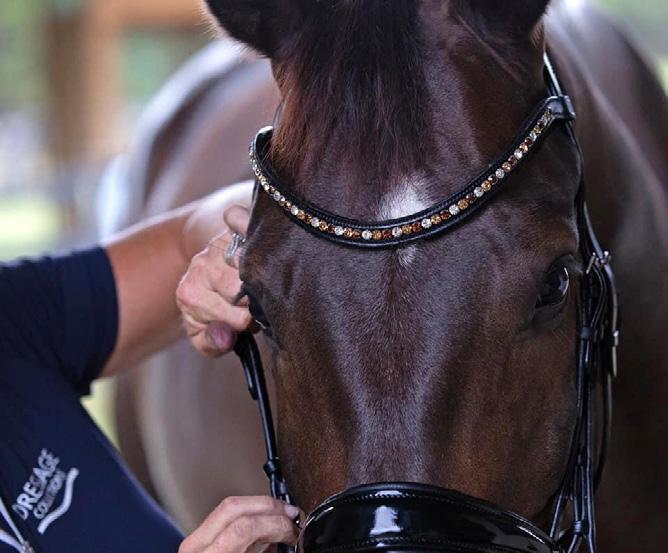
Tests of Training

Renvers is the inverse of travers. The two movements are mirror images that are physically the same for the horse. Why, then, did the test writ ers put travers in Second Level and renvers in Third Level?
Entering the renvers requires a change of bend, whether it is done from a shoulder-in as in the test or from a corner, which can be even more difficult. The bend change is an added challenge to both horse’s and rider’s body control and bal ance. An easier version to practice at home could be to ride half-pass toward the wall, followed by renvers down the long side with no change of bend. Even this variation takes a lot of control!
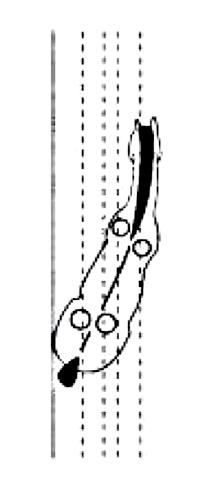

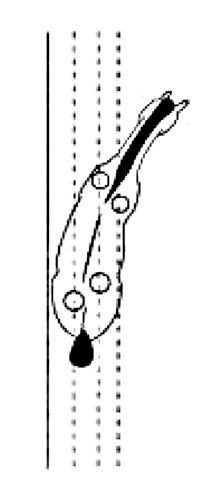
One thing to keep in mind as you train your horse is that a high level of control must be achieved before you can begin to reap the benefits of
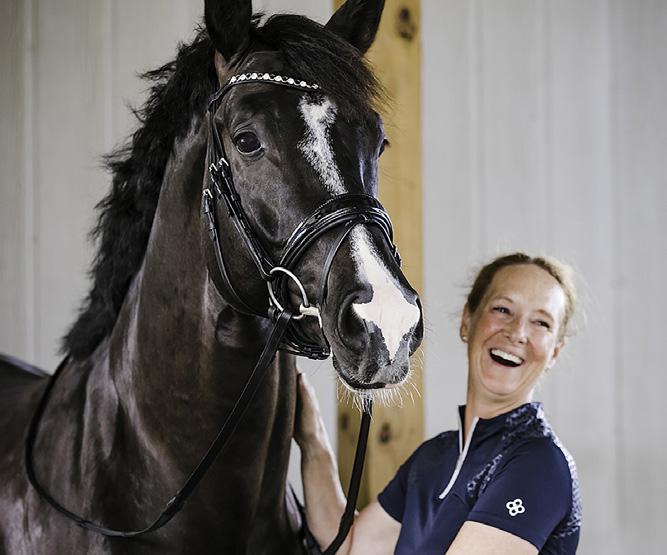
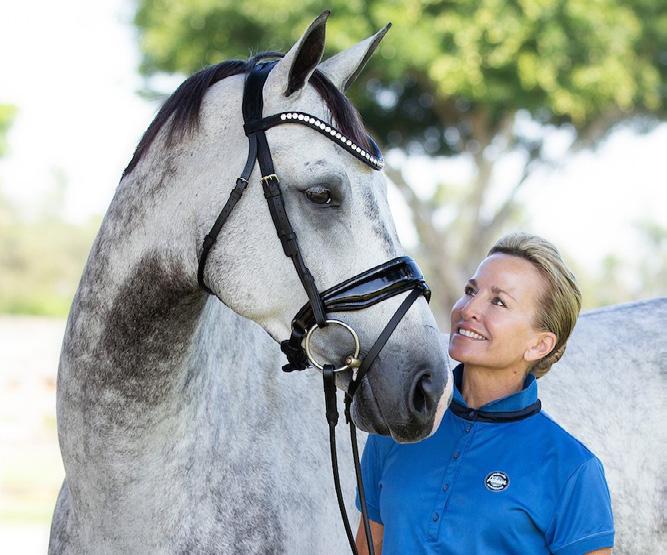
USEF ILLUSTRATIONS
DRESSAGECOLLECTIONS.COM ~Compose your anatomic Bridle2Fit~ For information please contact info@dressagecollections.com Only The BEST Brands! Bridle2Fit • KASK Helmets • Neue Schule Herm Sprenger • Cavallo • EA Mattes Free Remote Consultations 765-341-5578
LATERAL EXERCISES COMPARED: In shoulder-in (left), the line of travel is away from the direction of bend. In both travers (center) and renvers, the horse moves in the direction of the bend, as he will later do in half-pass.
The Judge’s Box
and canter pirouettes. Renvers can be an important tool to help the horse develop flying changes that are straight and uphill. Sequences of combinations of these and other lateral exercises can help to make the horse more attentive, quicker to the aids, and more mobile. Time spent

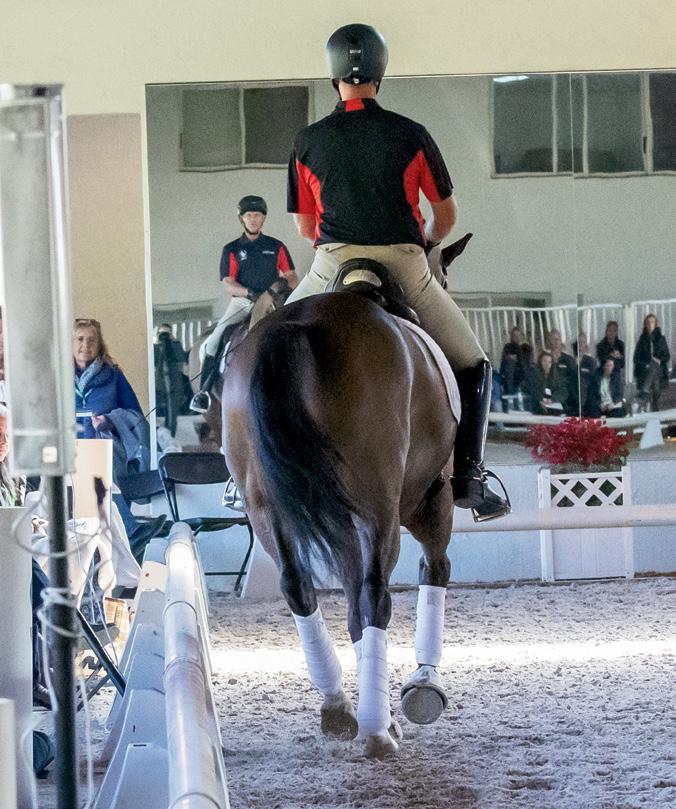
perfecting the travers and renvers can pay big dividends later on.
US Equestrian “S” and retired FEI dressage judge and USEF “R” sport-
horse breeding judge Jayne Ayers, of Pewaukee, Wisconsin, has been a USDF L Education Program faculty member since the program’s inception. She is a member of the USDF L Program Committee and a former longtime member of the USEF Dressage Sport Committee.

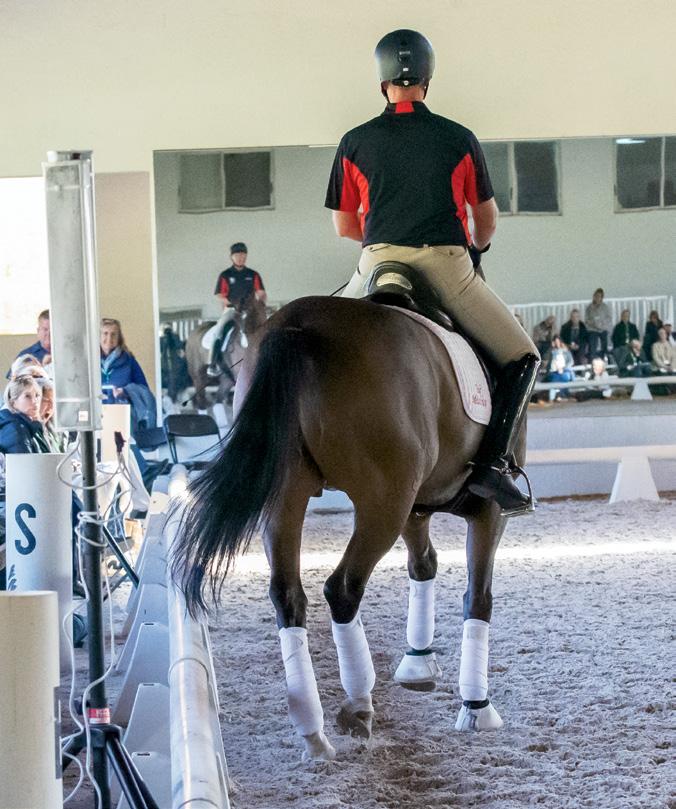
22 May/June 2023 | USDF CONNECTION
1 2 3
TEST OF CONTROL AND BALANCE: Changing the bend from one lateral movement to another requires complex aids and great body control and balance on the part of both horse and rider. Trainers Conference demo pair Chris Hickey and Valentin show how it’s done, going from renvers (1) to a smooth change of bend (2) that enables them to enter the corner with correct inside bend and in good balance (3).

The Science of Symmetry
Are horses innately “sided,” or do asymmetries originate in some other way?
By Hilary M. Clayton, BVMS, PhD, Dipl. ACVSMR, FRCVS Images courtesy of Dr. Hilary Clayton
One of the goals of dressage training is to develop the horse’s straightness. In dressage, straightness implies not only correct body alignment on straight lines and through turns, but also equality of impulsion, bending, and contact on the left and right sides.
Yet neither animals nor people are completely symmetrical, either structurally or functionally. Some
There are several reasons that a sound horse may move asymmetrically. For example, an old injury that resulted in the formation of scar tissue during healing may restrict the range of motion. In this article, though, I want to discuss a specific type of asymmetry that arises in the cerebral cortex in the brain, referred to as laterality.
Laterality Defined
In humans, laterality gives rise to the preferential use of one leg, one hand, one eye, and one ear. Many other species—including mammals, birds, amphibians, and fish—have been shown to exhibit laterality. Sometimes, the majority of individuals within a species conforms to the same side preference. In others, each individual has a distinct left or right preference, but the numbers preferring left or right are fairly equal.
Laterality in horses is a subject on which a lot of people have opinions, but there is not yet much science to support or refute those opinions.
In horses, both the forelimbs and the hind limbs are used for locomotion, which makes them more similar to human legs. Taking this idea a step further, the horse’s leg on the side that’s used for balance may be stronger. For example, if your horse always paws with the same foot, this might be his dominant limb, while the other limb provides support. This rationale would fit with the common belief that every horse has a strong side and a weak side, and that the strong and weak sides are associated with the horse’s crookedness pattern.
Acquired Conformational Asymmetry
scientists even question whether it’s desirable to try to create symmetry when our natural state is asymmetry. With regard to the locomotor system, however, it seems sensible to equalize weight-bearing and forces on the left and right sides of the body. If a horse habitually carries more weight on one limb than the other, for instance, the overweighted limb might be predisposed to develop a repetitive-strain injury.
Let’s start by considering laterality in humans and how it might apply to horses. You use your preferred or dominant hand for tasks requiring manual dexterity, such as writing, hammering, or brushing your teeth. But this criterion is difficult to apply to horses because their single digit (the hoof) is not designed for dexterity.
For the legs, the situation is a little different. In humans, the dominant foot is the one that would be chosen to perform a task requiring dexterity, such as kicking a ball. More relevant, however, is the fact that the non-dominant leg provides stable support while the dominant leg is being used for another task.
Selective breeding has produced refined sport horses with long limbs and small heads, but as a result, some foals can’t easily reach the ground to graze. To solve the problem, a foal may bend its knees, straddle its forelimbs to the side, or stand with one front limb forward and one back. A study of 23 warmblood foals in the Netherlands found that by the time foals were six months old, almost half showed a preference for always placing the same forelimb forward when grazing (Figure 1). Five foals habitually grazed with the right limb forward, and six grazed with the left limb forward.

This habitual stance laid the foundation for future asymmetries. The researchers found that the forward limb positioning put more weight on the heels, so as a result that foot grew into a flat shape with a low heel and long toe. The hoof that was further back had more weight on the toe and grew into a more boxy shape with long heels (Figure 2).
By the time the foals reached six months of age, in spite of regular
24 May/June 2023 | USDF CONNECTION
Sport Horse
FIGURE 1. A foal showing markedly offset forelimbs during grazing. Notice how the withers are lowered in this position to allow the foal to reach the ground to graze.
trimming every four to eight weeks, there was an average of 4 degrees difference in the left and right hoof angles, with a lower angle in the limb that was habitually forward during grazing. We could call this an acquired conformational asymmetry. Interestingly, after the foals were weaned, they were housed in large barns and fed from raised hay racks. Within a few months, the asymmetries in hoof growth resolved, illustrating the dynamic nature of hoof growth.
But a follow-up evaluation conducted when the horses were three years old revealed that, in some individuals, asymmetries persist. Onequarter of the horses still preferred to graze with the same limb forward as they had done as foals—and all of those showing a stance preference had been asymmetrical as foals. These horses still had longer limbs and smaller heads, and the asymmetry between their left and right hoof angles had increased to 6 degrees. These findings lead to the question: Could a leg-position grazing preference be an early indication of laterality? What we learned from this study is that some horses have an inherent preference in the way they use their left and right limbs during grazing, and that this preference may be associated with asymmetrical hoof angles. What is not yet certain is
IN THE NEXT ISSUE
• Focus on horse health
• Best feeding strategies for all ages and stages
• Disaster preparedness for horse and farm owners
• How to evaluate a sale horse

• 2023 FEI World Cup
Dressage Final coverage
USDF CONNECTION | May/June 2023 25
Sport Horse
transferred from one forelimb to the other. During the weight transfer, one forelimb is retracted under the body as it prepares to leave the ground, and the other forelimb is forward as it accepts weight (Figure 3).
At the walk, the horse’s withers are normally at their lowest point during the weight transfer from one forelimb to the other. The researchers determined that, in six out of the seven horses, the withers dropped lower during the weight transfer on one side than on the other. The difference was quite small—about an inch—but was consistent under a variety of circumstances. Of the seven horses analyzed, five dropped the withers lower when the right forelimb was retracted; one dropped lower when the left forelimb was retracted; and one was symmetrical (Figure 4).
whether a habitual grazing stance is a sign of innate laterality. Regardless, many horses have slightly differentshaped fore hooves, with one growing a little wider and flatter while the other grows narrower and more upright. No matter the cause, regular farriery should prevent such differences from increasing over time.

Asymmetry in Motion: Studies and Findings
Study #1: Circling. From the dressage trainer’s standpoint, an important aspect of asymmetry relates to the horse’s tendency to perform differently when tracking right versus tracking left. A two-part study evaluated a group of young horses at nine months of age and again at two years of age. In the first phase of the study, 29 unhandled nine-month-old foals were observed in a round pen as their dams were lunged in 20 circles to the left and 20 circles to the right. On the left rein, all but three foals followed the outside rail; the other three each deviated to the inside on a single circle. Tracking right, 20 foals stayed on the rail for all 20 circles, while nine cut across the circle on all 20 circles.
After the foals were weaned, they were handled equally from the left
and right sides to remove the possible influence of asymmetrical handling. For the second phase of the study, 17 of the original group were reevaluated in the round pen at age two. On the left circles, 16 horses stayed on the rail throughout, and one horse deviated across the circle on all 20 revolutions. Circling to the right, only six horses remained on the rail throughout, with 10 horses deviating across the circle every time.
Taken as a group, the majority of these young horses tended to drift toward the outside (the right) on the left rein and to “fall” to the inside (the right) on the right rein. The tendency to leave the rail and fall to the right increased with age, becoming close to 60% by age two. We don’t as yet have data that directly connect the behavior of young horses with that of ridden horses, but horses’ tendency to fall to one side is well recognized under saddle.
Study #2: Withers drop. A group of Swedish researchers made an interesting observation as they watched seven highly trained dressage horses walk on a treadmill. In the walk stride, the two forelimbs are on the ground together for a short period at the start and end of each step, as the weight is
The amount by which the withers dropped was greater when the horses were ridden, which reflects the effect of the rider’s weight on the horse’s vertical motion. In addition, a high or restricted head and neck position was associated with greater asymmetry of withers motion, whereas a long-andlow or free position minimized the asymmetry.
The forelimb that was retracted during the withers drop stayed on the ground longer and was retracted further than the other forelimb. The horse’s haunches were displaced toward the side of the more retracted forelimb, with the hind limb on that side taking a shorter step. In 71% of the horses in the study, the right forelimb was retracted further and the haunches were displaced to the right. These findings are in accordance with the German Equestrian Federation’s training manual, The Principles of Riding, which states that in most horses the right hind hoof is not aligned with the track of the right forehoof; the right hind “escapes” to the side and is set down further to the right and further forward than the left hind.
Study #3: Foot and leg twisting. Another piece of the asymmetry puzzle is provided by a study that looked
26 May/June 2023 | USDF CONNECTION
FIGURE 2. Uneven hooves as viewed from behind. The left hoof is wider, with low heels. The right hoof is narrower, with higher heels.
at how a horse’s hooves twist against the ground when the legs are bearing weight. In this study of nine horses, both hind hooves tended to twist the toes inward and the hocks outward. This is why the hocks may be seen to swivel outward when the horse is on loose footing that allows the hooves to twist. In the forelimbs, two of the nine horses showed the same pattern, with both forelimbs experiencing an inward twist. In the other seven horses,
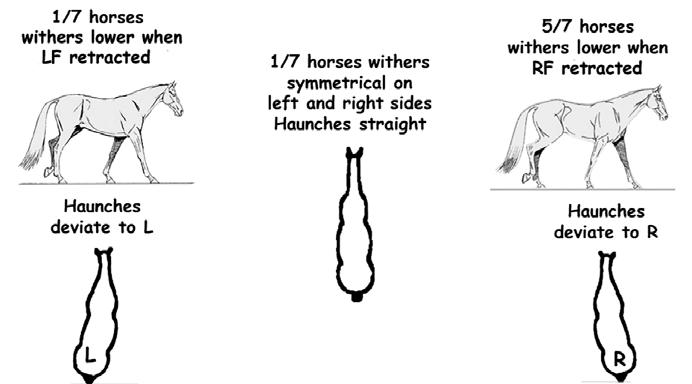
the left front twisted inward and the right front twisted outward. In 78% of the horses studied, the right forelimb was “different.”
More Study Needed
The number of horses examined in research studies to date is small, and it will require many more studies with larger numbers of horses before we can hang our hats on the results. Interest in laterality is growing
rapidly within the scientific community, as evidenced by the recent formation of the International Task Force on Laterality in Horses. This group is dedicated to investigating laterality in horses in general and especially with regard to locomotion. We hope that this will lead to information that can help riders and trainers to understand the issues around straightness.

She was the original holder of the Mary Anne McPhail Dressage Chair in Equine Sports Medicine at Michigan State University’s College of Veterinary Medicine, East Lansing, from 1997 to 2014.
A world-renowned expert on equine biomechanics and conditioning, Dr. Clayton is president of Sport Horse Science, LC, which is dedicated to translating research data into practical advice for riders, trainers, and veterinarians through lectures, articles, and private consultations. A USDF gold, silver, and bronze medalist, she is a longtime USDF Connection contributing editor and a past member of US Equestrian’s Dressage Committee. In 2020 she was inducted into the Roemer Foundation/USDF Hall of Fame.
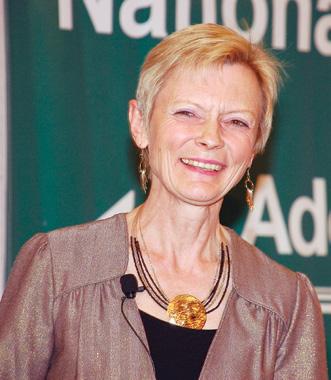
USDF CONNECTION | May/June 2023 27
FIGURE 3. Vertical oscillations of the withers during a full stride of walk. The illustrations show the stage of the stride corresponding with the high and low points on the graph. In this horse, the withers drop lower during the weight transfer from right fore to left fore.
FIGURE 4. Body alignment of horses and corresponding withers position during weight transfer between forelimbs. Of seven horses studied, one had lower withers during weight transfer from left fore to right fore, with the haunches deviating to the left (left). One horse showed no difference in withers height during weight transfer (center). The remaining five had lower withers during weight transfer from right fore to left fore, with their haunches deviating to the right (right).
Dr. Hilary Clayton is the professor and Mary Anne McPhail Dressage Chair emerita.
Meet the Expert
Take Your Best Shot
How to engage your members—and prospective members—with great photos and video
 By Penny Hawes
By Penny Hawes
It’s no secret that the modern world has become increasingly image-driven. Between short attention spans and the explosive growth of social media, photos and video are driving the reach of many organizations online.
USDF group-member organizations (GMOs) use photos and video to record important moments, to attract new members, and to celebrate successes. A championship photo, a cute candid of a kid riding
sand words, then it’s important to make sure that your picture is telling the right story. An unfortunately timed action shot may be less than flattering, and lack of attention to background and composition may mean that a portable toilet is visible in your championship photos.
We asked three professional equestrian photographers to offer advice for creating beautiful, useful (and maybe even award-winning!—
“Some of the models, like the iPhone, have amazing cameras and can capture some really good photos, especially for online use,” says Jessica Farren, of Seattle, Washington, owner of Jessica Farren Photography, the 2022 Great American/ USDF Region 6 Championships official photographer. But “for printing, maybe not as much. If you want to print things, unless you’re doing just small photos, I wouldn’t say the quality is always amazing for that.”
Another difference, according to Farren, is that “sometimes the cell phone [camera] can distort the proportions of a horse or person. So that’s why the pro cameras sometimes are better.”
Shooting with a smartphone does have one advantage: “You can be a bit more discreet, especially if you’re trying to catch candids, or if you’re just trying to be a little less obvious that you’re taking pictures,” says Farren. “The cell phone is a bit easier than having a big professional camera with a lens pointing at someone.”
her first-ever dressage test, or a shot of the annual banquet awards table laden with tricolor ribbons is sure to engage viewers.
But who actually takes all of these pictures, and how does a GMO make sure that the photos it shares are not only pretty to look at but also convey the desired message? If a picture is worth a thou-
see sidebar) images that will help promote your GMO and the sport of dressage.
Talking Tech
If a GMO wants photos for its website, newsletter, or social media, we asked our experts, is a “real” camera a necessity, or can the average smartphone suffice?
“Smartphones, no doubt in my mind, are just as good as other cameras for regular candids,” concurs John Snyder, owner of High Time Photography in Winston-Salem, North Carolina, the 2022 Great American/USDF Region 3 Championships official photographer. “With a camera, you have to know how to get the [memory] card out and get the photos over and all that. In my opinion, no way do you need to invest in a camera.”
Regardless of whether you’re shooting with your phone or with a fancy digital single-lens reflex (DSLR) or mirrorless camera, the person behind the lens, not the
28 May/June 2023 | USDF CONNECTION
SHUTTERSTOCK GMO
SHOOT TO ENGAGE: Done well, photos and videos can enhance your GMO’s profile and serve as great promotion tools
equipment, is what makes the image, says award-winning equestrian photographer Amy Dragoo, owner of AK Dragoo Photography of Coatesville, Pennsylvania, whose images have appeared on countless covers of such magazines as The Chronicle of the Horse, Practical Horseman, and USDF Connection.
“It’s not the size of your lens; it’s how you use it,” Dragoo says. “You want things that are engaging, and a wide shot of the ring with the horse at the far end is not engaging. Rings can look very empty with one horse.”
Evoking Emotion
A great photo has the power to move us—to make us feel the subject’s emotion, to evoke a mood, or to transport the viewer into the scene. That’s why the photographer’s eye is so critical in capturing those perfect, and often fleeting, moments.
“When you’re doing social media, you want everything to be engaging,” says Farren, “which is why I went with candids and storytelling. Since candid moments are moments that aren’t totally posed, the first thing would be to be observant and try to anticipate moments.”
Example: “If you know that someone’s having an amazing ride, and you know that it’s a young person and you know that a parent is watching, more than likely you’re going to have the opportunity to take an incredible photo of a proudparent moment.” Or “a lot of times, you’ll also catch beautiful moments after the rider has saluted the judge and they’ll hug their horse.” Be ready and “you’ll catch some really wonderful, genuine moments that will tell a story.”
Some photos may be engaging, but not in a way that tells the story you want to tell. When things in the ring don’t go as planned, says Farren, discretion is warranted.
“There are a lot of photographers out there who like to photograph those ‘oops’ moments, you know, where the horse is having a bit of a
tantrum or decides that they’re going to do a little buck or a little rear,” she says. “I personally stay away from those moments. I know there are a lot of people who have fun with photos like that, and they can be interesting moments to catch, but it’s just something that I feel like you don’t always want to publish.”
Reactions to “outtake reel” photos vary, says Snyder. “If it’s a really

Get Recognized for Your Great Photograph
Two annual USDF awards programs include recognition for outstanding dressage-related photography.
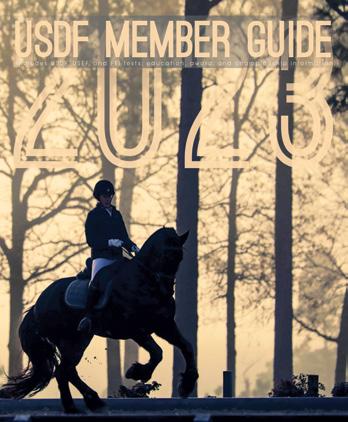
The photography category in USDF’s GMO awards honors outstanding images taken by amateur photographers and published in GMO newsletters. Awards are presented in four GMO size categories. The nomination deadline is August 31. Visit usdf.org/awards/service/gmo.asp to learn more.
The USDF Arts Contest recognizes excellence in photography in three age divisions and is open to both amateur and professional photographers who are USDF members. Entry deadline is July 1. Learn more at usdf.org/ awards/other-awards/ art.asp.
Custom- Fit Boots
For over a century, the Dehner name has been proudly worn by young and old alike.

Feel for yourself the comfort and fit that have made us one of the most sought-after boots in the business!
Log-on today to view our full line of boots and shoes.
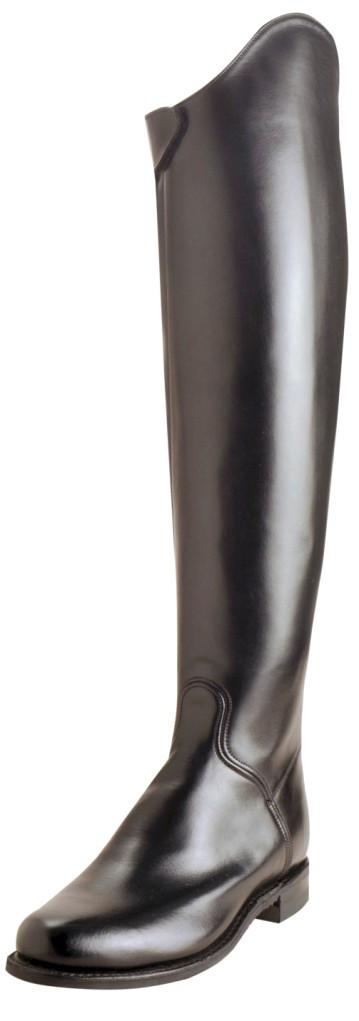
USDF CONNECTION | May/June 2023 29
Tel: (402) 342-7788 * Fax: (402) 342-5444 www.dehner.com Made in the U.S.A
WINNING PHOTO: The grand-prize-winning image (photo or art) of the annual USDF Arts Contest becomes the cover image of the following year’s USDF Member Guide. The 2023 edition features “Sunrise Dressage” by Meghan Benge, the 2022 winner in the adult photography division.
bad picture, like a really big buck or something, you never know how people are going to feel. Sometimes they want you to take it off the website, and sometimes they’ll say, ‘I’m so glad you got that!’”
Farren always asks permission before publishing a photo. (See “Do You Need Permission?” at right.)
“I don’t post photos willy-nilly,” she says. “I’ve taken some great candids of some riders, and I’ve asked them [for permission to publish], and they’ll say, ‘I really don’t like my photo out there,’ and I’m like, ‘OK, fine, I’ll keep it to myself. In fact, one of them is a piece of art on my wall.”
Dragoo says that another important aspect of viewer engagement is making sure that your photos are getting in front of the right audience.
“It’s knowing your audience and tailoring what’s best for them,” she says. “Maybe that’s worth a poll or whatnot to see what platforms they’re on so you can best deliver to them. You know, knowing your audience, knowing what they want, what they’re interested in, and delivering it to them in a format that they’re most receptive to.”
Point, Shoot, Post
The immediacy of social-media posting can lead to the urge to click and then post right away—which our experts say is not always the best strategy.
Snyder cautions against posting a performance shot without having
someone else take a quick look at the photo, especially if the photographer isn’t familiar with dressage. “Surely there’s somebody at the show that they can check with before posting a photo and just ask, ‘Does this look decent?’”
Social-media posts aren’t just images; they have text, too. “Doublecheck the wording,” Snyder advises, “because you know how easy it is to type stuff wrong. There is nothing worse than posting things with misspellings.”
“You have to have some sort of plan to your approach,” says Dragoo. Managing a GMO’s social-media feeds is “a job unto itself. It’s not just thinking, ‘Oh, just go take a picture and we’ll post it on Instagram.’ Sure, no problem. But the more effort you put into it, the better your results will be.”
Your GMO’s social-media followers love fresh content, but don’t go overboard, says Snyder. “You’ve got to have that happy medium, because you want to have the engagement of the customers without being, ‘Oh, there’s another post talking about the next ride.’” Incessant posting during a show or other event not only will overwhelm your audience; it may also leave you with nothing to post for the next several weeks.
“There’s always the feeling, ‘I’ve got to get it out! It’s fresh now!’” Dragoo acknowledges, “but those things are evergreen, so it keeps. So you’re not just glomming into someone’s feed for the week of the event,
and then you have nothing. You can spread it out.”
The Long Game
Keeping your social media, newsletters, and website fresh is a large part of audience engagement. Thinking strategically can allow you to get several weeks’ worth of content out of one event.
“A clinic report for a newsletter is different from your day-of-the-event coverage,” Dragoo says. “And the nice thing is that, if you have someone who’s sort of dedicated to documenting, you don’t have to put it all out at once. So, say you’re doing a clinic and you have 20 nuggets, 500 nuggets, I don’t know how many nuggets of information; you can then use those throughout the year or throughout a period of time to keep yourself relevant. You don’t have to dump all the content at once; you can have a couple of posts a week.”
Do You Need Permission?
Do you need permission to take somebody’s photograph?
At an open-to-the-public event, such as a horse show, a formal signed release (aka a model release) is usually not necessary provided that the image will be used for editorial purposes only (i.e., not for advertising or promotion).
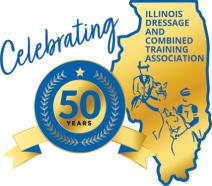
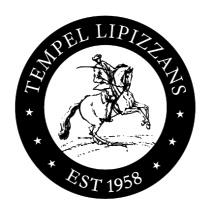
At a private event, such as an invitation-only clinic at someone’s farm, you’d need to get permission to photograph on the premises.
That said, it’s always advisable to ask permission of the subject (or the horse owner, or the subject’s parent or legal guardian) before publishing an image (in your GMO’s newsletter or on its socialmedia feed, say).
“Err on the side of caution,” advises professional equine photographer Amy Dragoo.
30 May/June 2023 | USDF CONNECTION GMO
What About Video?
No discussion of imagery on social media would be complete without mentioning video. With the rise of TikTok and the heavy emphasis on video on platforms including Facebook and Instagram, Dragoo says, “Yes, it’s photo-centric, but all the numbers and trends are toward video shorts, like Reels and Stories, so don’t forego those.”
Dragoo recommends planning video content as part of an overall social-media strategy. “So, if you’re covering an event like a clinic, use a training tip. You could have a Training Tip Tuesday. Those have can have a life of their own, and they’re evergreen. You can take a little video snippet of someone riding the legyield or whatever it is.”
Think Outside the Frame
Farren encourages GMO members and clubs’ social-media managers to experiment and have fun with photography and videography. Try shooting from different angles. Crop images in creative ways. Check out the effect of rendering images in black and white instead of color.
“Take every opportunity you can to practice, because the more you practice, the more these things become second nature and it becomes easier,” Farren says. “That’s not saying you’re not going to make any mistakes, but it’s just practice, practice, practice. You develop ‘muscle memory.’ Your body becomes aware. It’s like riding a 20-meter circle. They don’t look anything like circles initially, but you get there eventually.”
Penny Hawes is a writer, rider, and coach from Virginia. When she’s not working, you can find her hiking with her daughter, scouting around for antiques with her husband, or hanging out with her assortment of horses, cats, and dogs.
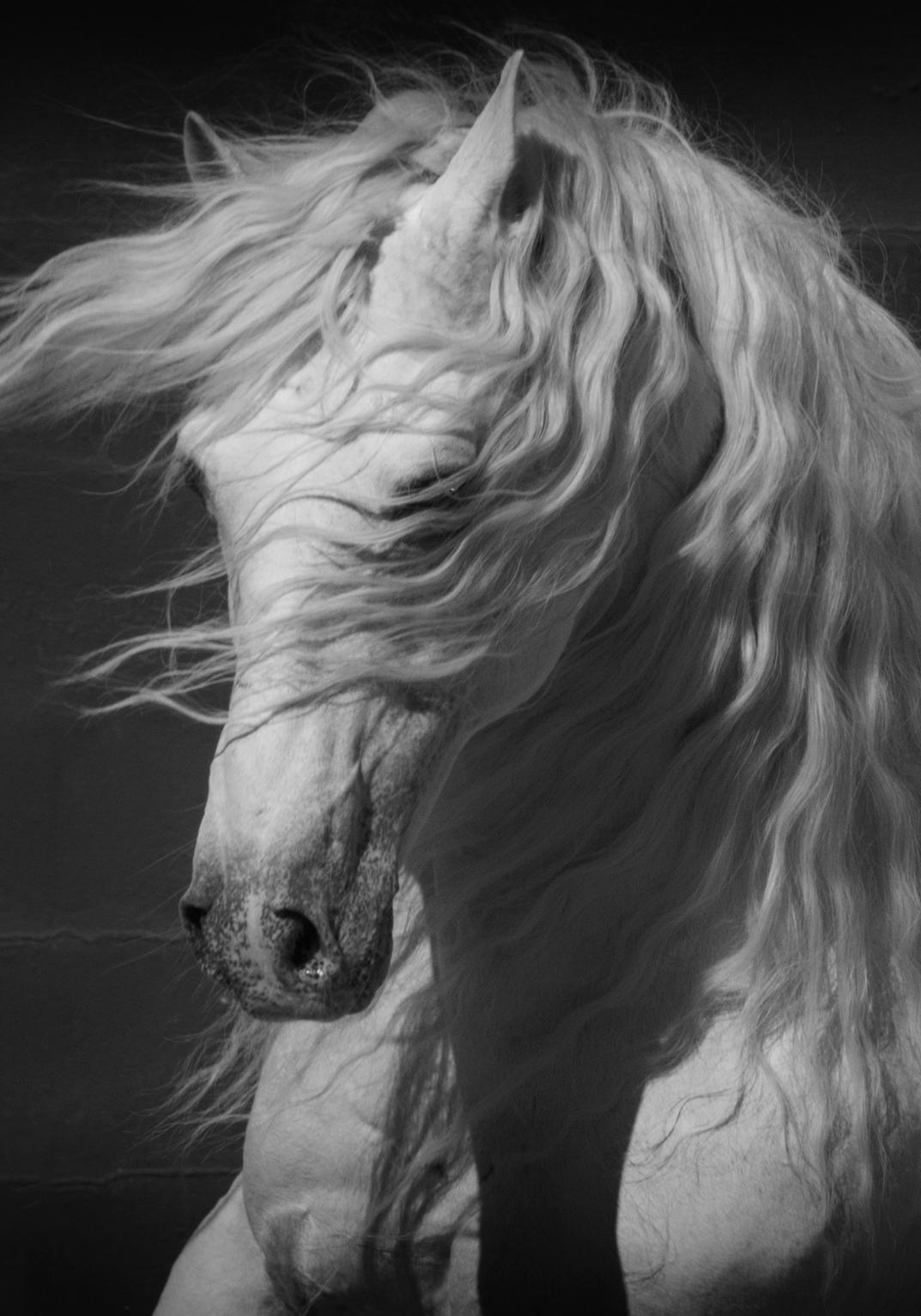

USDF CONNECTION | May/June 2023 31
August 5–6 SLADS AUGUST CLASSIC I&II
Two Ring All Indoor Show at the NEC Last show weekend to qualify for USDF Region 4 Championships. Opening : June 2 Closing: July 23 or when filled Scott Peterson
slads.org IT’S BE A PART OF IT Submit your dressage stories, content, and photos to yourdressage@usdf.org WE WANT TO SHARE STORIES
photo by Bethany P
“S” Natalie Lamping “S”
Offering over $250,000 in prize money, the Great American Insurance Group/USDF Regional Dressage Championships provide a showcase for achievement and feature qualified riders competing in open, adult amateur, and junior/young rider divisions for regional honors.

NEW FOR 2023: Open/Jr/YR and AA Freestyle Championship classes!
These championships also serve as the qualifiers for the 2023 US Dressage Finals presented by Adequan®.
www.usdf.org
©DianaHadsallPhotography
Great American Insurance Group/USDF Regional Dressage Championships
Region 1
October 5-8 2023
Lexington, VA
Region 2
September 21-24, 2023
Wayne, IL
Region 3
October 5-8, 2023
Ocala, FL
2023 DATES AND LOCATIONS
Region 4
September 28-October 1, 2023
Cumming, IA
Region 5
September 29-October 1, 2023
Scottsdale, AZ
Region 6
October 5-8, 2023
Sherwood, OR
Region 7
September 21-24, 2023
Rancho Murieta, CA
Region 8
September 21-24, 2023
Saugerties, NY
Region 9
October 5-8, 2023
Katy, TX
Regional Championships are qualifying competitions for the US Dressage Finals
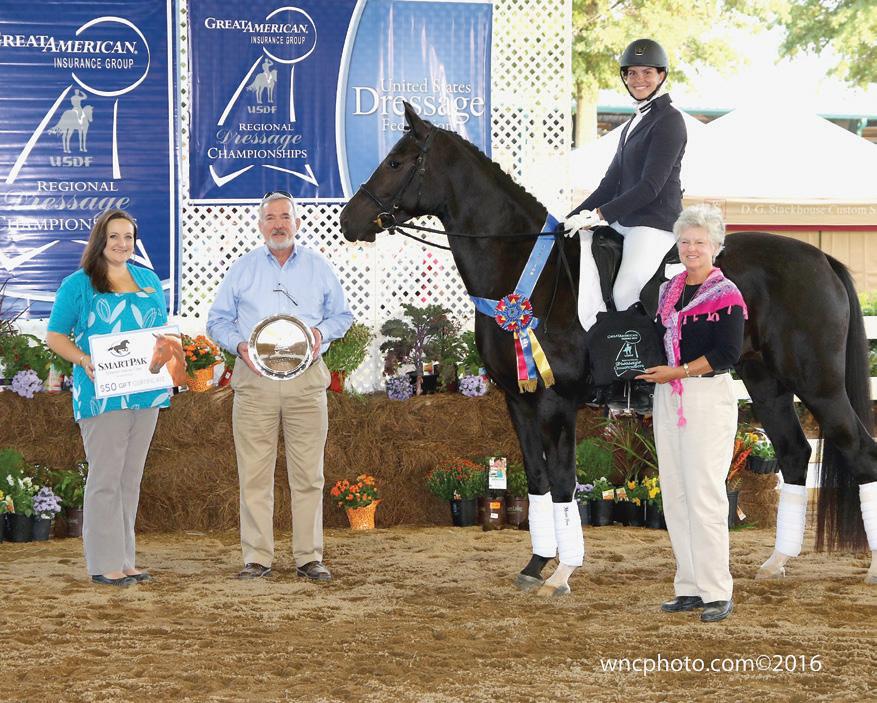

See the calendar at www.usdf.org for the most current dates, locations, and competition contact information.
Title Sponsor of the Great American Insurance Group/USDF Regional Championships
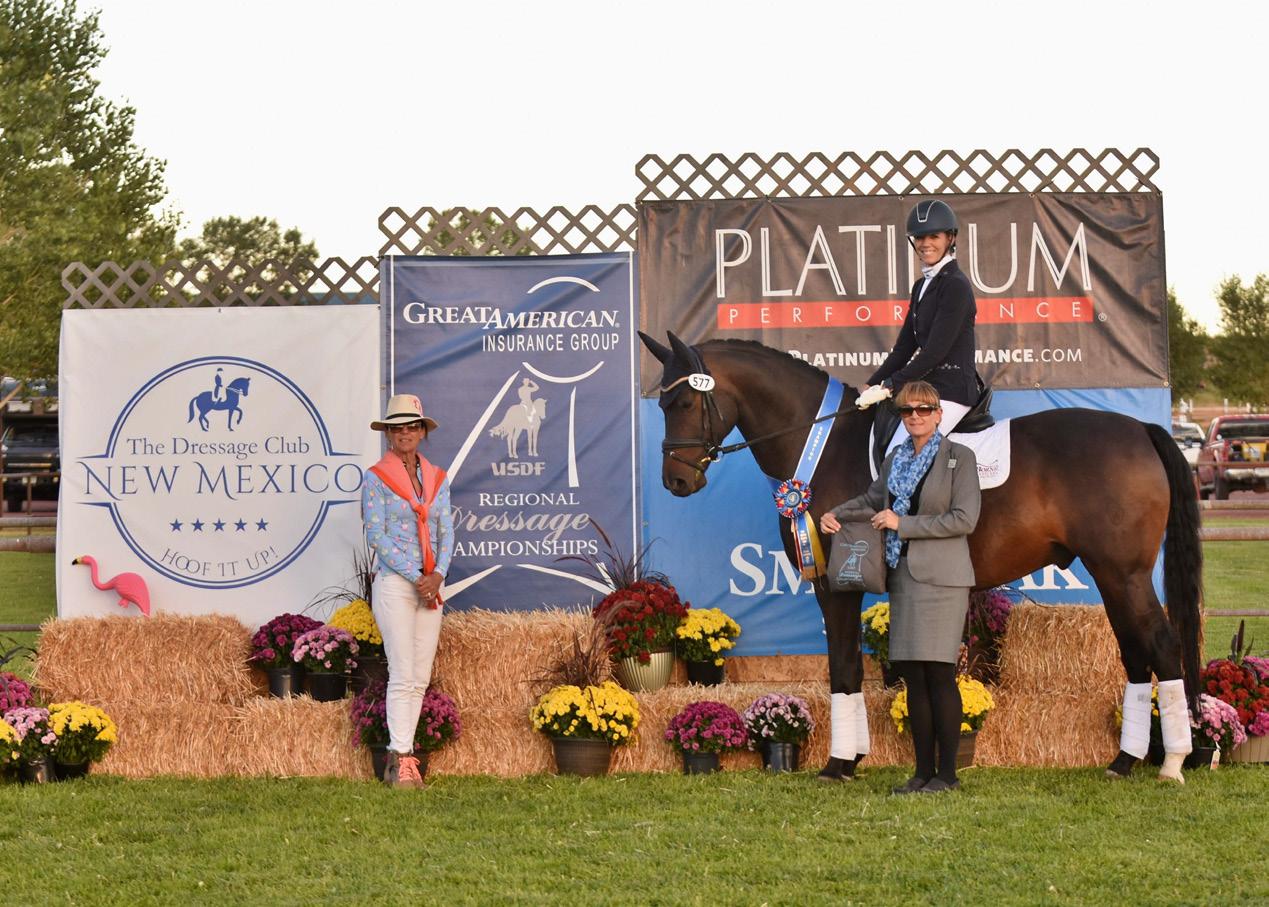
Great American is one of the world’s leading providers of equine mortality insurance and related coverages in addition to offering a full line of property and casualty products for the equestrian community through its equine farm center. To learn more about Great American Insurance, visit www.greatamericaninsurancegroup.com.
Presenting Sponsor of the Great American Insurance Group/USDF Regional Championships

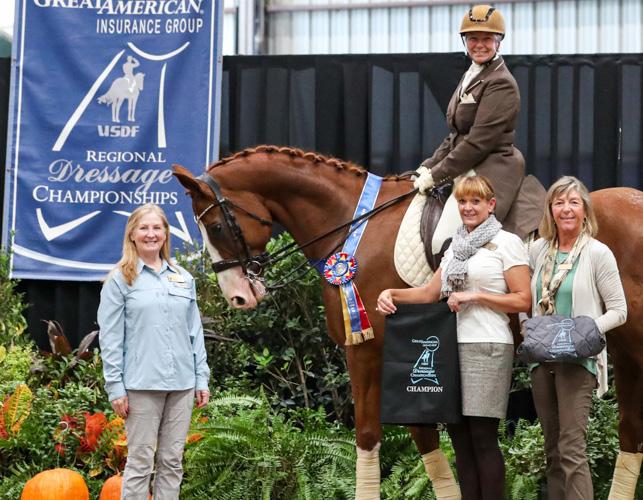
The patented SmartPak supplement feeding system gives horse owners peace of mind with its premeasured dosages for each horse. To learn more about SmartPak or to shop their products, visit www.smartpak.com.
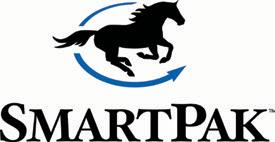
Supporting Sponsor of the Great American Insurance Group/USDF Regional Championships
Since 1996 the team at Platinum Performance has been focused on researching the role of nutrition in equine health and developing formulas to help improve the health and performance of the horse. To learn more about Platinum Performance visit www.platinumperformance.com.
© HighTimePhotography
©SueSticklePhotography
Practice Makes Perfect (Well, Almost)
Test-prep strategies for show-ring success
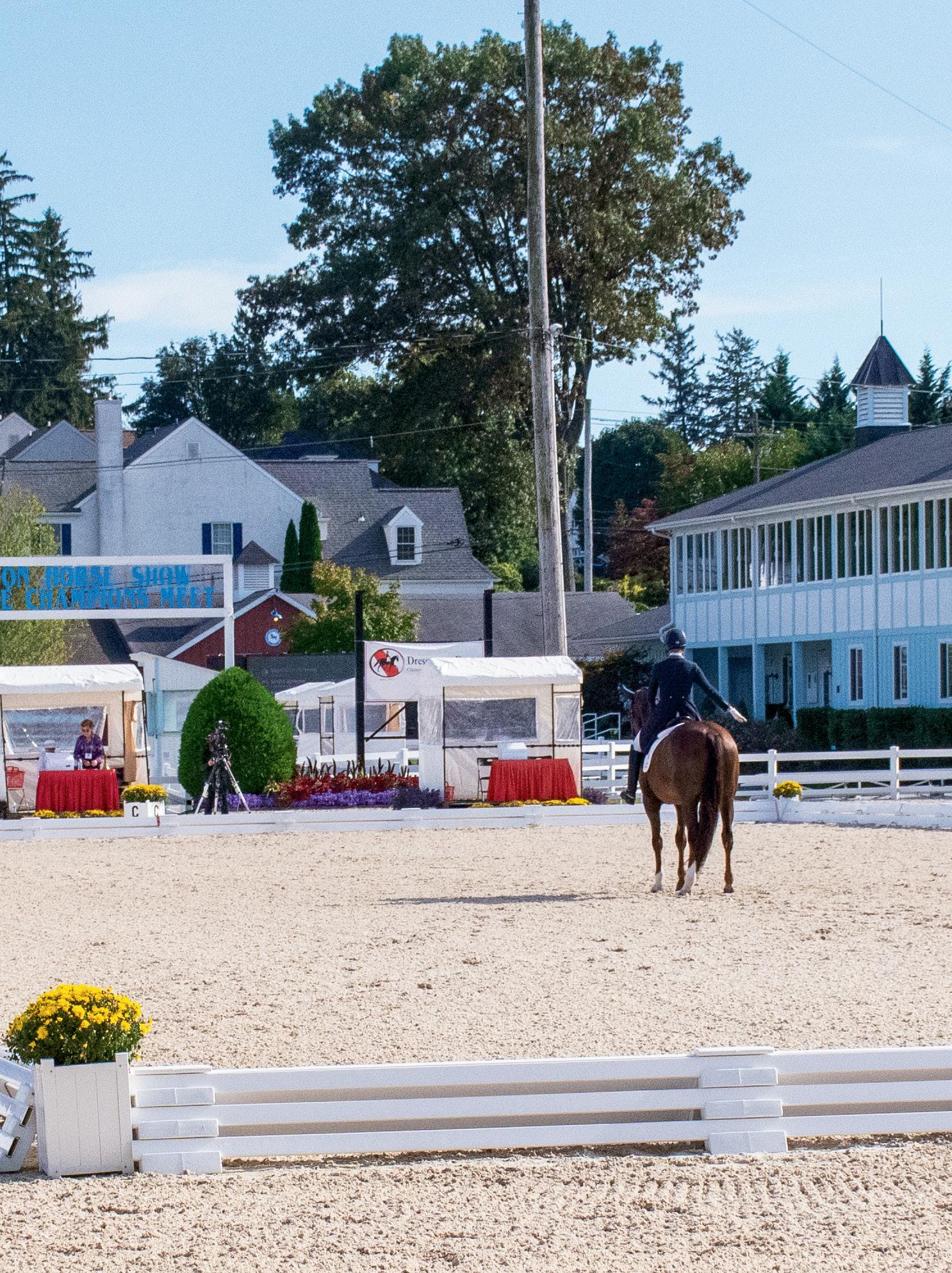 BY NATALIE DEFEE MENDIK
BY NATALIE DEFEE MENDIK
34 May/June 2023 | USDF CONNECTION
CONQUER THE CENTER LINE: For the most rewarding show-ring experience, learn how the pros prepare themselves and their students
All dressage riders can agree: There’s a heck of a lot that goes into producing a solid competition performance. In this article, four instructor/trainers with a wide variety of horses and clients share their test-prep tips for being confident and ready when it’s time to get out and show.

Commit to Memory—and Then Apply
With so many different learning styles, memorizing a dressage test takes an approach unique to each rider.
A bullet-point synopsis works best for Jennifer Truett, a USDF FEI B certified instructor and L graduate from Lebanon, Ohio.
“I make a ‘CliffsNotes’ version of the test: Basically, I process it down to as short a version as I can,” Truett explains. “I have actually gotten the Grand Prix test down to thirteen lines.”
Truett creates concise phrases that she records in the Notes app on her smartphone. “I make shorthand for what happens where. For example, if I’m going to do two-tempi changes, I’ll say ‘twos.’ I don’t need to say what diagonal line it is; I already know.”
Truett, a USDF Diamond Achievement recipient, assigns her students the homework of memorizing the test in whatever way works best for them; then in lessons they work on sections together.
“As a teacher, you need to make sure your students are really prepared,” she says. “For me, this means that they own the test—that they have a plan, know how they want to warm up, know what to expect from their horse, and know what to do if things go wrong.”
Part of owning the test involves solo schooling, Truett says. “My students then come to me with what they need to work on. It’s my job as a coach to give my students the information and the tools that they need, and then it’s on them to figure out which tool they need to pull out based on what they are feeling. It’s been a successful approach for us.”
In the Mind’s Eye
A self-described visual learner, USDF gold medalist Patrick Tigchelaar, a native of the Netherlands currently based in Winchester, Virginia, makes quiet time to go through the test in his head.
“For important shows I’ll start a month out, taking ten minutes every day to visualize my test,” he says. “I feel my horse and every movement as if it’s in real life.
USDF CONNECTION | May/June 2023 35
JENNIFER BRYANT
When I do this, I find the mistakes I would make, like forgetting to prepare in a corner, for example. After doing this in my head fifty, sixty times, I know exactly how I want to prepare for the actual competition. I tell my students the same: Visualize inside and out. Know where you might get in trouble; know where you need to take extra care to set up; know what you are good at to show off.”
Over the winter, Tigchelaar works with his business partner, girlfriend, and fellow trainer, Jess Idol, to come up with an individualized show-prep strategy for each horse. They determine how much and what type of warmup works best, and they focus on the specific skills required at the level.
How Tigchelaar practices the test also depends on the horse. He explains that “some horses do really well if they understand the pattern of a test, and for those horses I’ll go
through the whole test, while other horses get anticipatory, and for those I don’t go through the test, so they stay obedient.”
Learning by Doing
“For me, the best way to learn a test is to ride it,” says USDF silver medalist John Mason. The Conroe, Texas,-based dressage pro advises his students to start by running through the test to get a feel for it— to get a sense of what parts are easy and what parts need polishing.
From there, “with my students, we’ll do an active ride-through together, breaking the test into pieces and then putting those pieces together. We incorporate parts of tests into everyday lessons so the test isn’t scary or strenuous.”
Consistency is key for Mason in both teaching students and training horses. In his approach, schooling and showing tie together, with test figures, lines, and movements being

a simple, no-pressure part of daily schooling.
“I ride many young horses,” says Mason, who finds that “the good thing about the lower-level tests is they tend to flow really nicely. I’ll run through different variations on a regular basis, making it part of the routine—obviously not front to back, but, say, if I’m doing Training Level on a four-year-old, I’ll do the trot exercises as part of my warmup.”
“If the movements of a test aren’t easily part of your daily routine, you’re not ready to show that test,” Mason advises. “If I feel like putting everything together in different sets is too strenuous for the horse or for the rider, I’ll back off to simpler exercises.”
Shannon Warner, a USDF Diamond Achievement recipient based in Parker, Colorado, instructs her students first to watch the test they’ll perform, whether online or
36 May/June 2023 | USDF CONNECTION
AKDRAGOOPHOTO.COM
HAIRSTYLE TRIAL: Horses have to get accustomed to the feeling of their mane in braids, so school a few times at home with your horse braided before show day
in person. Then, in a lesson, Warner reads the test during a run-through so both she and the rider get a feel for the pattern with that horse.
Practice Run
In the runup to a competition, Warner creates a practice plan with each client.
“Although many people say not to school the entire test, I find my students are much more confident having ridden the test a few times,” she says. “For a horse that anticipates, we’ll change it up with a transition or a different gait, but still the same pattern. I think it’s important to ride the whole way through without stopping, so there aren’t surprises and you know how to work with whatever happens.”
A fun, no-pressure event Warner coordinates for her students is a fall costume fun show. “That’s where we push the envelope and get everyone out of their comfort zone by trying
out their next goal,” she says. “For the rider who wants to move up a level the following season, it’s the opportunity to give the next test a go without pressure or expectation— just fun.” The autumn event sets the stage for winter schooling goals.
Mason takes advantage of the opportunities available in his area: “I take clients and horses for ‘field trips’ to school offsite at neighboring barns,” he says. “We are very fortunate in Houston to have a recognized show essentially each month, so I can bring along horses and students that would benefit from schooling at a show without the pressure and expense of competing.”
Although her tight schedule typically doesn’t allow time for schooling shows, Truett does lots of at-home ride-a-tests. With a barn team that includes Truett’s longtime mentor, USEF “S” judge Sue Madden Mandas, and Truett’s assistant, “r” judge

Sophie Bayer, there are many opportunities for riders to get feedback on how to raise their scores.
Shows naturally bring a level of stress, which you can help mitigate by creating as much familiarity as possible, Mason says. For young horses, he recommends trial runs braiding at home—as many times as the horse needs to become accustomed to the sensation. For the competitor’s part, he advises those who own “show boots” to start schooling in them three weeks before the big day, especially if their everyday riding footwear is halfchaps or softer boots.
“All of your tack and equipment should be the same” at home as at the show, he says. “Again, it’s all about consistency.”
On Site
You can never be too prepared, our experts agree.
“Bring extra everything: bridle,
USDF CONNECTION | May/June 2023 37
JENNIFER BRYANT
GETTING COMFORTABLE: Hand-walking, hand-grazing, and otherwise spending time with your horse at the show can help him to relax and gain confidence in the environment
Prepping for Freestyles
The key to pulling off a freestyle, according to Ohio-based USDFcertified instructor/trainer Jennifer Truett, is to be ready for anything.
pete; there I do my visualization. I’ll look at the ring from the different judges’ booths, think about where my highlights will be, check if there are any scary spots my horse needs to see, and get really prepared with a plan,” he says. “I’ll also hand-walk my horse around the ring and hang out with my horse so he feels comfortable.”
Then, “About two hours before my ride, I’ll start to get my horse, my tack, and myself ready so I’m in a calm place of focus,” Tigchelaar continues. “I like to braid my own horses so I’m really connected with the horse.”
Prepping for Peak Performance
“Know what to do if your music stops or you get behind,” she says. Most important, “Make sure the choreography shows off your horse to the best of its ability, and [then] the part that happens at the show is pure joy. You have put all your time and effort into putting together a dance with your horse.”
If you make listening to your freestyle music part of your daily routine, you’ll get a feel for your choreography in relation to the phrasing of the music.
“You have to know your music inside and out,” says Coloradobased dressage pro Shannon Warner. “Listen to it throughout your day—in your truck, while doing chores.” Then, if something goes awry in the show ring, “you’ll be able to modify on the fly.”

Texas-based instructor/trainer John Mason cautions against going overboard with tricky choreography.
“Work with someone to create choreography that flows really nicely for you and your horse,” he advises. “Sometimes people worry too much about creativity with a ‘wow’ factor; but when your choreography is a stretch, it’s easy to get flustered. A really correct and well-ridden freestyle will get a solid technical score.”
halter, blankets, pads. You never know what you might need,” says Warner. “Once you’re there, take the time to get settled. Walk the horses, and get everyone—horses and riders—acclimated to the venue and let nerves settle. Run through the test
in the show ring if possible.”
No matter how busy he is during the event, Tigchelaar schedules some quiet time for mental rehearsal.
“I find half an hour to go to the show ring where I’m going to com-
For high-stakes competitions, it’s all about learning how to be “on” at the right time.
“I feel like I’ve learned over the past year how to peak a horse,” Truett says. “At the US Dressage Finals last fall, I was able to ask for more power, more expression, and more roundness and throughness in the days leading up to our championship class, so on that day it was like I could push a button and it was all there in a package. That’s a skill that took me a long time to figure out, but is important for serious competitors. It’s a process of being aware in the moment, knowing how much pressure you can put on and when to back off, and being smart in that decision process in the moment.”
The concept of peaking isn’t just for horses: Tigchelaar has also honed a mental peak-performance strategy for himself.
“I used to struggle with show nerves and tried to get rid of them until a show many years ago,” he says. “I was the only rider in the
38 May/June 2023 | USDF CONNECTION
SHUTTERSTOCK
TUNE IN: Listen to your freestyle music until you learn every beat
class, so I wasn’t nervous, and I made so many silly mistakes since I just wasn’t nervous. Now I try to get myself into this peak state of being nervous enough that I’m focused and sharp, but not so nervous that it’s a handicap.”
Head Games
Every dressage competitor has experienced show nerves at some point. “I remind clients that get nervous that the unique thing about our sport is you are competing against yourself and the standard,” Mason says. “Yes, you are placed against others in your class, but that’s not the point. We are showing the horse’s correct training; that’s the real goal of showing. Keeping this in mind also appeals to the ‘type A’ personalities dressage attracts: That drive is always going to be there, so turn the focus inward.”
Find what works for you to get in the right mental space on competition day, Warner advises. It might be doing quiet mental rehearsal like Tigchelaar. Others find it helpful to go through the test on foot, or to listen to some favorite music, or even to ease the tension by sharing a few laughs with friends.
A new tactic that Truett’s used over the past year has been doing goal-setting with her clients, and she says it’s paid off.
“We sit down for about half an hour and talk about what they hope to achieve. This helps me know what’s a priority and my students to be clear about what’s important to them. They journal daily,” she says. As a result, “All of my students are advancing much more than they have in the past, and I think it’s because they have set goals that we regularly review and have a plan for achieving.”
Knowledge Is Power
Keep in mind that everything printed on the dressage test sheets is valuable information you can (and should) use to help you prepare.

“Read the purpose of your test, and really show that you can fulfill the purpose of the level,” says Tigchelaar. “The pattern of a test is only half the battle; you should show the judges the basics of the level. Don’t ride at a level higher than you are comfortable, but instead ride at a level below what you are doing at home so both you and the horse can really have a good experience.”
Truett instructs her students to learn the purpose of each test and the directive ideas for each movement: “It’s important to know that the horse is ready for what’s asked of it, as well as the underlying foundation of the movements and how they are arranged.”
Big Picture
Remember to keep sight of why you show, says Truett, who notes that a competitor’s motivation may change over time.
“Align your goals, motivations, and expectations so you enjoy showing,” she says. “Make your wishes known to your coach, whatever your reasons for showing are—whether you like to spend time away from home with your barn friends or you want to compete at a championships.”
2 DIVISIONS Art and Photography
3 AGE GROUPS
15 and under, 16 to 21, and Adult
ENTRY DEADLINE
JULY 1

www.usdf.org
(awards/other awards) for complete contest rules and entry form
Natalie DeFee Mendik, MA, is an award-winning journalist specializing in equine media. Visit her online at MendikMedia.com.
USDF CONNECTION | May/June 2023 39
The grand prize winning entry will be used as the cover art for the USDF Member Guide.
The Winding Path
Sometimes, success in dressage is about hard work. It can also be about seizing opportunities.
STORY AND PHOTOGRAPHS BY JENNIFER O. BRYANT
fter a two-year pandemic hiatus, the USDF/USEF Young Rider Graduate Program returned in 2023.
Fifteen participants attended this year’s edition, four of whom received direct grants from The Dressage Foundation to help defray the costs of attending the weekend
classroom program for fledgling or aspiring young dressage professionals (see “Funding the Dream” on page 42 for more). During the January 14-15 event in West Palm Beach, Florida, participants soaked up hard-earned wisdom about equine business, dressage-related careers, and adulting in general. In this article, we’ll share some top takeaways.

40 May/June 2023 | USDF CONNECTION
A
ONE STEP CLOSER: 2023 USDF/USEF Young Rider Graduate Program participants display their certificates of completion with (from right) USDF senior education coordinator Sarah Delahanty, USDF executive director Stephan Hienzsch, presenter Michael Bragdell, and presenter and USDF National Youth Programs Committee chair Roz Kinstler
Business Things They Didn’t Teach You in Riding School
Business and financial management are two subjects many dressage pros come to regret not studying in school.
Steve Schubert gets it: His wife, USDF Group Member Organizations Committee chair Cindi Wylie, is an instructor/trainer whose default approach was, “All I want to do is ride and train. I’ll deal with that [business issue] tomorrow,” said Schubert, a longtime accounting professional and a former USDF treasurer from Georgetown, Massachusetts.
“But running a business is a matter of balance,” he said. “You are responsible for the horses’ well-being. Clients put their trust in you.”
Contracts. The bedrock of that trust, said Schubert, is the contract—between horse owner and boarding facility, say, or between horse owner and trainer. He displayed the boarding contract of Wylie’s Quarterline Dressage Unlimited LLC: an eight-page document that spells out every detail, from feed and deworming to helmet wear, trailer-parking fees, when the horse will be turned out and what it will wear, and how notice must be given should the owner decide to leave. It’s probably somewhat tedious for both trainer and client to read and complete, but that’s the point: By leaving nothing unspecified and by putting everything in writing up front, business owner and horse owner both know exactly what they’re getting (and getting into).
Corporations. Notice that Wylie’s business is an LLC—a limited-liability company. Dressage pros typically are advised to form LLCs for their businesses, Schubert explained, because “LLC members cannot be held personally responsible for business debts. Company money can be lost, but personal assets aren’t at risk.”
“Put your boarding business and your lesson horses, and your personally owned horses, in separate LLCs,” Schubert recommended. By so doing, “if your horse hurts someone, they can only go after that part of the business.”
Employees and contract labor. “Anyone who receives direct supervision is an employee,” said Schubert. If you have employees, then you need to do payroll-tax reporting. Schubert advises using a payroll service, which in addition to offering such perks as direct deposit also serve
as protection against liability. One such service he likes is Patriot Software, which charges “as little as $10 a week for one to two employees.”
Schubert’s advice regarding contract workers: “Don’t do it. What if the person gets hurt? Workman’s comp won’t cover them; it only covers employees.” And don’t hire undocumented workers, he advised. “Have the person show that they are legal to work in this country.”
Capital. “Aim to have six months of operating expenses on hand,” Schubert said.

Insurance. This includes workman’s compensation insurance for employees; commercial general-liability (CGL) farm insurance, including “care, custody, and control”; vehicle and farm-equipment insurance; and trainer insurance, to enable you to teach off-farm.
“Carry care, custody, and control insurance even if you don’t own the farm,” chimed in dressage pro, YRGP organizer, and USDF National Youth Programs Committee chair Roz Kinstler, of Wellington, Florida.

Accounting and taxes. “Keep excellent records,” Schubert said. Record all income. Keep all business receipts. File your taxes correctly. Consult an accountant or other tax professional if you’re not sure.
The Liability Threat
Forty-eight states (the exceptions are California and Maryland) have equine-liability acts “because they recognize that the activity is inherently dangerous, but with substantial economic and personal benefits,” said Yvonne Ocrant, an Ocala, Florida,-based lawyer and equestrian who specializes in equine law.
Ocrant’s main message to the YRGP audience: Get and use wellwritten contracts and liability releases—not only to establish expectations between trainers and clients, as Schubert outlined, but also to help protect instructor/trainers, facility owners, and the like in the event of a lawsuit claiming harm.
In the US, having signed a release does not prohibit a person from suing; and there are exceptions to liability protections, Ocrant said: in the horse world, faulty tack or equipment, a mismatch between horse and rider, a “dangerous latent condition,” willful or wanton disregard, negligence, or an intentional act intended to do harm.
“Negligence is reckless,” Ocrant said: “You knew it [the condition, situation, or act] could have a bad outcome.” [
USDF CONNECTION | May/June 2023 41
FINANCIAL EXPERT: Steve Schubert
EQUINE-LAW EXPERT: Yvonne Ocrant
Funding the Dream
Aweekend jaunt to Florida in high season is out of reach for many. Luckily the philanthropic dressage organization The Dressage Foundation (TDF), Lincoln, Nebraska, provides generous funding support to the USDF/USEF Young Rider Graduate Program, to help keep attendance costs affordable.
TDF provided $15,000 in grant funding to the USDF to support the 2023 program. Through its Captain Jack Fritz Young Professionals Fund, TDF also issued grants of $500 each to 2023 YRGP participants Samantha Fogg of Kentucky, Madison Lareau of Georgia, Eleanor Millerschin of Michigan, and Erin Vensel of Pennsylvania.
The grant money and the YRGP “allows me the chance to meet and learn from others in the industry that I would not have otherwise,” said Millerschin. “I am so excited to continue my education and get to meet other young professionals.”
Learn more about TDF’s grants and programs at DressageFoundation.org.
Well-crafted contracts may help to shield against liability, as well, Ocrant said—not only for boarding and training, but for such activities as horse sales and leases, equine-facility rentals, and trailering.
Echoing Schubert, Ocrant advised the participants to “create a legal entity for your business. LLCs are the way to go: All contracts are entered into by the LLC, not by you personally. What I don’t want to have happen is that someone gets injured by your horse and you lose your farm.” Again, this is a “reason to keep your horses in a separate LLC. Most boarding businesses don’t have a lot of cash in the account. If someone wins a judgment against your boarding business, they can’t touch your $400,000 in dressage horses.”
Equestrian Careers Outside the Sandbox
“It takes a long time to build a business such that you can just do horses,” said Reese Koffler-Stanfield, a USDF FEI B certified instructor in Lexington, Kentucky. “Side gigs are often essential.”

Koffler-Stanfield has several successful side hustles: She co-hosts the USDF official podcast, the Dressage Radio Show; she’s a licensed equine appraiser; and she’s a certified Mag-
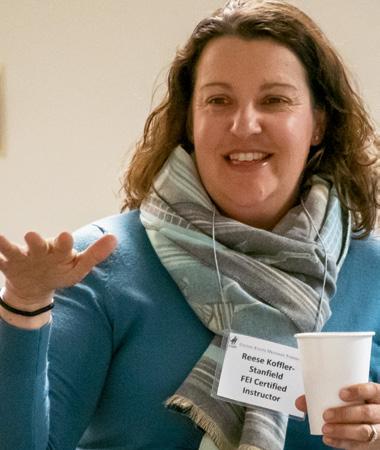
naWave PEMF practitioner.
Many careers intersect with the dressage world, Koffler-Stanfield pointed out. “If you diversify and have multiple income streams, it can help when a lesson gets canceled,” she said. And be open to trying new things, even if they don’t immediately appear to be in your wheelhouse.


“People will ask you to do things,” she said. “Do it. Say yes. You’ll figure it out.”
Figuring it out may be easier if you have certain educational basics under your belt: “I tell young people: Get a two-year business degree. You have to have some business skills.”
Even within her traditional trainer/rider role, Koffler-Stanfield found that it pays to be open to new things. When she began spending time in

42 May/June 2023 | USDF CONNECTION PRIDDY SWEET PORTRAITURE;
COURTESY OF TDF
GRANT RECIPIENTS: YRGP attendees (clockwise from top left) Samantha Fogg, Madison Lareau, Eleanor Millerschin, and Erin Vensel
DIVERSIFIED DRESSAGE PRO: Reese KofflerStanfield
Florida during the winter season, she found that “It’s hard to gain new dressage clients here because most people come with trainers.” Solution: “I’ve expanded my Florida business into ‘flatting’ show jumpers. It’s not that difficult; it’s mostly just helping them turn better.”
Koffler-Stanfield made a plug for USDF instructor/trainer certification, saying that “because I’m FEI certified, it’s opened a lot of doors”—such as the fact that, when people contact the USDF for instructor/trainer recommendations in her area, hers is the only name given because she’s the only USDF-credentialed trainer in her home state. She urged YRGP participants to get certified, even if it means organizing the program in their areas.
Oh, and one more sage piece of advice:
“Don’t go into debt for a horse.”
Business Ethics
In her presentation, Roz Kinstler encouraged the YRGP participants to “maintain a high standard of ethical practices.” Here are her tips—plus a few on making a dressage career one you can live with.

• Don’t take business you don’t want.
• Give every customer 100 percent, whether it’s “a kid on a pony or a U25 rider on a six-figure horse.”
• Stay on time.
• Keep a clear line between friends and business. “No ‘friends discount.’”
• If a client isn’t working out, be polite but assertive. “I’ve had to ask two people to leave. I’m not brave; honest to God, it was a hard thing to do. I told the client, ‘I can’t do what you want me to do. It’s dishonest of me to take your money.’”
• Structure your hours to suit you best. “I ride in the morning and teach later. I ride my horse first so it doesn’t get lost in the shuffle.”
The Wisdom of Experience
When you’re struggling to get a toehold in a new career, it can be enlightening and encouraging to hear successful people’s stories.
David Marcus has a lot of them. The dual US/Canadian citizen had a successful Young Rider career riding for the USA; later, he represented Canada at the 2012 Olympics and the 2014 FEI World Equestrian Games. He left a successful dressage business in Canada to establish himself in Florida, where he now runs Marcus Fyffe Dressage in Loxahatchee Groves with his husband, fellow international dressage trainer/competitor Nicholas Fyffe.
A selection from Marcus’s freewheeling Q&A session with the YRGP participants:
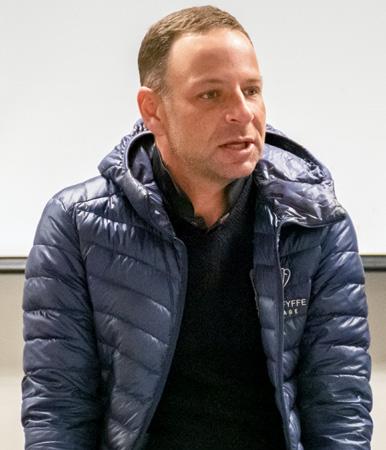
What’s the best way to get started as a dressage pro? Get good horses as young as you can. Make your own horses; show people that you can make something out of a horse. If you can’t do that, be a working student or assistant. Learn how to train. Ride the crap horses. That’s how I got started: When my trainer didn’t want something, I
said, let me have it.
How do you handle the clients who stay home if you go to Florida for part of the year? You have to make sure you are fostering both. Now, with online lessons, there’s a lot more we can do than in the past. When we divided our time between Florida and Canada, we made sure our clients had at least 10 weeks notice. Today, we attract clients who want to go to Florida.
It’s a big investment, and you need to communicate honestly with the client about expectations and goals; but I truly believe that a horse will improve here exponentially for three months versus staying home for three months. Some of it is immersion: How can you not get better riding next to [top people]? I invite people to visit. Florida is addictive. A lot of people came to visit; their horse was on the van the next season.
How do you get sponsorships? You want ones that align with your brand—products that you use and love and need. Product sponsors can be great because products are things that are difficult to invoice for [such as fly spray and grooming products], so it helps our overhead.
What’s your philosophy regarding buying and selling horses? Our business model today is that horses bought have to either advance our careers or make us money.
Deals are hard. I did it more when I was starting out. I used to work for a German guy who imported horses. I would take them on, train and sell them, and then split the profits after he recouped his investment. [Later] I worked the numbers; I lost so much money. When you’re not picking the horses—that’s the hard part of being in sales. I want to choose the horses, be able to stand behind them. [
USDF CONNECTION | May/June 2023 43
PRO AND ORGANIZER: Dressage pro and YRGP presenter Roz Kinstler is also the program’s organizer
PURSUING EXCELLENCE: SEASONED PRO: David Marcus
How do you adjust your pricing as you gain experience? Set your prices as high as you possibly can, because it’s very hard to raise prices. I doubled my training rate after the [2012] Olympic Games, and I lost almost half my clients—but then I made the same amount of money doing half the work.
Location is part of what we do— where business is found. The industry standard allows us to make a living down here, and to charge what we are worth. In Canada, we could only charge a fraction, and I wasn’t really making a living for myself. We were living month to month.
Think about where you can be successful. It might not be here if you want to teach kids or “grass roots” riders.
How do you deal with difficult clients? I have the luxury now of trying to surround myself with clients I enjoy. I want to enjoy my days at the barn. This sport is difficult enough.
Listen to other people. If someone calls you and says a client is difficult or doesn’t pay, listen. Don’t think, “Oh, I can fix that.”
What other types of revenue streams are available to dressage pros? My biggest revenue stream has been my horse trailer. We started with a two-horse bumper pull. We charged the industry-standard rate for hauling to horse shows. That trailer was paid off within 10 weeks. We make a couple grand on it per month. It’s a little money machine.
We did the same thing with our [equine] treadmill. We financed it; then the question was how much to charge for its use.
You want something, I’ll say yes, then figure out what to charge for it—braiding, doing show entries, and so on. Figure out how to make
things worth your while; it keeps clients happy and brings in money. You never know where things will go and how they can grow.
The Value of Sweat Equity
International competitor and trainer Pam Goodrich, who divides her time between Boscawen, New Hampshire, and Loxahatchee, Florida, believes in the apprenticeship method of learning dressage and horsemanship skills: as a working student.

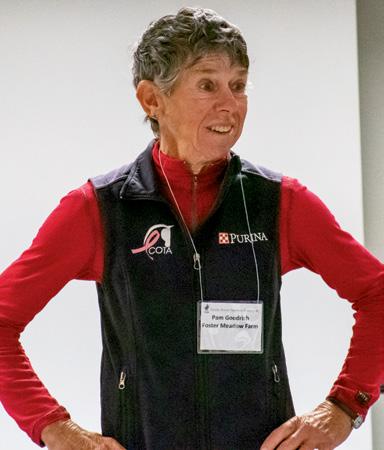
“You must know how to do the work—mucking, feeding, cleaning— not just the mechanics of doing your job; it’s developing the skills you need to do the job,” Goodrich said. “Check your horse; check the stall. At a show, a horse’s performance depends on what he did in that stall. You need to know how to maintain an arena. Those are the things you learn in a workingstudent position.” And a working student “gets to learn without having the responsibility.”
For a mentor, “Find somebody you get along with. Don’t discount someone if they’re not an Olympian. Want to learn to break young horses? Don’t go to an Olympian. They don’t know how to do that and don’t want to do that. Go to a place where that’s what they do. You need to find somebody who knows how to train the basics on all horses. If you don’t know, then you need to be in an all-around place until you do know.”
Goodrich recommends “working for someone first, even if it’s not perfect. It gives experience and exposure
that will make it easier to go out on your own.”
Newly minted professionals face many choices: Lease a facility or buy? What services are the most lucrative?
“If you rent, it’s hard if the owner sets rules you don’t like,” Goodrich said. “If I own it, I make the rules. But it’s a huge responsibility.”
“The bread and butter of the horse business is training and instruction,” she said. “Sales is the gravy. That’s the extra money—the new truck or trailer.”
But “don’t ever buy a horse for resale that, if it dies tomorrow, will make any difference to your bank account.”
Carpe Diem
“When people present opportunities to you, even if they feel scary, just do it,” said 2016 US Olympic team bronze medalist Allison Brock, of Wellington, Florida. “The worst thing that can happen is you go home.”
As an up-and-coming rider with international goals, Brock wanted to work for an Olympian. She worked for Sue Blinks in Wellington for three years, included grooming for Blinks at the 2000 Sydney Olympics, when Brock was just 22. When Blinks decided to move to California, her sponsors, Fritz and Claudine Kundrun, offered Brock a job at their Deer Meadow Farm, where she’s been ever since.
“Sponsors invest in people,” Brock said. “The Kundruns were invested in me as a person, developing me as a person.” Their stallion Rosevelt was Brock’s 2016 Olympics mount.
44 May/June 2023 | USDF CONNECTION
LEARNING FROM THE GROUND UP: Pam Goodrich
RIGHT PLACE, RIGHT TIME: Allison Brock
“Look around. Look at who has long-term sponsors, and who goes flip to flip to flip,” Brock said. “How you treat people matters. People are watching you all the time and watching your behavior all the time.”
Breeding a Foundation
Having started at Hilltop Farm, Colora, Maryland, as a working student and now the farm’s head trainer, the Swedishborn Michael Bragdell has had years of experience in developing young horses, learning about sport-horse bloodlines, and making breeding decisions.

“All foals are cute; it’s hard to tell which will be a Grand Prix horse, although you can start to tell after a while.” Bragdell said. “Ridability is very important. I’m less apt today to want to ride a big trot. A good walk is very important; you can develop the trot.”
Bragdell likes to evaluate babies at about one month of age; after that, “Colts, once they turn one I don’t want to see them until they are three. They get so gawky. Fillies stay so prettylooking.”
Like many professionals, Bragdell prefers either to start young horses himself or to know how and by whom they were started. “When you have training issues…often it has to do with how they were started. You can’t always undo it. I prefer to have them from a young age.”
Promoting Brand You
Raising your profile through effective marketing may help attract clients,
sponsors, or other opportunities, said Johnny Robb, founder of the equinefocused public-relations firm JRPR Inc., Wellington, Florida.
“Marketing is a means to an end,” Robb said. “Your marketing goal is not ‘have a website and social media.’ Your goal is a measurable outcome: have clients, get horses to sell, et cetera.”
That said, “your website is your business card,” while social-media feeds can create engagement and broaden exposure, she said.
Social media are powerful tools, Robb cautioned. “Social media can make you or break you. It can kill you.”
Before you can market yourself, figure out what it is you’re marketing, Robb advised. “Who are you? What makes you special? What is your unique selling proposition?” For some dressage pros, it might be having a knack for training quirky or difficult horses. Others might be great at finding and selling safe, sane mounts. Still others may be great at teaching kids. Most pros have some sort of niche within the dressage world. What’s your superpower?
Everybody wants to attract sponsors, but “remember that sponsorship is for the sponsor,” Robb said. “What can you do for them?” A sponsored rider might be able to act as an influencer, expand the sponsor’s market, point out advertising opportunities, or write articles or create PR pieces, for instance, she said.
Robb’s associate Alex Stark, JRPR’s social-media expert, shared some of her tips. Stark recommended setting up a business Facebook page because it allows for advertising.
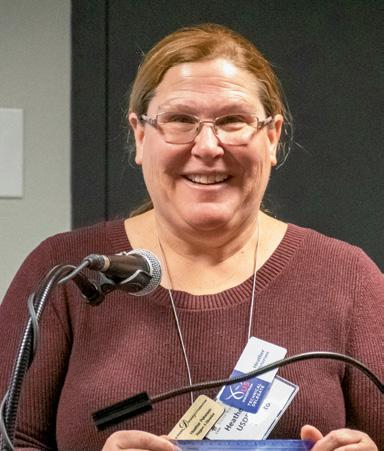
“Schedule your posts. The Instagram algorithm wants posts much more regularly—ideally daily,” she said. “Three times a week is OK for Facebook.” And “Facebook likes photos; Instagram likes videos.”
Stark uses the video editor CapCut to edit clients’ videos, then adds music (whatever’s trending) on TikTok, she said.
Giving Back, Investing in the Future
Several presenters stressed the importance of giving back to our sport.
One way, of course, is financially. Even small donations to The Dressage Foundation (TDF) add up, said Beth Baumert, CEO of the Lincoln, Nebraska,based philanthropic organization. On the receiving end, be sure to review TDF’s list of grants (including ones that helped fund several participants’ trips to the YRGP; see “Funding the Dream” on page 42), and don’t be shy about applying, she said.
USDF education director Kathie Robertson gave an overview of impending changes to the USDF Instructor/Trainer Program. New models and components will begin rolling out this year, she said. One will enable certification candidates “to enter the program at the level you are qualified for and meet the criteria for.” Another change will be the addition of a “professional-development component, geared toward those who want to become certified.” The new model “will connect people with mentors to help guide you through the certification process,” with a goal of streamlining the process from application to certification.
Dressage also needs licensed officials. Becoming an LO “is more about giving back to the sport than
USDF CONNECTION | May/June 2023 45
SPORT-HORSE EXPERT: Michael Bragdell LICENSED OFFICIAL AND ACTIVE RIDER: Heather Petersen
anything,” said Heather Petersen, of Elbert, Colorado, who in addition to her roles as USDF Region 5 director and a show manager is a USEF “R” technical delegate (TD) and an FEI Level 1 steward. Earning a TD’s or judge’s license “is not profitable for the first few years,” Petersen admitted, but for instructors, “your teaching will be greatly enhanced because of what you will learn.”
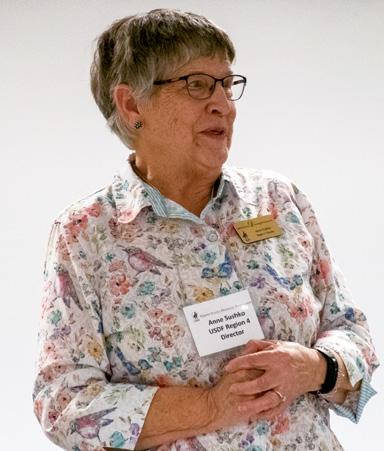
Other benefits, she said, are travel, education, opportunities for continued growth, a way to stay involved with the sport for life, and “longlasting networking and friendships.”
Petersen outlined the process of becoming a TD, and she encouraged everyone in the room to enroll in the USDF L program. Smart strategies, such as using travel credit cards to pay for airfare and hotels, can earn free flights or hotel nights to help offset attendance costs, she said.
Another financial strategy that instructor/trainers who are judges can use: “You can go for a weekend to judge [a show] and then stay a day to give a clinic” at a nearby facility.
At 45, Petersen said, “I am probably one of the youngest TDs we have, and I have been doing this for 13 years. I have been running horse shows for 20 years. It can be a great career, and I still ride and I still compete. I’m down here [in Florida] for the winter, training. You can still be a coach and still compete.”
“Many ‘S’ judges and TDs will be close to retirement in the next 10 to 15 years,” Petersen said. “We need people to get involved, to keep the sport going.”
Likewise, “We desperately need show managers and show secretaries to build up,” said Debra Reinhardt, of Loxahatchee, Florida. A USEF Level 5 secretary and manager and the owner of Centerline Events, she discussed
these careers along with fellow Level 5 official Sue McKeown, of Worcester, Massachusetts.
“I don’t find management that hard,” said Reinhardt, whose shows include the Great American/USDF Region 8 Championships and who is the secretary for the US Dressage Finals. “It takes organization. I love it. It’s my drug. I get a high. I get so excited; I want to make the show perfect.”
Show secretaries need computer skills, people skills, and a positive attitude, said McKeown, who has served in a managerial or secretarial role at the Region 8 Championships and the US Dressage Finals, among others. And “you must know the USEF rule book.” Both she and Reinhardt also recommended a thorough study of Show Biz, the USDF’s online guide to running dressage shows.
“I am retired from my full-time job,” said McKeown, “and [working as a show manager and secretary] is absolutely my retirement income. Giving back to the sport is so rewarding.”
Rounding out the volunteerism discussions were USDF executive director Stephan Hienzsch and USDF Region 4 director Anne Sushko. Sushko, a retired middleschool teacher from Dubuque, Iowa, is enjoying a second career as a volunteer: Besides serving on the USDF Executive Board, she volunteers on USDF committees, at USDF conventions, for The Dressage Foundation, and in her community.
Hienzsch said that volunteering served as the springboard to career opportunities. As an athlete in his original sport, skiing, he took a volunteer coaching position, “which led to an assistant-coaching position, which led to being head coach, then program director, and eventually led to my applying to be executive director in an-
other sport….It wouldn’t have happened had I not taken a volunteer position when given the opportunity.
“When you are presented with an opportunity,” Hienzsch concluded, “you should consider saying yes because you never know where it might lead.”
“The opportunities you have today were shaped by volunteers,” Hienzsch said. “The US Dressage Finals, the Regional Championships—all were conceived by volunteer groups. The Finals organizing committee is volunteers who work year-round to make that thing happen. There is [USDF] staff support, but without the volunteers, the sport really wouldn’t exist. Even the Young Rider Graduate Program was created by a group of volunteers who said, ‘Hey, we need this—something to fill the gap. Something to help young people navigate the waters.’”
“Being a volunteer,” said Sushko, gives a person “a choice of what you want to do—choosing something that makes you happy, that makes you feel you are giving back some part of your life.
“Choose to be grateful,” she continued, “because you are truly a blessed generation, and you are truly a blessing to our sport. Be part of our sport. Share your love; share your passion.”
46 May/June 2023 | USDF CONNECTION
Jennifer Bryant is the editor of USDF Connection.
GIVING BACK: Anne Sushko
EQUITATION REGIONAL FINALS

presented by Big Dee’s Tack and Vet Supply
USDF Adult Amateur Equitation Regional Finals classes are held in conjunction with the Great American/USDF Regional Championships.
For more information visit WWW.USDF.ORG
USDF ADULT AMATEUR
YOUR CONNECTION TO DRESSAGE EDUCA TION • COMPETITION • ACHIEVEMENT
EE’S EE’S BIG TACK & VET SUPPLY BIG
T ough L ove
The members of the FEI Judges Supervisory Panel were discerning critics at the 2023 Adequan®/ USDF FEI-Level Trainers Conference, but their motivation is love of the horse and the sport
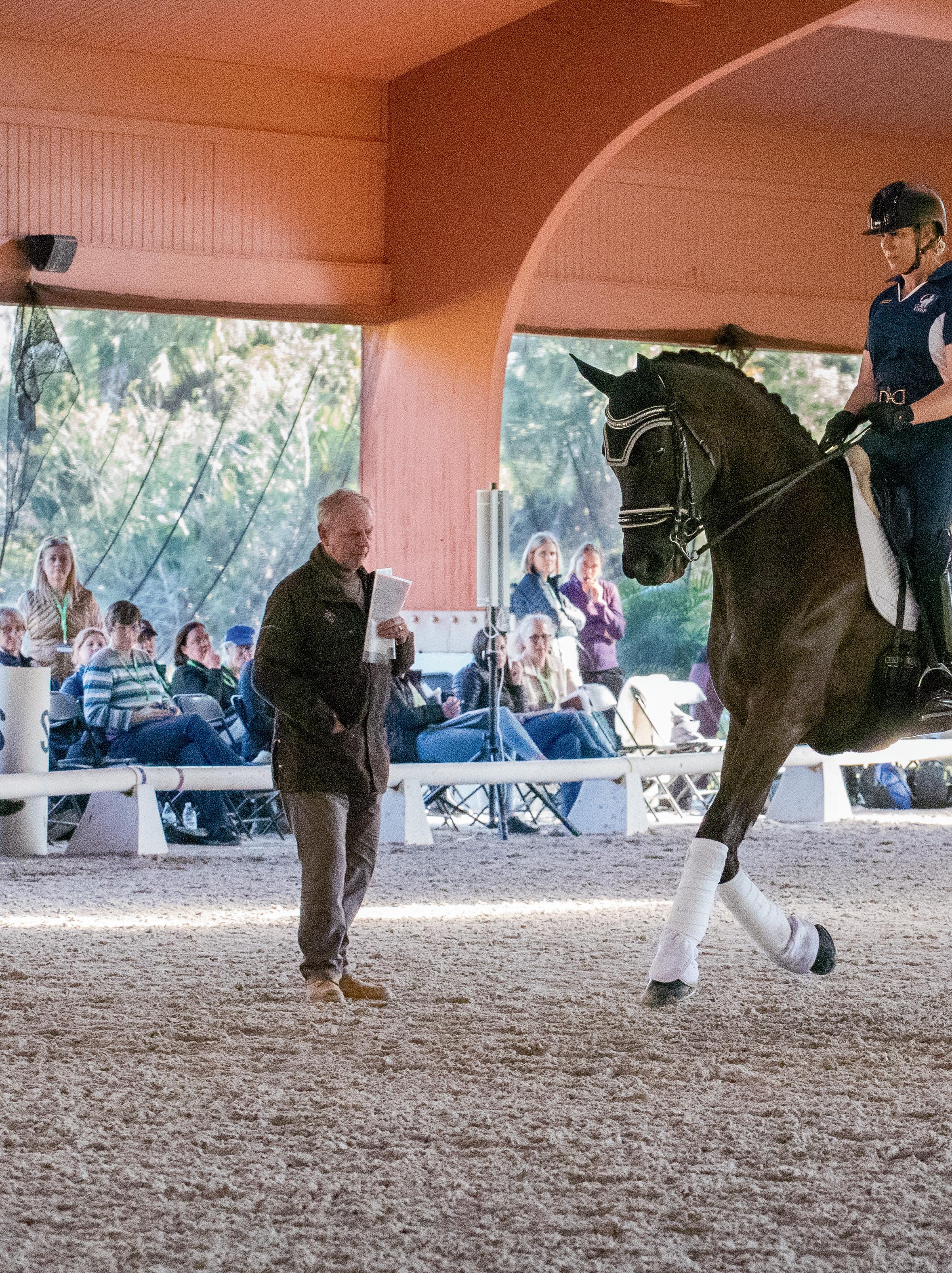 STORY AND PHOTOGRAPHS BY JENNIFER O. BRYANT
STORY AND PHOTOGRAPHS BY JENNIFER O. BRYANT
48 May/June 2023 | USDF CONNECTION
The FEI Judges Supervisory Panel (JSP) shares a common purpose, but its members come from vastly different backgrounds and have equally divergent dressage-training methods, although their aim is the same.
The USDF was honored to welcome four JSP members as the clinicians for the 2023 Adequan®/USDF FEI-Level Trainers Conference. The January 16-17 event, held at Mary Anne and Walter McPhail’s High Meadow Farm in Loxahatchee, Florida, was the first since 2020.

The Unsparing Eye
For presenter David Hunt, dressage training is all about the details—and no detail escaped him. Here are a few of his memorable observations:
“It has to be your trot, not his.”
“Don’t let him poke his nose out when he feels like it. You’re the decision-maker. He must learn to ‘cough on the bit.’”
“To get to where [this rider] wants, she has to get a lot more control of the situation.”
“If you don’t address these problems now, you’ll have bigger problems later.”
“We want a nice, natural trot—not too artificial or elevated.”
“Your walk looks like a funeral march. The horse must march with contact. Don’t slow down from contact.”
“You can’t sit there trying to be Little Miss Perfect. You have to form a relationship. You have to be the boss. You have to analyze each time whether you were satisfied with that transition. There isn’t going to be someone with you every time, so you have to learn to be self-constructive.”
“Push the canter forward. Don’t squeeze. Little nudges with your legs. Don’t ‘row’ him. You’re not rowing a boat. Push him into the bridle when he argues with you. Push him into the resistance.”
“The best way to ruin a horse is to try not to ruin a horse. You’ve got to get him there. When he’s dripping along like a half-dead camel, it’s not going to work. If you want to get somewhere, you’ve got to take ownership of what you’ve got.”
“No, no, no! Don’t let him walk away! Your walk, not his. Actually, my walk, not yours.”
“A pirouette is a canter circle, not more. It gets stilted and the rider thinks, ‘Oh, this is a pirouette,’ and starts humping the saddle. Some people think a canter
USDF CONNECTION | May/June 2023 49
TOP TRAINING: Trainers Conference presenter Henk van Bergen works with demonstration rider Lehua Custer on F.J. Ramzes
Meet the Presenters
Created by the Fédération Equestre Internationale (FEI) in 2011, the Judges Supervisory Panel (JSP) comprises a select group of FEI dressage judges and trainers. Utilized primarily at such major international dressage championships as Olympic Games, World Championships, and World Cup Finals, the JSP has a technical-review function: Within designated limits, it can adjust the score for an individual movement up or down if a judge has either “missed a clear mistake” (such as the count in a line of tempi changes) or incorrectly penalized a competitor for a mistake that did not occur.
The 2023 Adequan®/USDF FEI-Level Trainers Conference presenters are all JSP members.
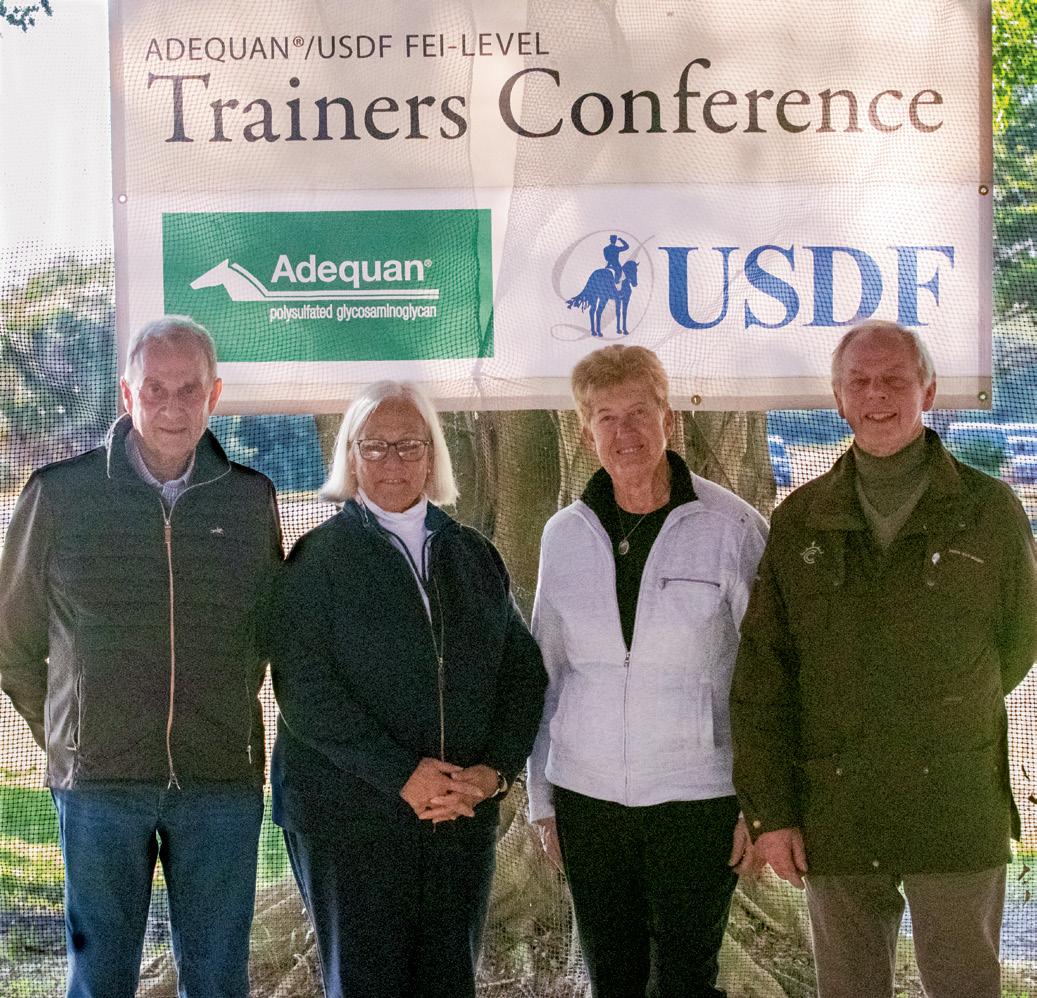
David Hunt is an international trainer/rider from Great Britain and the current president of British Dressage, Great Britain’s national dressage organization. He is the president of the International Dressage Trainers Club and a founder of the JSP. Before he focused on dressage, he trained numerous top-level event horses and riders, including HRH Princess Anne of Great Britain.
Henk van Bergen is no stranger to the Adequan®/ USDF FEI-Level Trainers Conference, having headlined solo in 2009. The renowned Dutch instructor/trainer has coached dressage athletes at multiple Olympic Games and has served as the Dutch national dressage trainer.
With her legendary partner Fellow Traveller, Roemer Foundation/USDF Hall of Fame member Linda Zang was a member of the US dressage team at the 1980 alternate Olympics. Her Idlewilde Farm in Davidsonville, Maryland, was for years a hub of US dressage training with then-US team coach the late
pirouette should feel different. It’s a canter.”
“You will get little resistances. That’s training.”
“Your seat just holds the balance; it doesn’t influence the forward impulsion.”
“Feel, don’t watch [in the arena mirror]. Feel what he feels like.”
Sympathetic Training
If The Hunt-van Bergen Show were a TV crime drama, Hunt would play the bad cop against Henk van Bergen’s good cop. Demonstration
Col. Bengt Ljungquist of Sweden. She has judged at such prestigious competitions as the 1996 Atlanta Olympics and the 1998 and 2006 FEI World Equestrian Games.
Fellow Roemer Foundation/USDF Hall of Fame member Lilo Fore, of Santa Rosa, California, is a longtime co-chair of the USDF Instructor/Trainer Committee and an examiner in USDF’s certification program. A native of Germany, she has judged at World Equestrian Games, World Cup Finals, and many others. She frequently serves as a moderator at Trainers Conferences and has presented at multiple past events.
riders’ egos may have taken a bit of a beating over some of Hunt’s withering pronouncements, but interspersed with those was van Bergen’s “kinder, gentler” approach.
Examples:
“The main objective of dressage training is balance. Balance is a combination of rhythm and position.” (By rhythm, he meant rhythm + tempo; position referred to the horse’s longitudinal and lateral positioning.)
“Before I can influence the rhythm, the horse must be forward
and understand my leg aids.”
“Transitions are probably the best exercise for getting influence over the horse.”
“You can’t correct a weakness with all kinds of tricks. The only people you impress are the ones without knowledge.”
“The secret to good teaching is to make it simple. Some instructors explain about ‘Look how much I know’ rather than saying it in a way that the rider understands.”
“The half-halt…only works when the horse is pretty nice[ly] accepting
50 May/June 2023 | USDF CONNECTION
THE PRESENTERS: 2023 Adequan®/USDF FEI-Level Trainers Conference clinicians David Hunt, Linda Zang, Lilo Fore, and Henk van Bergen
the bit. It’s a fine-tuning aid. It is a signal to the horse to do something to remain in balance.”
“Maintain the trot rhythm. Just regular trot in all movements. The same trot, all the time.”


“Every exercise has three parts: the preparation, the exercise, and the finish.”
“The corner is your friend or your enemy. It makes the horse better or worse.”
“There comes a moment in your riding when you have to accept the weak points of your horse [and not keep pushing it to do what it cannot].”
“Be careful going to the walk as a break when there is tension or problems. You’ll ruin the walk. The walk needs relaxation and stretch.”
“If the horse is nicely trained, he gives the nice feeling that he wants to touch the hand of the rider. It’s like walking with your partner: You walk side by side and touch hands.”

“Do the opposite of what the horse wants” (e.g., if he hurries, slow his tempo. If he wants to be too
high in the neck, ask him to stretch forward-downward).
“Stopping [the work] is the biggest reward to the horse. Don’t just pat him and keep going, asking over and over.”
“When training tempi changes, stop when you feel you are losing influence.”
“Luckily, judges are looking more and more to the nice, natural way of moving, and less to the spectacular legs flying all over the place.”
Training Wisdom from Zang and Fore
Although Hunt and van Bergen did the majority of the presenting,
USDF CONNECTION | May/June 2023 51
CLOSED UP: Fox Creek’s Censational likes to get a little long in the frame, with his hind legs out behind. Work toward piaffe helped the German Riding Pony stallion learn to bring his haunches under his body and shift his balance.
PROMISING PARTNERSHIP: Feymar OLD is “such a good horse” with “fantastic movement,” Henk van Bergen told owner/ rider Kimberly Herslow
PAS DE DEUX? No, it’s the mirror reflection of the talented F.J. Ramzes, ridden by Lehua Custer
One on One with the Conference Presenters
At the conclusion of the 2023 Adequan®/USDF FEI-Level Trainers Conference, presenters David Hunt, Henk van Bergen, Linda Zang, and Lilo Fore shared their thoughts on the event and elaborated on a few points.
“We didn’t want it to be a ‘normal clinic,’” Fore said of the conference format. As members of the FEI Judges Supervisory Panel (JSP), the presenters wanted to demonstrate the interplay among training, riding, and judging, she said—and to show how judging influences the sport.
“We as JSP, that’s part of our job: to direct the sport,” said Hunt. “If we see it going in a way we don’t like, then it’s our job to put it back, and make sure it gets in the right direction.” To accomplish this, he said, JSP members hold discussions and attend FEI seminars for top-level dressage judges, where they may caution the judges to “‘Be careful; some of these horses are getting too climb-y and too unnatural,’” for instance.
Judges today want to see horses moving naturally, not with extravagance caused by tension. The difference, said Hunt, depends on “whether the rider is creating it or if the horse is naturally within its own self.”
“If due to tension, the horse cannot be through,” added Fore. “It becomes fake and false.”
The presenters praised US 2020 Olympic team silver medalist Sanceo, ridden by Sabine Schut-Kery, as
an example of a naturally extravagant mover. “I thought Sabine’s performance at the Olympics was lovely—very correct, natural, elastic,” said Zang.
Another they love is reigning dressage world champion Glamourdale, ridden by Charlotte Fry of Great Britain. Fore called the stallion “an amazing, sensitive, hot horse, but she rides it with feel, and tactful. She allows the horse to be within his own balance, so she still has all that fancy motion but it is on the rider’s aids. That is why it’s so gorgeous.”
Knee action alone is not desirable extravagant movement for dressage, said Fore.

“If you have a Saddlebred, that’s how they move naturally,” she said. “But the way we train dressage horses, what we want is not that. It’s not knee action—legs up and down. The moment you throw the legs up like that, the hind legs are out the back door.” And since the horse’s back is usually also down and tight in such cases, “You’re sitting on a trampoline.”
Although the JSP members know one another well and have worked together at many competitions, the Trainers Conference was the first time that this group had collaborated so closely on a training project and gotten to spend so much time together, they said. They expressed satisfaction that their methods and views meshed well.
with one or the other working solo with each demonstration pair, JSP members Linda Zang and Lilo Fore contributed astute observations that illuminated the training discussions.
Many of Zang’s points concerned equitation and biomechanics. She recalled a time early in her dressage career when she took three horses to train with the late German master Herbert Rehbein:
“He made me do nothing but transitions—trot-halt, canter-walk— for a week. I think I lost 35 pounds and I was in pain, but I learned how to be straight in my position so the horse could come straight through.”
Other takeaways from Zang:
“The inside rein and leg are [used for] throughness and direction; the outside rein and leg are [for] collection. You stay up and allow the horse to come up willingly.”
52 May/June 2023 | USDF CONNECTION
CHANGING THE OUTLINE: Like many Iberian horses, the PRE stallion Amado XXXV likes to shorten his neck and topline. Skilled riding by owner/rider Cindi Wylie helped him to develop reach and elasticity in a longer outline.
Zang noticed a correlation between one rider’s rein aids and the horse’s occasional opening of the mouth. The rider, she observed, “turns with a bit of indirect outside rein, shifting the hands to the inside, to pick up the horse’s shoulder. That’s when the horse opens its mouth. Just sit straight with your hands steady.”
She instructed another rider to “ride up to the outside shoulder. The outside shoulder is the horse’s point of balance.” As the horse progresses in its dressage training, she explained, the inside hind leg reaches up and under the horse’s body (i.e., goes in shoulder-fore positioning). Then “the horse connects to its outside shoulder and the outside rein. The outside rein and leg are used for straightening.”

Fore’s years of experience as an instructor/trainer made her an ideal choice for fielding audience questions. Standouts included:
Do judges frown on a horse that grinds its teeth? It doesn’t bother
me unless other things are going on. Sometimes it’s a sign that the horse is thinking and trying hard.
Do you agree with the FEI’s requiring a double bridle and spurs in certain CDI divisions? I rarely have seen a horse that does not learn to accept a double bridle. As for spurs, it’s how you use it.
it is not impulsion any more. The horse had to go more forward, even if the balance was not quite right. Sometimes you have to break something to make something. A horse has to go forward before you can change the balance; you need energy and impulsion. If you keep him going forward, there will come a point where he lifts himself up.
When should you practice an exercise off the track instead of along the rail? Ride away from the rail if the rail is like a magnet. Challenge yourself and your horse: Can you stay straight while riding three feet off the track?
Why did the presenters ask one rider to go more forward, even though the horse was too “down” in front? When a horse pulls down,
How do you determine the amount of bend needed to ride a corner? Make the corner your friend. It’s an amazing tool to learn to collect the horse. But you need vertical balance between the rider’s legs—not so much bend that the horse can’t handle it.
What causes a lateral walk? A lateral walk is usually the result of the hind legs overtracking like hell but the shoulders are retracted. Ride every single step: 1-2-3-4, 1-2-3-4.
Exercises from the Masters
Those who attend the Trainers Conference are sure to go home with
USDF CONNECTION | May/June 2023 53
QUIETING THE TENSION: The extravagant-moving stallion King’s Pleasure was tense in the arena. Quiet guidance through gymnastic exercises by rider Endel Ots led to some lovely moments.
The definition of dressage is the systematic development of the natural abilities of the horse.
—Henk van Bergen
new approaches and exercises to address various training issues. File these away for use with your own mounts.
Horse tends to hurry in the walk, with his hindquarters out behind but taking short steps in front. Hunt had the rider shorten the walk steps into half-steps or piaffe to close up the horse’s hindquarters while encouraging freer movement in front. “He needs to walk shorter, not faster,” Hunt said. “Shorter, smaller walk into piaffe. Slower. Don’t walk so fast.”
Pirouette problems. It took even some of the most experienced riders and trainers a while to catch on to what Hunt was saying about how people overcomplicate the preparation and execution of canter pirouettes. His main point: The canter should remain the same before, during, and after the movement.


“Let the pirouette collect the horse,” he told one rider. “You have two completely different canters. All the exercises you do must not take away from the horse.”
In developing a pirouette, “Make a five-meter canter circle—just canter—then bring the haunches in.”
“Ride forward, forward, forward” in the pirouettes, said Hunt. “You should be able to come out at any time. Come in [to the pirouette] in
shoulder-in, not in haunches-in.”
Getting control over the flying changes. “If he doesn’t accept your support,” said van Bergen, “you don’t do the change. Don’t allow the horse to take over. You must influence the horse. Be the leader; otherwise you become a passenger.”
Dealing with the tense or spooky horse. “You need to make him go where you want before you can get him to go how you want,” Hunt told the rider of a horse that was visibly tense and wanting to avoid certain places in the arena. “When he speeds up in the corners, he’s running away from you. Don’t pump him. Just sit quietly with your seat and let him take you.”
The neck is short and tight. “There’s no point trying to get the neck out until you get the hind leg. The hind leg pushes the neck out,” said Hunt.
“This is a situation where a lot of you probably don’t agree with me,” he continued. “I see the neck. But until the rider gets control over the horse’s body, you can’t get the neck. The horse has energy and balance and suspension, but he doesn’t have them all in the right order.”
Trot-canter-trot transitions
are stilted. It’s all about softness in the poll, said van Bergen. From the canter, “When he is absolutely soft in the poll, you allow the first trot step. Feel the first trot step in your seat, not in your hands.”
Horse falls toward the new inside shoulder in turns or bend changes. Try van Bergen’s exercise: Trotting on the right rein, begin a three-loop serpentine, width of the arena, from A or C. Over the first center line, think of riding a couple of steps of half-pass right (or leg-yield right, for a less-advanced horse) before bending left to make the second serpentine loop. Then, over the second center line, halfpass or leg-yield left a couple of steps before bending in the new direction. The objective is not to make textbook half-pass steps, he explained, but to maintain the horse’s balance.
The same concept can be used in training flying changes over the center line in a serpentine pattern: “You can imagine, if you do your first turn and you come to the center line, and the horse is already leaning to the left and he has to do the flying change to the left [from right-lead canter], he falls completely on the
54 May/June 2023 | USDF CONNECTION
FOCUS ON PIROUETTES: The training and riding of canter pirouettes received much attention during the conference. Henk van Bergen coaches Kristin Stein on Elbrasco – L.
PLEASING PICTURE: International competitor and USDF-certified instructor Chris Hickey on Valentin
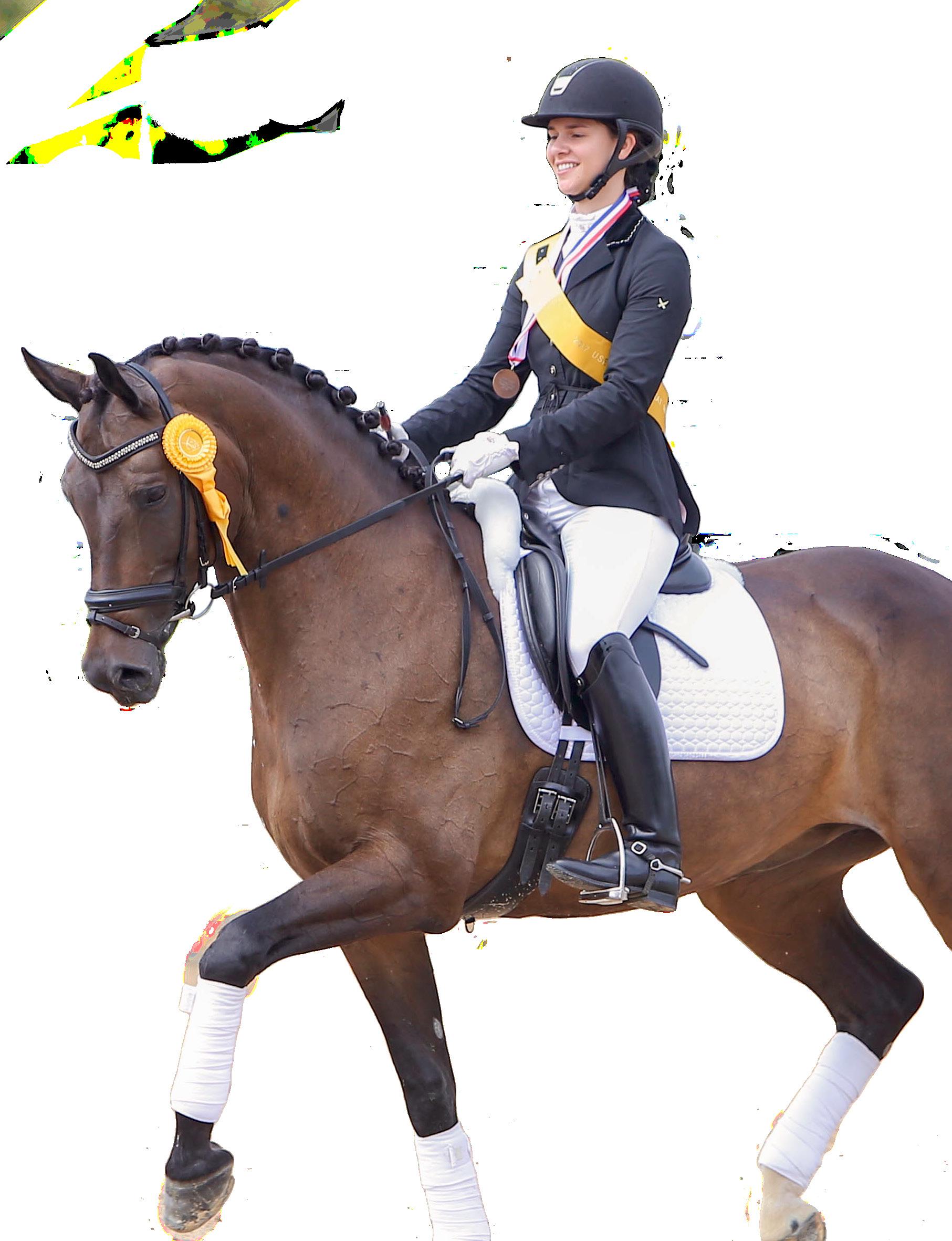
For information on qualifying and locations, visit www.usdf.org For rider divisions 13 and under, and 14 to 18. YOUR CONNECTION TO DRESSAGE EDUCA TION • COMPETITION • ACHIEVEMENT
USDF DRESSAGE SEAT MEDAL SEMI-FINALS
Photo by Emma Miller
The USDF is thankful for the contributions of those who helped to make the 2023 Adequan®/ USDF FEI-Level Trainers Conference a success:
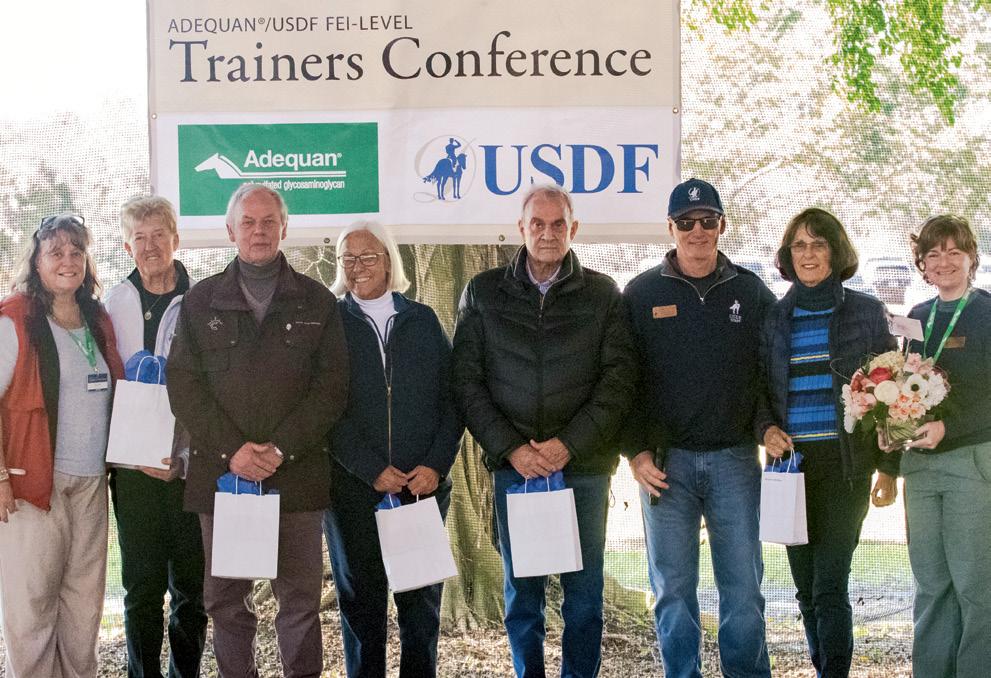
Title sponsor: Adequan®
Host: Mary Anne McPhail, High Meadow Farm, Loxahatchee, Florida
Dressage4Kids and all of the volunteers.
And to the demonstration riders and horses who showed us excellent dressage over the two days:
Lehua Custer, Wellington, Florida, and F.J. Ramzes, a KWPN gelding by Juventus and owned by Wendy Sasser
Kimberly Herslow, Stockton, New Jersey, and her own Feymar OLD, an Oldenburg mare by Fürstenball
Christopher Hickey, Wellington, Florida, and Valentin, a Swedish Warmblood gelding by Dalwhinnie and owned by Cecelia Stewart
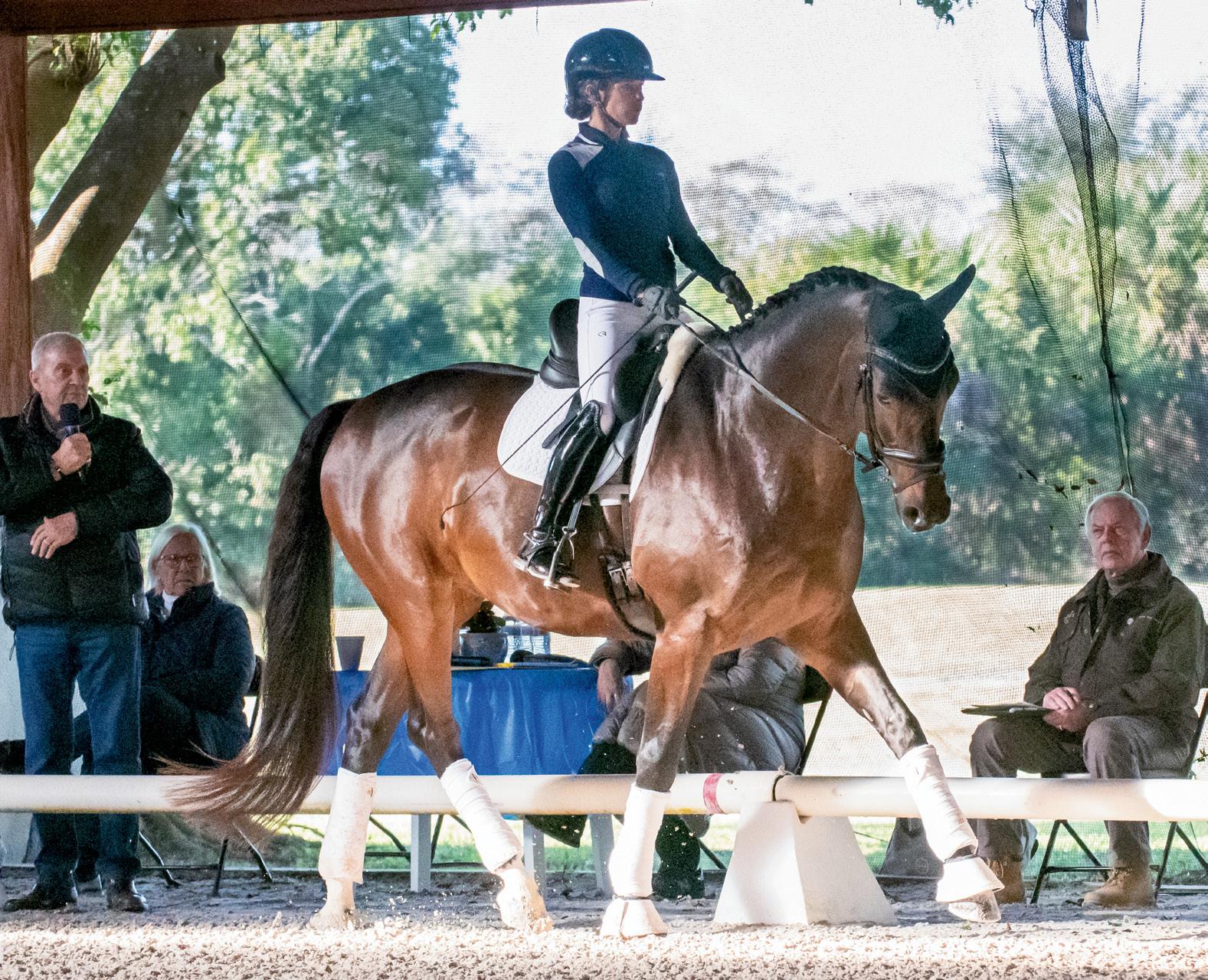
Jan Lamontagne, Loxahatchee Groves, Florida, and her own Kentucky, a Dutch Warmblood gelding by Lord Leatherdale
Anna Merritt, Ocala, Florida, and Fox’s Creek Censational, a German Riding Pony stallion by Caramel and owned by Dianna Orona
Endel Ots, Wellington, Florida, and King’s Pleasure, a KWPN stallion by Dark Place and owned by Heidi Humphries
Cindi Wylie, Palm Beach Gardens, Florida, and her own PRE stallion, Amado XXXV
forehand,” van Bergen said. “So you make the turn, and you put him in that right canter a little sneaky sideways to the right; it brings also the weight to the right shoulder—so you make the inside shoulder free for the change.”
Horse anticipates the flying changes in the canter “zigzags.” “Between the sideways parts is a complete exercise,” van Bergen noted. “Go sideways; then flex to the new inside. Don’t allow the horse to make the flying change from the change in flexion. He must wait for the leg aids.”
56 May/June 2023 | USDF CONNECTION
Kristin Stein, Wellington, Florida, and Elbrasco –L, a KWPN gelding by Ampere and owned by Sally Alksnis
Jennifer Bryant is the editor of USDF Connection.
THANK YOU! Flowers for Trainers Conference host Mary Anne McPhail (second from right) and gift bags for presenters Lilo Fore, Henk van Bergen, and David Hunt from USDF education director Kathie Robertson (left), USDF executive director Stephan Hienzsch (third from right), and USDF senior education coordinator Sarah Delahanty (right)
In Gratitude
SETTING BOUNDARIES: Clarity of purpose from owner/rider Jan Lamontagne brought out the potential in her Dutch Warmblood gelding, Kentucky
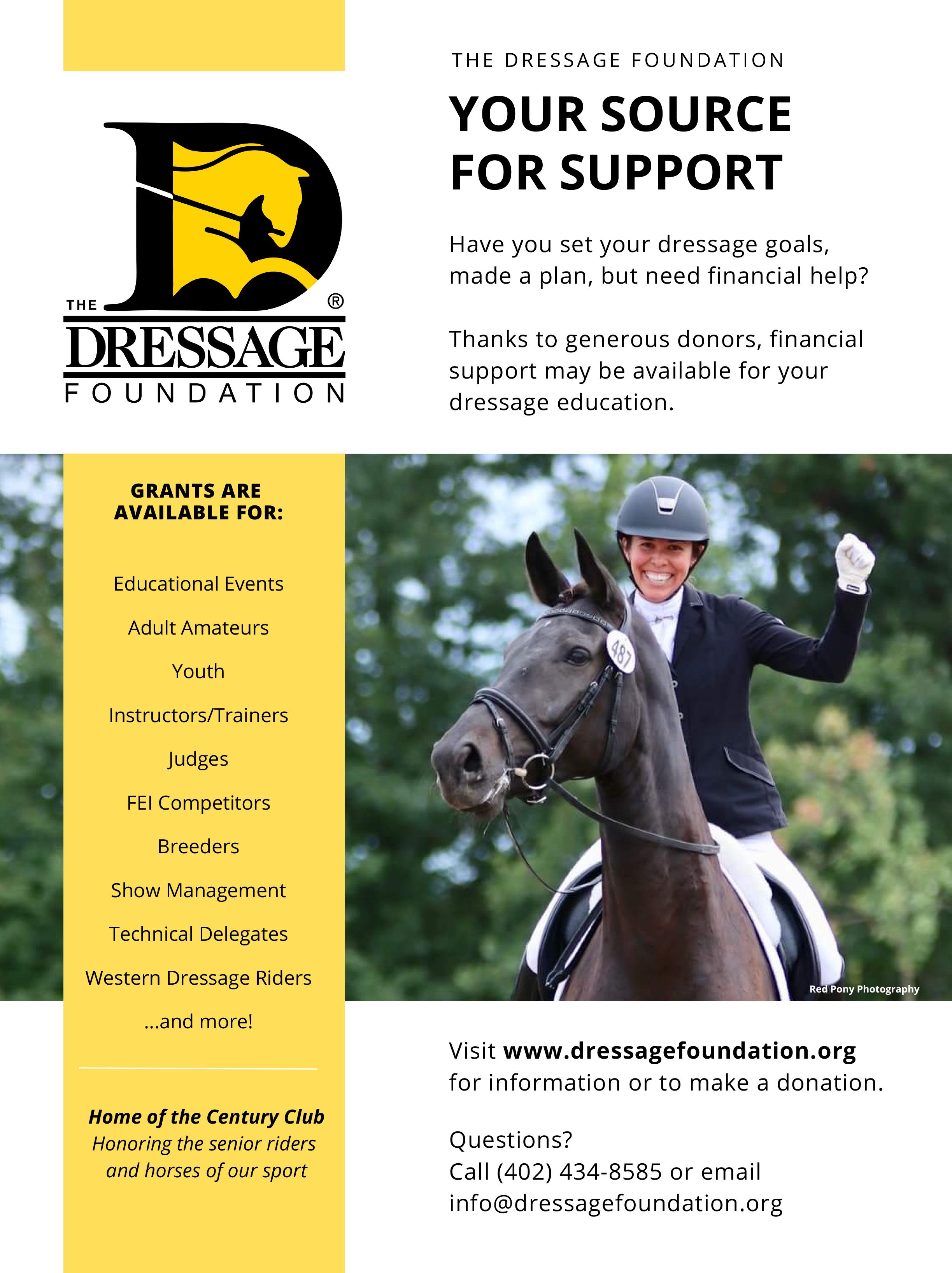
Between the Golden Ears
Ecogold’s Performance Ear Bonnet combines technical features with fun color accents to finish your show-ring look—or to mix and match for everyday use.

A Green Spring
Fresh looks and eco-friendly solutions
The bonnet’s noise-reducing ear panels are lined with stretchy Lycra, and the high-tech airflow fabric is breathable and easy to wash. Choose from 10 accent colors (shown: pink). All bonnets sport Ecogold’s unique gold-tipped ears.
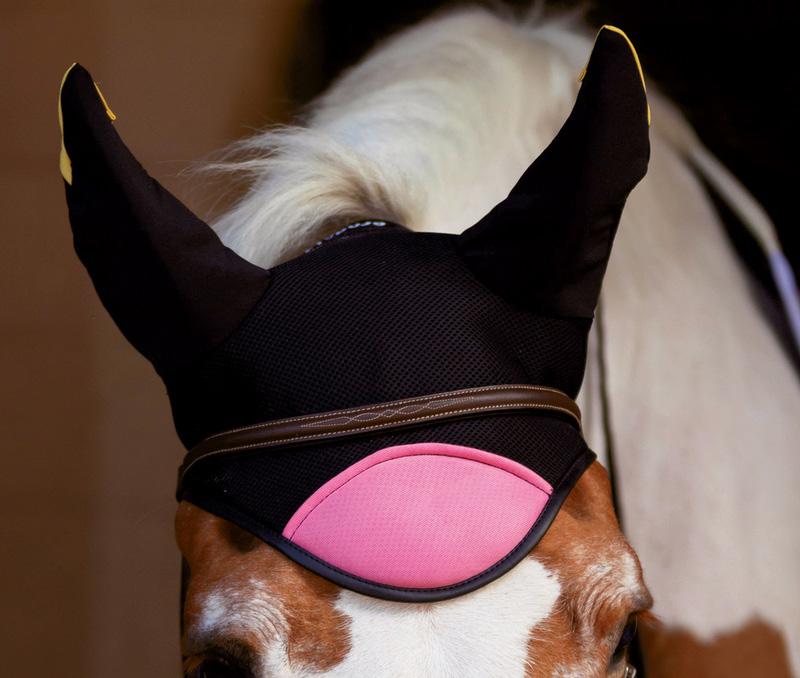
Learn more: Ecogold.ca.
Your Show Look, Your Way
Custom-design a show jacket or tailcoat to your heart’s content using the FH Custom Lab, the online configurator of For Horses LLC, designer of fine Italian-made riding apparel.
For dressage, the Cristina Custom Show Jacket, the Jenni Tailcoat (pictured), and the Cecilia Custom Junior Show Jacket all can

be configured to the last detail. Options include jacket color, collar and pockets color, piping color and style, button style (and number of buttons on short jackets), logo, and crystals. All are made using technical performance fabrics that offer UV protection, temperature control, and Iperbiflex technology for exceptional freedom of movement.
Learn more: ForHorsesUSA.com.
You Can Lead a Horse to Water…
…but you can’t always make him drink. It’s the bane of horse owners everywhere.
When your horse really should drink but won’t—the unfamiliar water at a show tastes funny, he’s travel-stressed and too distracted, it’s hot and he needs to hydrate after working—try making his water irresistibly tempting by mixing in a convenient packet of Gallagher’s Water.
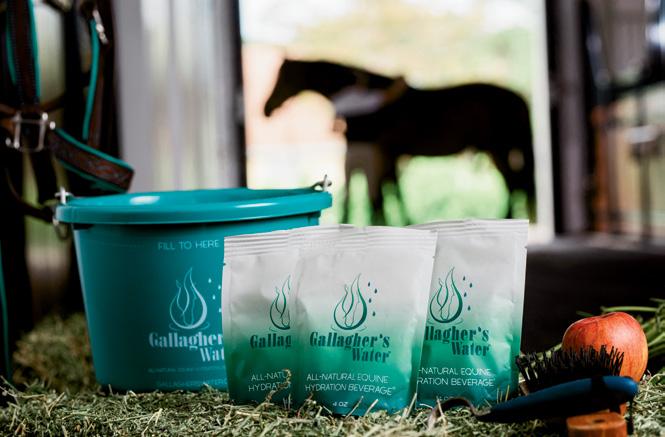
Gallagher’s Water is an allnatural flavor-enhancement powder designed to encourage horses to drink water. The formula includes premium alfalfa, sugar (just 2% of a
horse’s daily sugar intake), and electrolytes. The product was originally developed to encourage Gallagher, a sugar-intolerant Irish Sport Horse gelding, to drink more water while traveling.
Learn more: GallaghersWater.com.
Boot up with Ariat
Dressage styling meets comfort and performance in the Ariat Kinsley Dress Boot for women. Handcrafted from premium full-grain leather, the Kinsley Dress Boot features an elegant Spanish top, a stylish toe cap, full leather lining, a full-length elastic gore panel on the lateral side, and a behind-the-knee mobility curve for protection and comfort. Of course, it also has Ariat’s famous ATS lightweight forked shank for enhanced support and a Duratread sole with rider-tested traction zones.
The Kinsley, which is also available as a field boot, is available in three shaft heights and six calf

58 May/June 2023 | USDF CONNECTION
Tack Shop
widths, in shoe sizes from US 5.5B to 11B.
Learn more: Ariat.com.
Green Manure Management
Be kinder to the environment—and maybe save some money, too—by installing a manure-composting system.

The secret sauce in the manuremanagement solutions from O2Compost is aeration by means of an electric blower—no need for laborious turning. Proper aeration gets the pile hot enough to significantly reduce odors, kill fly larvae and weed seeds, and dramatically reduce the “cooking time.”
O2Compost offers composting systems to suit any size facility and any type of livestock. An efficient system can dramatically reduce or even eliminate the costs associated with manure removal. Some facilities use the compost to enrich the soil in their own pastures and gardens, or even bag and sell the excess.
Learn more: O2Compost.com.
All-in-One Protection Against Bugs, Sun, and Rain Showers
Changeable springtime weather means that horse owners must be prepared to contend with sun, rain showers, and the annual resurgence of annoying insects. New in Horseware Ireland’s ECO Collection is an eco-friendly spring-intosummer sheet, the Amigo AmECO Combi.
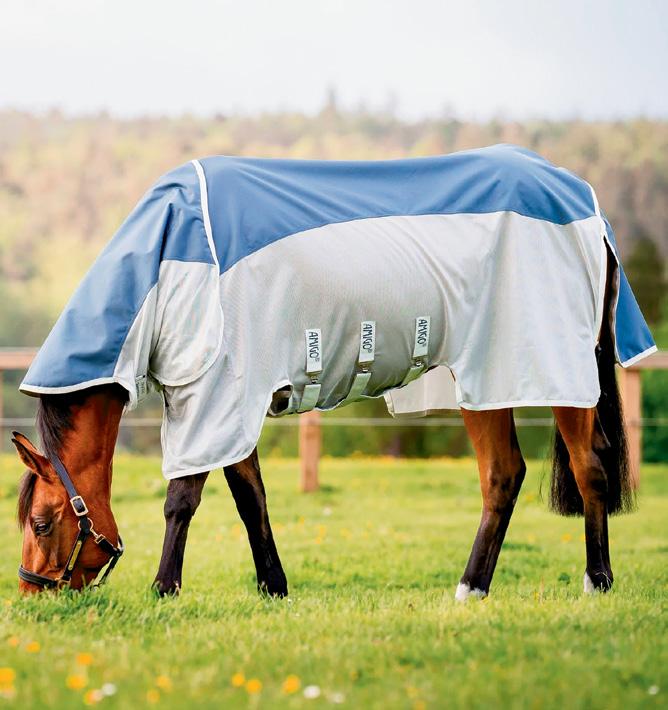
The sheet combines a waterresistant upper layer with breathable mesh sides and chest, and it comes with a detachable neck cover. It also offers UV protection. The fabric components of the AmECO Combi,
like others in the ECO Collection, are made of recycled polyester from plastic bottles—an average of 188 recycled bottles per sheet!—a green choice all the way around.
Learn more: Horseware.com.
Hydrogel for Equine Osteoarthritis
A hydrogel product that’s been used to manage arthritis in horses worldwide for more than 10 years is now available on the US market.
Protection for the Barefoot Transition
Many dressage riders have embraced the benefits of letting their horses go barefoot. But some horses need hoof protection during the transition, and even established barefoot horses may need a little extra help in certain situations, such as when walking or standing on gravel or during transport. Still others just don’t do well in conventional horseshoes and need an alternative means of hoof protection, or need protection while a hoof ailment or injury is being treated.
Arthramid Vet by the European company Contura Vet is a steroidfree polyacrylamide hydrogel product labeled for all stages of osteoarthritis in horses. After intraarticular administration by a certified veterinarian, a biocompatible hydrogel matrix forms in the joint capsule, thereby stabilizing the joint and synovium and increasing the elasticity of the joint. According to the manufacturer, clinical studies showed 82.5% successful resolution of joint lameness for up to 24 months.
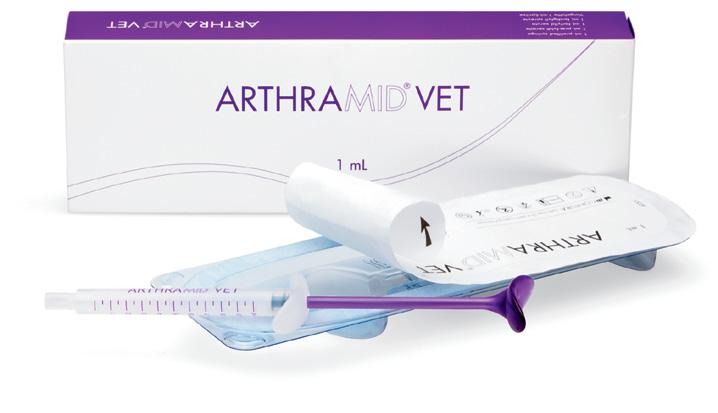
Learn more: ConturaVetUS.com.
The Trek hoof boot from Cavallo Horse & Rider is the company’s most flexible, durable, breathable, and user-friendly addition to its line of hoof boots. Trek’s honeycomb design maximizes strength and minimizes weight so horses move freely and naturally.
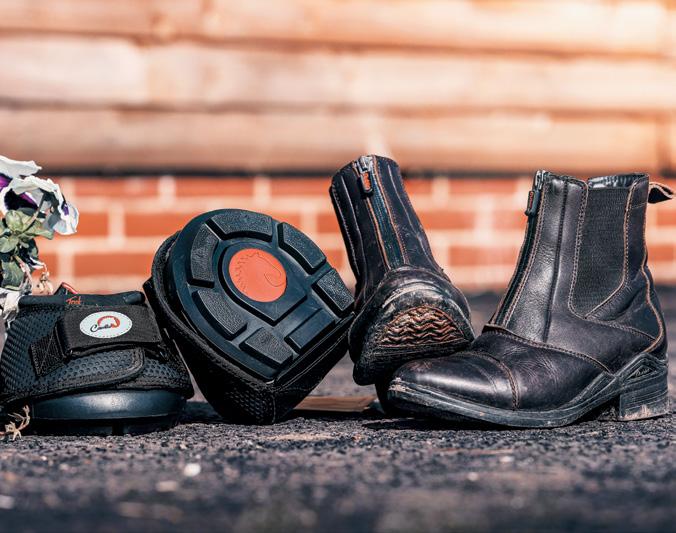
Learn more: Cavallo-Inc.com.
“Tack Shop” contains notices of new products judged to be of potential interest to USDF members. Information and images are supplied by manufacturers. Inclusion of an item does not constitute an endorsement or a product review.
USDF CONNECTION | May/June 2023 59

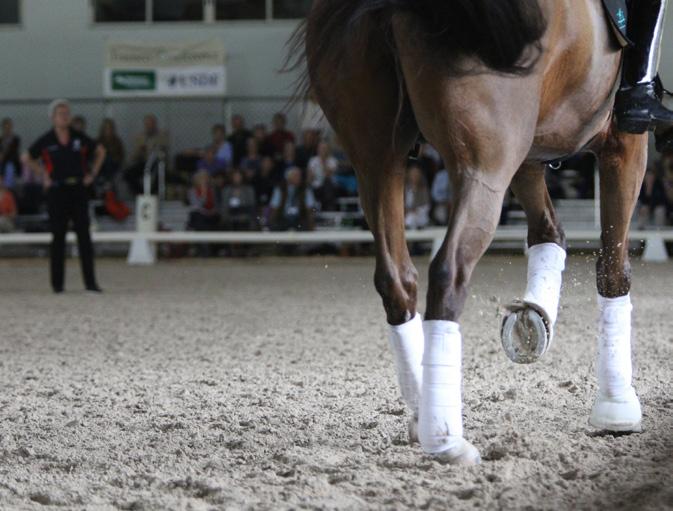
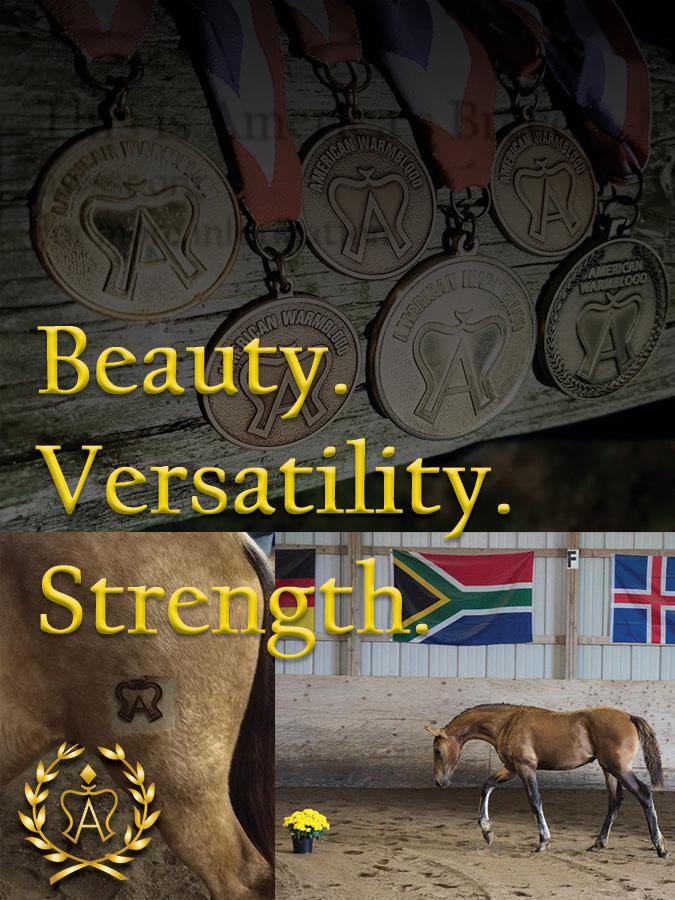


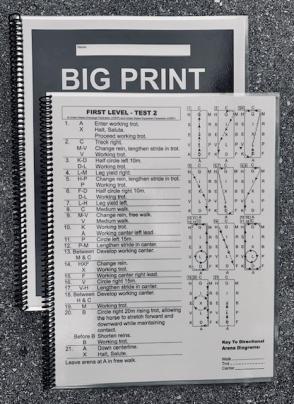







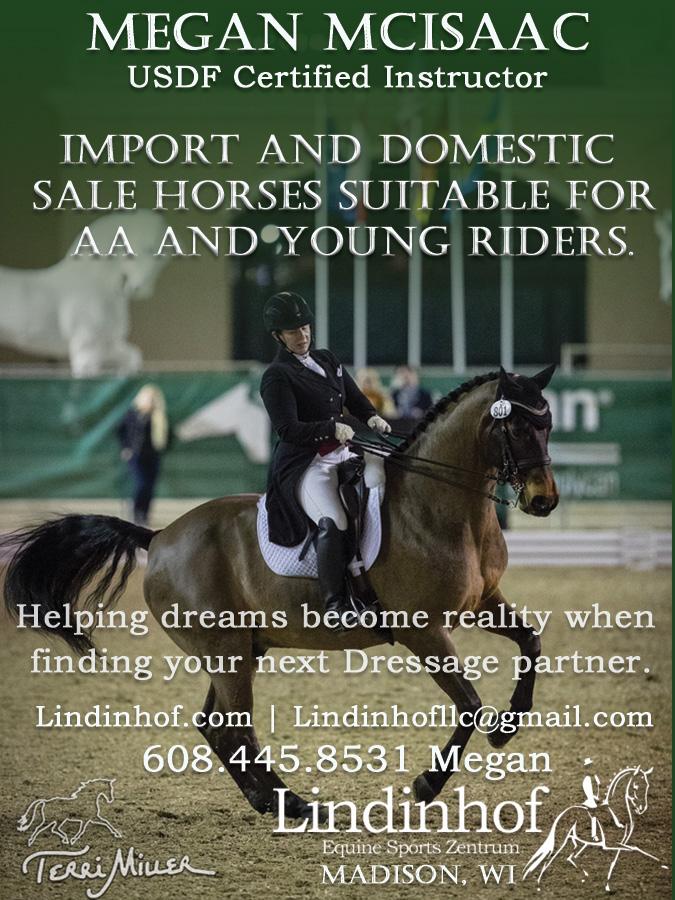
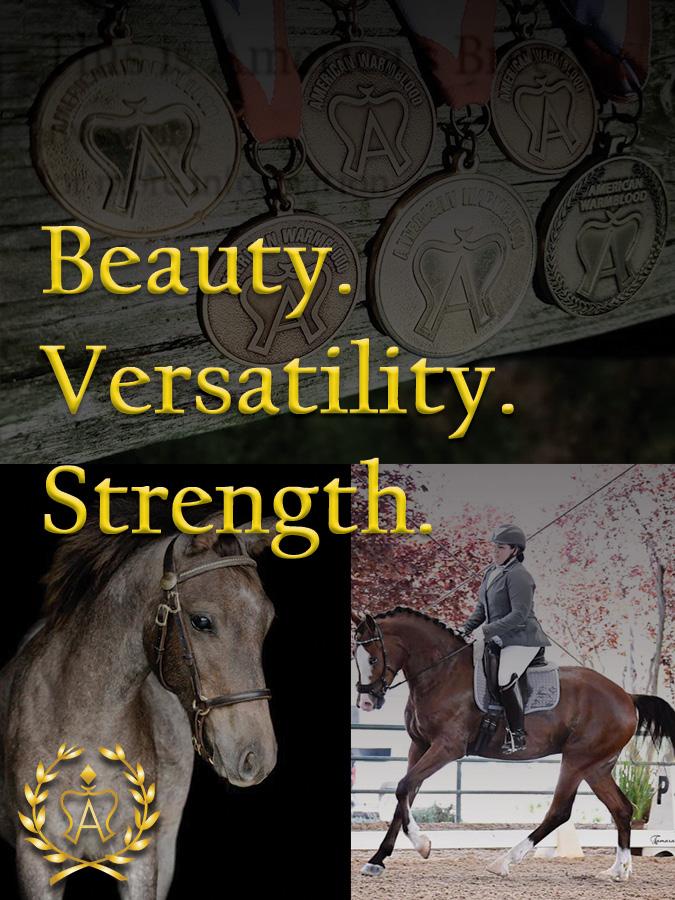



60 May/June 2023 | USDF CONNECTION RIDER'S MARKET
& ACCESORIES
BEDDING
REGISTRY BREED REGISTRY
HEALTH EDUCATION EDUCATION
TESTS T aylor S elec T H or S e B edding S elect the B e S t 815.601.3002 www.taylorselect.com call / text / email SHIPPING NATIONWIDE Mention this ad and receive $100 off of your first semi load LARGE FLAKE l BLENDED FLAKE MINI FLAKE l PINE PELLETS CHOPPED STRAW ART & DESIGN PHOTOGRAPHY
HORSES HORSE BEDDING JEWELRY
HORSES EDUCATION
APPAREL
HORSE
BREED
HORSE
DRESSAGE
SALE
SALE

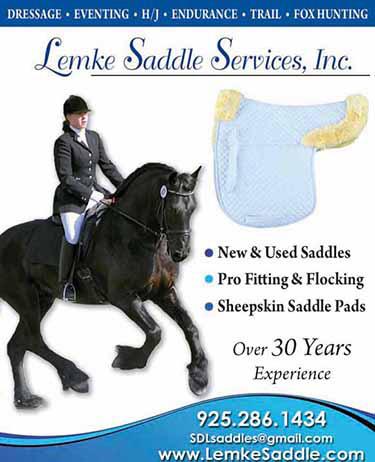



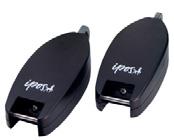


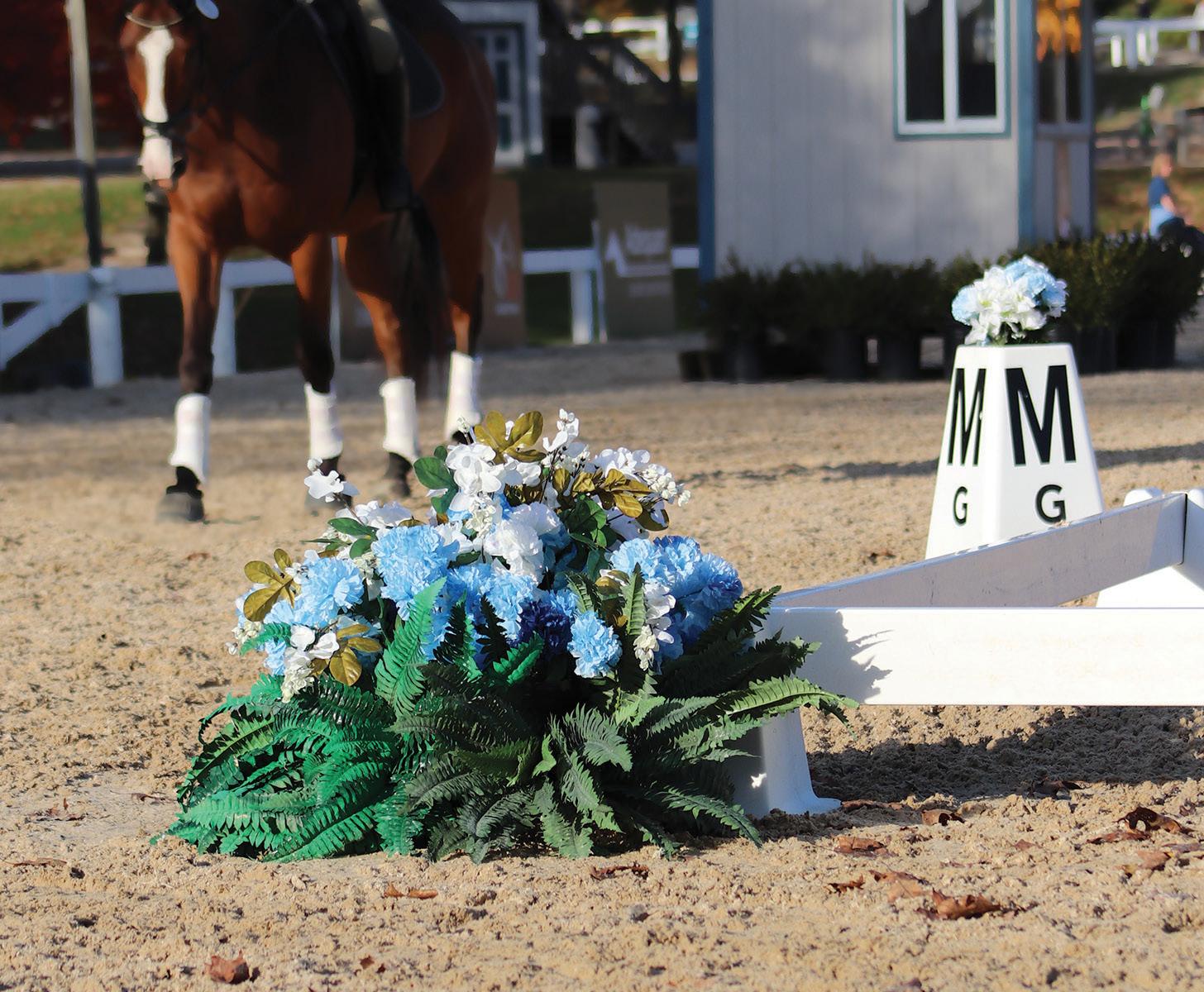
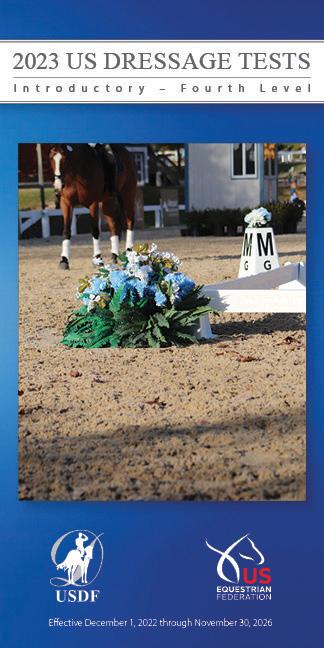
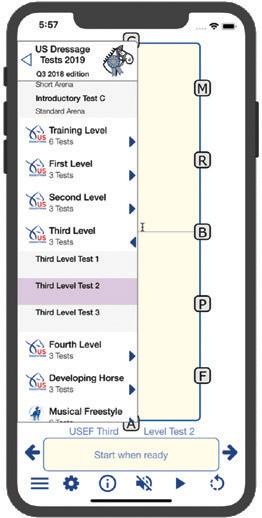

USDF CONNECTION | May/June 2023 61 Demos and more info about the FREE Online Coaches Course available on our website Achieve lightness and symmetry with the Ipos Rein Sensors, and quantify the ‘equestrian feel’! The Ipos Rein Sensors measure rein tension on the left and right side, giving equestrians insights to improve performance. www ipostechnology com TACK TACK SALE HORSES 2023 US DRESSAGE TESTS Introductory – Fourth Level
USDF
For specific staff contacts visit the USDF Web site.

USDF Connection wants YOU to be a contributor.
Here’s how.
Air Your Views
USDF Connection welcomes letters to the editor. Please send your digital submission by e-mail to jbryant@ usdf.org. Please include your hometown, state, and daytime telephone number. We’ll publish letters as space allows; all submissions are subject to editing. Unsigned letters will not be considered, although writers may request that their names be withheld. All letters become the property of USDF.
Ask a Question
Do you have a dressage- or USDFrelated question? Send it to “FAQ” and you may get an expert response in a future issue of USDF Connection.

Send your question, along with your full name, hometown, state, and daytime telephone number to editorial@usdf.org. Include “FAQ” in the subject line of your message.
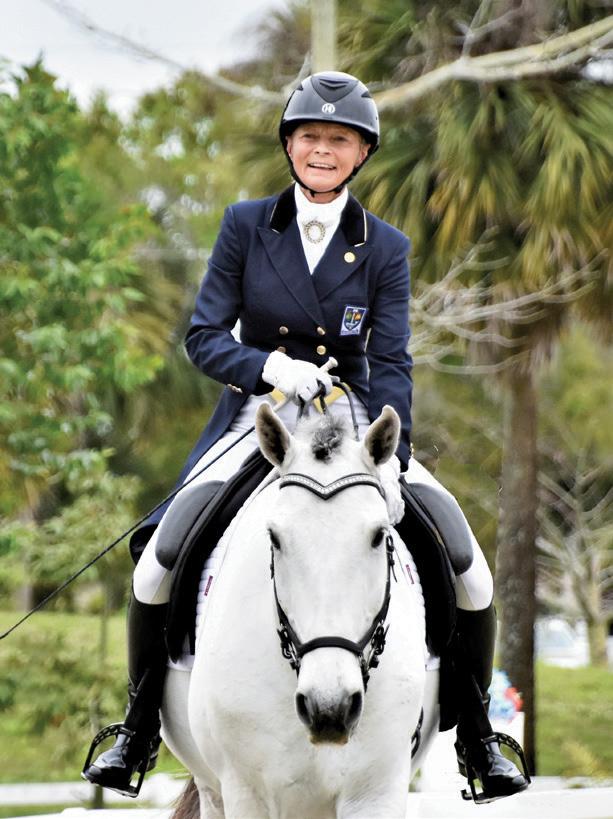
62 May/June 2023 | USDF CONNECTION NONPROFITORG. U.S.Postage PAID Dr. Hilary Clayton on Donzi MC July/August 2021 Official Publication of the United States Dressage Federation FOCUS ON HORSE HEALTH Buyer’s Guide to the Prepurchase Exam (p. 44) Handling GMO Conflict (p. 20) Raise Your Training Standards with Sue Blinks (p. 30)
MAKE THE CONNECTION
OFFICE CONTACT DIRECTORY Phone: (859) 971-2277, Fax: (859) 971-7722, E-mail: usdressage@usdf.org Accounting (859) 271-7891 accounting@usdf.org Address and E-mail Updates (859) 971-2277 changes@usdf.org Adult Education Programs ........................................................ (859) 271-7894 ......................... education@usdf.org All-Breeds Awards ....................................................................... (859) 971-7361 ............................ allbreeds@usdf.org Applications Submitted at Competitions ................................ (859) 271-7880........................... affidavits@usdf.org Breeder Championship Series (859) 271-7878 sporthorse@usdf.org Demographics and Statistics (859) 271-7083 stats@usdf.org Donations (859) 971-7826 donate@usdf.org FEI Youth Clinics (859) 971-7317 jryrclinics@usdf.org GMO Education Initiative (859) 271-7894 education@usdf.org Group Membership (859) 971-7048 gmo@usdf.org Hall of Fame and Lifetime Achievement Awards ................. (859) 271-7873 ........................ halloffame@usdf.org Horse Performance Certificates ............................................... (859) 971-7361 .......... horseperformance@usdf.org Horse Registration (859) 271-7880 horseregistration@usdf.org Human Resources/Career Opportunities (859) 271-7885 hr@usdf.org Instructor Certification (859) 271-7877 instructorcertification@usdf.org Insurance Certificates for Competitions (859) 271-7886 compins@usdf.org L Education and Continuing Education (859) 971-7039 lprogram@usdf.org Licensed Official Education (859)-271-7877 loeducation@usdf.org Mailing Lists.................................................................................... (859) 971-7038......................... mailinglist@usdf.org Musical Freestyle .......................................................................... (859) 971-7039..............musicalfreestyle@usdf.org NAYC Criteria and Procedures (859) 971-7317 nayc@usdf.org Nominations – Delegates, Regional Directors (859) 271-7897 nominations@usdf.org Participating and Business Memberships (859) 271-7871 membership@usdf.org Prize List Questions (859) 271-7896 prizelist@usdf.org Regional Championships Program (859) 271-7886 regchamps@usdf.org Rider Awards (859) 971-7361 riderawards@usdf.org Safe Sport ....................................................................................... (859)-271-7894...........................safesport@usdf.org Score Corrections......................................................................... (859) 271-7895............ scorecorrections@usdf.org Secretary/Manager Services .................................................... (859) 271-7895.................... competitions@usdf.org Show Results (859) 271-7895 results@usdf.org Sponsorship Opportunities (859) 271-7887 sponsorship@usdf.org Sport Horse Education and Programs (859) 271-7894 sporthorse@usdf.org Store Merchandise (859) 971-7828 merchandise@usdf.org University Accreditation and Credit Check (859) 271-7894 university@usdf.org USDFScores.com (859) 271-7878 reports@usdf.org USEF/USDF Dressage Seat Medal Program & Semi-Finals ...(859)-971-7886....................................... youth@usdf.org Year-End Awards .......................................................................... (859) 971-7361 ................................awards@usdf.org Young Rider Graduate Program (859) 971-7317 youth@usdf.org Youth Education and Programs (859) 971-7317 youth@usdf.org
USDF CONNECTION | May/June 2023 63 ADVERTISING INDEX Arenus.................................................................................. arenus.com ............................................... 1, 9 Auburn Laboratories Inc. auburnlabs.com 25 American Warmblood Society & Sporthorse Registry ... awssr.org ........................................................ 60 Equine Design stradi.us 60 Dressage Collections ........................................................ dressagecollections.com ......................... 21 Great American Insurance Group .................................. greatamericaninsurancegroup.com......... 7 Hilltop Farm ........................................................................ hilltopfarminc.com ......... inside front cover Illinois Dressage & Combined Training Association ...... idcta.org...........................................................30 IPOS Technology ............................................................... ipostechnology.com .................................. 61 Iron Spring Farm ................................................................ ironspringfarm.com ....... inside back cover Kentucky Performance Products kppusa.com 15 Lemke Saddle Services .................................................... lemkesaddle.com ....................................... 61 Lindinhof Equine Sports Zentrum .................................. lindinhof.com ............................................. 60 Platinum Performance ...................................................... platinumperformance.com....... back cover Rider Project ....................................................................... theriderproject.org ................................... 60 Shooting Star Farm .......................................................... shootingstarfarm.com ............................... 61 Sox For Horses ................................................................... soxforhorses.com ..................................... 29 Sporthorse Auctions.com sporthorseauctions.com 60 St. Louis Area Dressage Society .................................... slads.org ...................................................... 31 TaylorSelect Horse Bedding taylorselect.com 60 The Dehner Company ...................................................... dehner.com .............................................. 29 The Dressage Foundation ............................................... dressagefoundation.org .......................... 57 United States Lipizzan Federation ................................. uslipizzan.org ........................................... 60 USDF Adult Amateur Equitation Regional Finals 47 Adult and Youth Programs ................................................................................................................ 23 All-Breeds Participating Organizations 17 Arts Contest.......................................................................................................................................... 39 Breeders Championship Series......................................................................................................... 19 Convention ............................................................................................................................................ 16 Dressage Seat Medal Semi-Finals ................................................................................................... 55 Member Perks Partners 5 Regional Championships ............................................................................................................. 34-35 Sport Horse Education 22 Store Merchandise ............................................................................................................................... 61 University ................................................................................................................................................ 8 YourDressage.org.............................................................................................................................2, 31 United States Dressage Federation Official Page USDF Vimeo @USDF @USDFOfficial GET CONNECTED with #USDF YOUR CONNECTION TO DRESSAGE EDUCA TION • COMPETITION • ACHIEVEMENT
Down to Earth
Volunteer extraordinaire Paul Cormier keeps shows running from the ground up—literally
By Katherine Walcott
If you have been to a dressage show in New England, then you’ve probably seen Paul Cormier. He’s the one driving the tractor, setting up rings, doing what needs to be done.
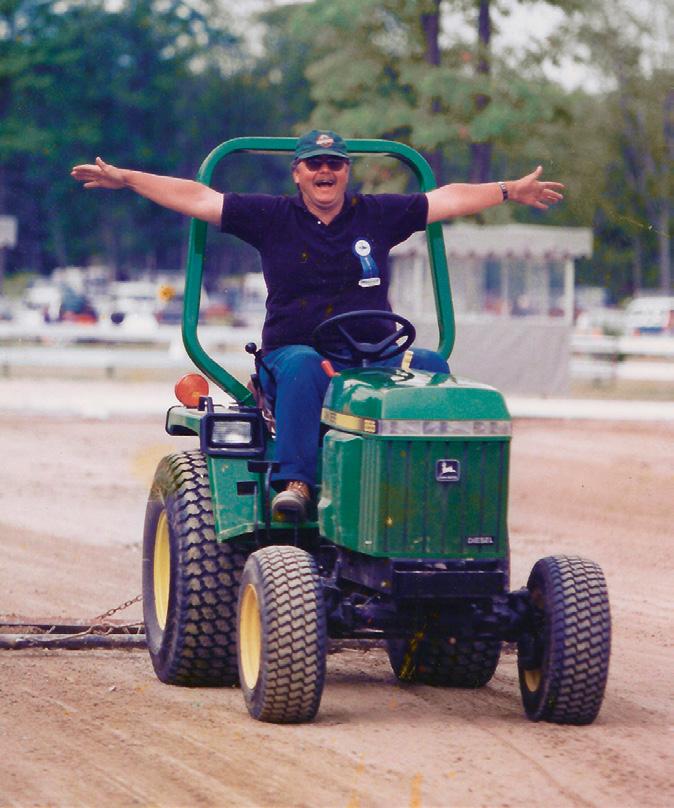
For years Cormier, of Acushnet, Massachusetts, was the grounds manager for the New England Dressage Association’s (NEDA) enormous Fall Festival competition. The man who refers to himself as “just a worker bee” currently manages the NEDA Spring Dressage Competitions, is a NEDA past
In fact, Cormier has made management of mud a point of pride. Years ago, he was at a NEDA annual banquet, listening to a presentation about the late German arena and footing expert Hermann Duckek, who was affectionately known as the Duke of Dirt.
“I said something to the effect of, ‘If that’s the case, then I must be the Marquis de Mud,’” Cormier recalls. Those being the nascent days of the internet, when Cormier created his first e-mail account, he chose MarquisDeMud as his handle.
A longtime amateur dressage rider, Cormier, 71, is now retired from a 43-year career in retail sales with Sears. He began his second career as a dressage volunteer by being, well, volunteered: He’d stopped by a dressage show to thank a friend for putting him up while he attended a USDF Adult Camp. As Cormier tells it, the friend introduced him to the NEDA Fall Festival manager with the words, “This is Paul Cormier. He’s gonna be your new grounds manager.”
themselves the Earth Angels, “she made angel costumes with big wings.”
Although Cormier has spent more time at dressage shows than many competitors, he himself doesn’t show, instead choosing to ride “for the art of dressage.” With help from the late legendary trainer Karl Mikolka, Cormier brought his 15.3-hand Oldenburg/ Thoroughbred/draft cross gelding, Johnny Walker Black, up the levels, including “FEI-level movements and airs above the ground.” A back injury has sidelined him from riding his current mount, the Dutch Warmblood Vermouth, but Cormier hopes to get back in the saddle soon.
president, and is a longtime NEDA delegate to the USDF Board of Governors, among others. In 2005, Cormier was named the USDF Volunteer of the Year in recognition of his many contributions.
Two decades later, he’s still at it.
Why? “I just like playing in the mud,” Cormier says. (It’s a good thing, too. As he quips: “How do you spell NEDA? R-A-I-N.”)
“I knew nothing about maintaining grounds or maintaining footing and everything else,” Cormier says, “but I learned quickly.” He had to: The show “was also a CDI, so we had to do drags and center lines and cross-hatches.”
Although Cormier works hard to keep shows running smoothly, he sees no reason not to have fun while doing so. Over the years, the NEDA grounds crew has gotten lots of press for its themed costumes— all made by Cormier’s mother. One year, “We were Grounds Clowns, so she made clown outfits.” The year the crew members dubbed
Beneath the wry sense of humor and the easygoing demeanor, however, is a dressage enthusiast who’s concerned about our sport’s future. Even as competitors’ expectations rise along with the costs of showing, volunteers are becoming harder to find, Cormier says; even professional show managers are getting longer in the tooth, with few younger people coming along to take their places.
Cormier lays out the situation in typical blunt fashion:
“If you want to keep having good-quality horse shows, you have to get involved other than just with your ass in the saddle.”
Katherine Walcott is an Alabamabased freelance writer who has set up a fair number of dressage arenas, but not as many as Paul Cormier.
64 May/June 2023 | USDF CONNECTION
COURTESY
Salute
OF PAUL CORMIER
DOWN AND DIRTY: NEDA’s Paul Cormier, grounds-manager expert, dubbed himself the “Marquis de Mud”

ironspringfarm.com © 2023 Iron Spring Farm, Inc., all rights reserved; Iron Spring Farm, ISF and Iron Spring Farm logo are trademarks of Iron Spring Farm, Inc. Photos by Terri Miller, Stal Larakkers Pennsylvania • Florida 610.383.4717 (8–5 EST) Breeding Sales
Apache, Pref. x Weltmeyer
Lord Sinclair x Flemmingh, Pref.
Beart 411, Sport/Pref x Ulke 338, Sport
THE POWER OF NUTRITION STARTS WITHIN.
Supporting Equine Biological Health With Advanced Nutrition
All three veterinary-developed total body wellness formulas provide omega-3 fatty acids, antioxidants, vitamins, trace minerals, amino acids and more to support your horse from head to hoof, coat to gut and everything in between.

WELLNESS + DIGESTION
Platinum Performance ® GI (Gastrointestinal)
RECOMMENDED FOR Horses in training or competition, while traveling, and for horses with digestive health concerns, occasional loose stool or difficulty maintaining weight.
TOTAL BODY WELLNESS
Platinum Performance ® Equine
RECOMMENDED FOR All types of horses, the ingredients work synergistically to support every aspect of health and performance.
WELLNESS + JOINT
Platinum Performance ® CJ (Complete Joint)
RECOMMENDED FOR Horses with advanced joint care needs, performance horses or performance horse prospects and senior horses.
PLATINUMPERFORMANCE.COM | 800-553-2400 | PLATINUM ADVISORS CAN HELP! WELLNESS PERFORMANCE CONDITIONS SAFE DURING COMPETITION SATISFACTION GUARANTEED ©2023 PLATINUM PERFORMANCE, INC











 O.
O.

 By Charlotte Trentelman, Region 3 Director
By Charlotte Trentelman, Region 3 Director







 MICHAEL BRYANT
MICHAEL BRYANT






















































 By Penny Hawes
By Penny Hawes














 BY NATALIE DEFEE MENDIK
BY NATALIE DEFEE MENDIK






















 STORY AND PHOTOGRAPHS BY JENNIFER O. BRYANT
STORY AND PHOTOGRAPHS BY JENNIFER O. BRYANT






















































